Digital Entrepreneurship: A Research Agenda on New Business Models for the Twenty-First Century
VerifiedAdded on 2022/11/25
|24
|14550
|416
AI Summary
This paper explores the state-of-the-art literature on digital entrepreneurship and provides an up-to-date compilation of key topics and methods discussed in the relevant literature. It also proposes a research map pointing at further research opportunities for scholars working in the field.
Contribute Materials
Your contribution can guide someone’s learning journey. Share your
documents today.
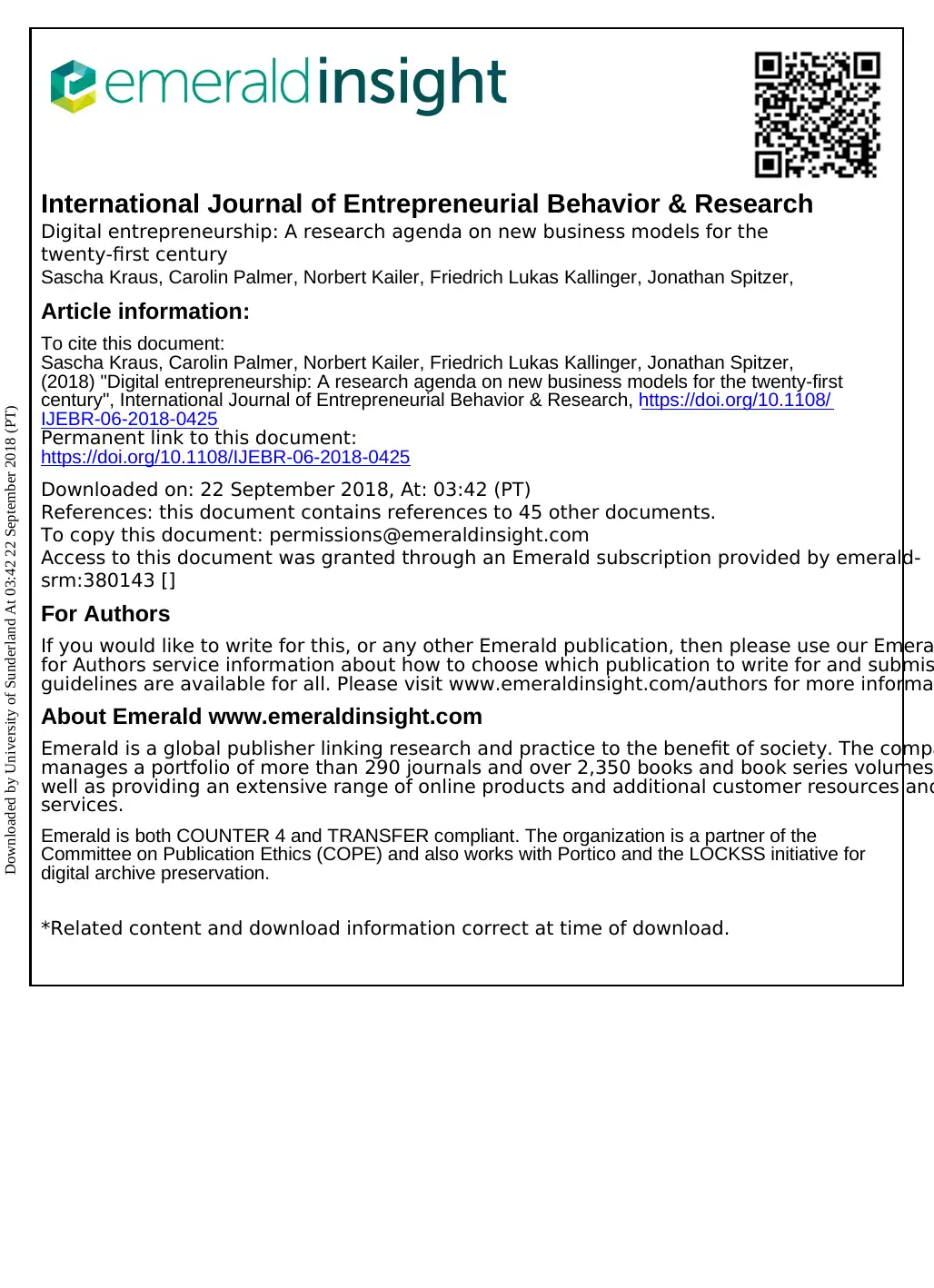
International Journal of Entrepreneurial Behavior & Research
Digital entrepreneurship: A research agenda on new business models for the
twenty-first century
Sascha Kraus, Carolin Palmer, Norbert Kailer, Friedrich Lukas Kallinger, Jonathan Spitzer,
Article information:
To cite this document:
Sascha Kraus, Carolin Palmer, Norbert Kailer, Friedrich Lukas Kallinger, Jonathan Spitzer,
(2018) "Digital entrepreneurship: A research agenda on new business models for the twenty-first
century", International Journal of Entrepreneurial Behavior & Research, https://doi.org/10.1108/
IJEBR-06-2018-0425
Permanent link to this document:
https://doi.org/10.1108/IJEBR-06-2018-0425
Downloaded on: 22 September 2018, At: 03:42 (PT)
References: this document contains references to 45 other documents.
To copy this document: permissions@emeraldinsight.com
Access to this document was granted through an Emerald subscription provided by emerald-
srm:380143 []
For Authors
If you would like to write for this, or any other Emerald publication, then please use our Emera
for Authors service information about how to choose which publication to write for and submis
guidelines are available for all. Please visit www.emeraldinsight.com/authors for more informa
About Emerald www.emeraldinsight.com
Emerald is a global publisher linking research and practice to the benefit of society. The compa
manages a portfolio of more than 290 journals and over 2,350 books and book series volumes
well as providing an extensive range of online products and additional customer resources and
services.
Emerald is both COUNTER 4 and TRANSFER compliant. The organization is a partner of the
Committee on Publication Ethics (COPE) and also works with Portico and the LOCKSS initiative for
digital archive preservation.
*Related content and download information correct at time of download.
Downloaded by University of Sunderland At 03:42 22 September 2018 (PT)
Digital entrepreneurship: A research agenda on new business models for the
twenty-first century
Sascha Kraus, Carolin Palmer, Norbert Kailer, Friedrich Lukas Kallinger, Jonathan Spitzer,
Article information:
To cite this document:
Sascha Kraus, Carolin Palmer, Norbert Kailer, Friedrich Lukas Kallinger, Jonathan Spitzer,
(2018) "Digital entrepreneurship: A research agenda on new business models for the twenty-first
century", International Journal of Entrepreneurial Behavior & Research, https://doi.org/10.1108/
IJEBR-06-2018-0425
Permanent link to this document:
https://doi.org/10.1108/IJEBR-06-2018-0425
Downloaded on: 22 September 2018, At: 03:42 (PT)
References: this document contains references to 45 other documents.
To copy this document: permissions@emeraldinsight.com
Access to this document was granted through an Emerald subscription provided by emerald-
srm:380143 []
For Authors
If you would like to write for this, or any other Emerald publication, then please use our Emera
for Authors service information about how to choose which publication to write for and submis
guidelines are available for all. Please visit www.emeraldinsight.com/authors for more informa
About Emerald www.emeraldinsight.com
Emerald is a global publisher linking research and practice to the benefit of society. The compa
manages a portfolio of more than 290 journals and over 2,350 books and book series volumes
well as providing an extensive range of online products and additional customer resources and
services.
Emerald is both COUNTER 4 and TRANSFER compliant. The organization is a partner of the
Committee on Publication Ethics (COPE) and also works with Portico and the LOCKSS initiative for
digital archive preservation.
*Related content and download information correct at time of download.
Downloaded by University of Sunderland At 03:42 22 September 2018 (PT)
Secure Best Marks with AI Grader
Need help grading? Try our AI Grader for instant feedback on your assignments.
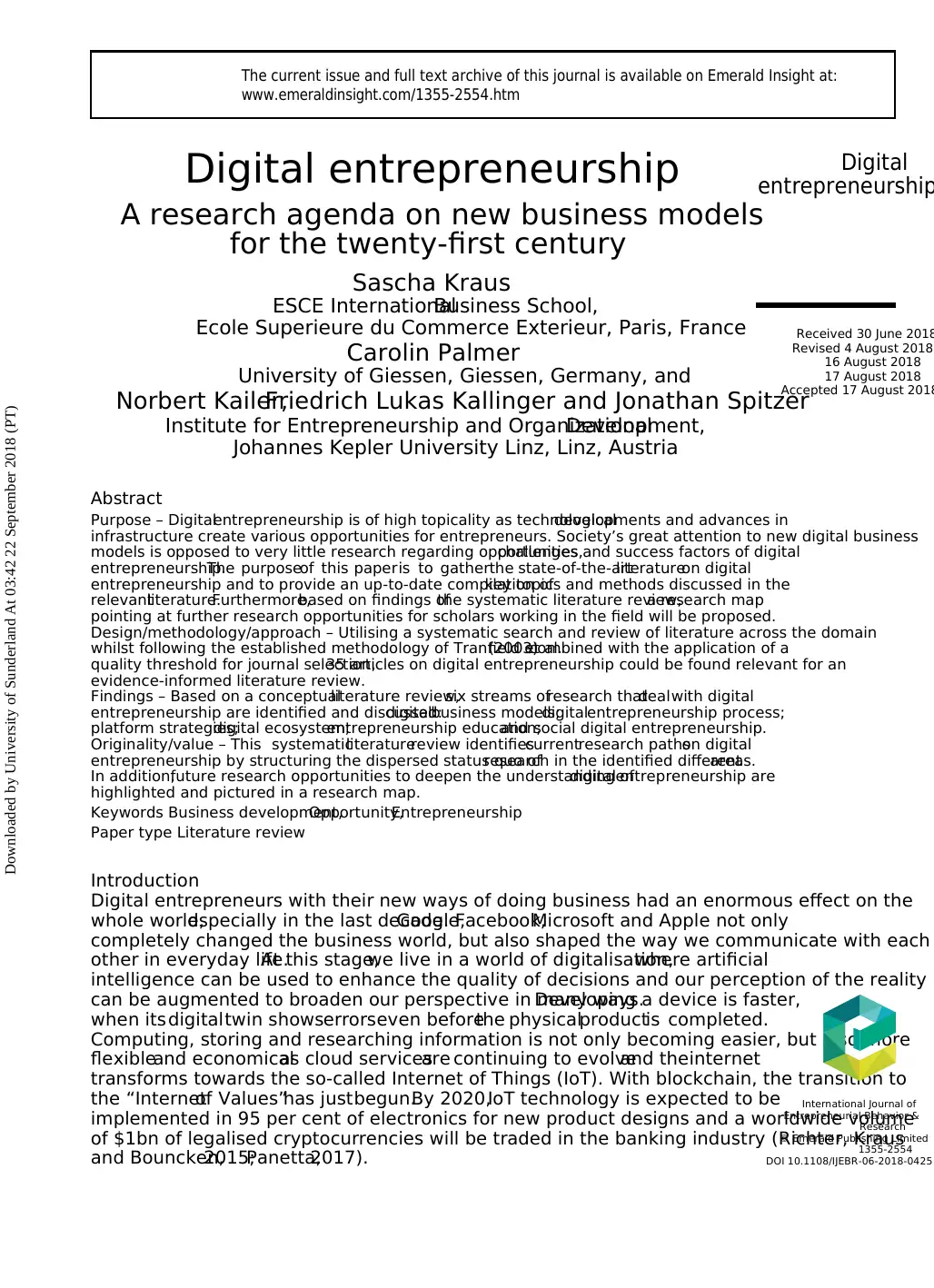
Digital entrepreneurship
A research agenda on new business models
for the twenty-first century
Sascha Kraus
ESCE InternationalBusiness School,
Ecole Superieure du Commerce Exterieur, Paris, France
Carolin Palmer
University of Giessen, Giessen, Germany, and
Norbert Kailer,Friedrich Lukas Kallinger and Jonathan Spitzer
Institute for Entrepreneurship and OrganizationalDevelopment,
Johannes Kepler University Linz, Linz, Austria
Abstract
Purpose – Digitalentrepreneurship is of high topicality as technologicaldevelopments and advances in
infrastructure create various opportunities for entrepreneurs. Society’s great attention to new digital business
models is opposed to very little research regarding opportunities,challenges and success factors of digital
entrepreneurship.The purposeof this paperis to gatherthe state-of-the-artliteratureon digital
entrepreneurship and to provide an up-to-date compilation ofkey topics and methods discussed in the
relevantliterature.Furthermore,based on findings ofthe systematic literature review,a research map
pointing at further research opportunities for scholars working in the field will be proposed.
Design/methodology/approach – Utilising a systematic search and review of literature across the domain
whilst following the established methodology of Tranfield et al.(2003)combined with the application of a
quality threshold for journal selection,35 articles on digital entrepreneurship could be found relevant for an
evidence-informed literature review.
Findings – Based on a conceptualliterature review,six streams ofresearch thatdealwith digital
entrepreneurship are identified and discussed:digitalbusiness models;digitalentrepreneurship process;
platform strategies;digital ecosystem;entrepreneurship education;and social digital entrepreneurship.
Originality/value – This systematicliteraturereview identifiescurrentresearch pathson digital
entrepreneurship by structuring the dispersed status quo ofresearch in the identified differentareas.
In addition,future research opportunities to deepen the understanding ofdigitalentrepreneurship are
highlighted and pictured in a research map.
Keywords Business development,Opportunity,Entrepreneurship
Paper type Literature review
Introduction
Digital entrepreneurs with their new ways of doing business had an enormous effect on the
whole world,especially in the last decade.Google,Facebook,Microsoft and Apple not only
completely changed the business world, but also shaped the way we communicate with each
other in everyday life.At this stage,we live in a world of digitalisation,where artificial
intelligence can be used to enhance the quality of decisions and our perception of the reality
can be augmented to broaden our perspective in many ways.Developing a device is faster,
when itsdigitaltwin showserrorseven beforethe physicalproductis completed.
Computing, storing and researching information is not only becoming easier, but also more
flexibleand economicalas cloud servicesare continuing to evolveand theinternet
transforms towards the so-called Internet of Things (IoT). With blockchain, the transition to
the “Internetof Values”has justbegun.By 2020,IoT technology is expected to be
implemented in 95 per cent of electronics for new product designs and a worldwide volume
of $1bn of legalised cryptocurrencies will be traded in the banking industry (Richter, Kraus
and Bouncken,2015;Panetta,2017).
International Journal of
Entrepreneurial Behavior &
Research
© Emerald Publishing Limited
1355-2554
DOI 10.1108/IJEBR-06-2018-0425
Received 30 June 2018
Revised 4 August 2018
16 August 2018
17 August 2018
Accepted 17 August 2018
The current issue and full text archive of this journal is available on Emerald Insight at:
www.emeraldinsight.com/1355-2554.htm
Digital
entrepreneurship
Downloaded by University of Sunderland At 03:42 22 September 2018 (PT)
A research agenda on new business models
for the twenty-first century
Sascha Kraus
ESCE InternationalBusiness School,
Ecole Superieure du Commerce Exterieur, Paris, France
Carolin Palmer
University of Giessen, Giessen, Germany, and
Norbert Kailer,Friedrich Lukas Kallinger and Jonathan Spitzer
Institute for Entrepreneurship and OrganizationalDevelopment,
Johannes Kepler University Linz, Linz, Austria
Abstract
Purpose – Digitalentrepreneurship is of high topicality as technologicaldevelopments and advances in
infrastructure create various opportunities for entrepreneurs. Society’s great attention to new digital business
models is opposed to very little research regarding opportunities,challenges and success factors of digital
entrepreneurship.The purposeof this paperis to gatherthe state-of-the-artliteratureon digital
entrepreneurship and to provide an up-to-date compilation ofkey topics and methods discussed in the
relevantliterature.Furthermore,based on findings ofthe systematic literature review,a research map
pointing at further research opportunities for scholars working in the field will be proposed.
Design/methodology/approach – Utilising a systematic search and review of literature across the domain
whilst following the established methodology of Tranfield et al.(2003)combined with the application of a
quality threshold for journal selection,35 articles on digital entrepreneurship could be found relevant for an
evidence-informed literature review.
Findings – Based on a conceptualliterature review,six streams ofresearch thatdealwith digital
entrepreneurship are identified and discussed:digitalbusiness models;digitalentrepreneurship process;
platform strategies;digital ecosystem;entrepreneurship education;and social digital entrepreneurship.
Originality/value – This systematicliteraturereview identifiescurrentresearch pathson digital
entrepreneurship by structuring the dispersed status quo ofresearch in the identified differentareas.
In addition,future research opportunities to deepen the understanding ofdigitalentrepreneurship are
highlighted and pictured in a research map.
Keywords Business development,Opportunity,Entrepreneurship
Paper type Literature review
Introduction
Digital entrepreneurs with their new ways of doing business had an enormous effect on the
whole world,especially in the last decade.Google,Facebook,Microsoft and Apple not only
completely changed the business world, but also shaped the way we communicate with each
other in everyday life.At this stage,we live in a world of digitalisation,where artificial
intelligence can be used to enhance the quality of decisions and our perception of the reality
can be augmented to broaden our perspective in many ways.Developing a device is faster,
when itsdigitaltwin showserrorseven beforethe physicalproductis completed.
Computing, storing and researching information is not only becoming easier, but also more
flexibleand economicalas cloud servicesare continuing to evolveand theinternet
transforms towards the so-called Internet of Things (IoT). With blockchain, the transition to
the “Internetof Values”has justbegun.By 2020,IoT technology is expected to be
implemented in 95 per cent of electronics for new product designs and a worldwide volume
of $1bn of legalised cryptocurrencies will be traded in the banking industry (Richter, Kraus
and Bouncken,2015;Panetta,2017).
International Journal of
Entrepreneurial Behavior &
Research
© Emerald Publishing Limited
1355-2554
DOI 10.1108/IJEBR-06-2018-0425
Received 30 June 2018
Revised 4 August 2018
16 August 2018
17 August 2018
Accepted 17 August 2018
The current issue and full text archive of this journal is available on Emerald Insight at:
www.emeraldinsight.com/1355-2554.htm
Digital
entrepreneurship
Downloaded by University of Sunderland At 03:42 22 September 2018 (PT)
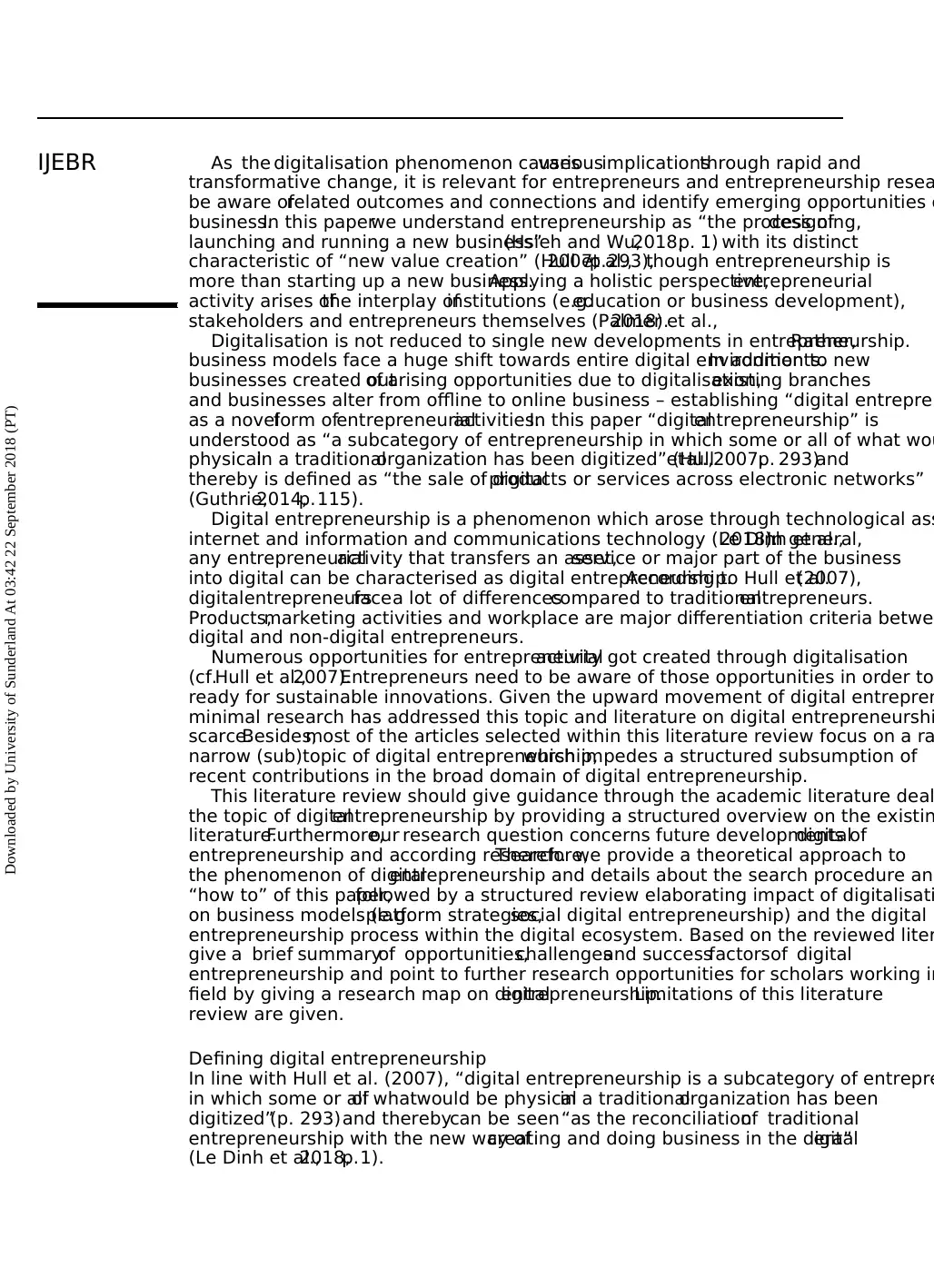
As the digitalisation phenomenon causesvariousimplicationsthrough rapid and
transformative change, it is relevant for entrepreneurs and entrepreneurship resea
be aware ofrelated outcomes and connections and identify emerging opportunities o
business.In this paperwe understand entrepreneurship as “the process ofdesigning,
launching and running a new business”(Hsieh and Wu,2018,p. 1) with its distinct
characteristic of “new value creation” (Hull et al.,2007,p.293),though entrepreneurship is
more than starting up a new business.Applying a holistic perspective,entrepreneurial
activity arises ofthe interplay ofinstitutions (e.g.education or business development),
stakeholders and entrepreneurs themselves (Palmer et al.,2018).
Digitalisation is not reduced to single new developments in entrepreneurship.Rather,
business models face a huge shift towards entire digital environments.In addition to new
businesses created outof arising opportunities due to digitalisation,existing branches
and businesses alter from offline to online business – establishing “digital entrepren
as a novelform ofentrepreneurialactivities.In this paper “digitalentrepreneurship” is
understood as “a subcategory of entrepreneurship in which some or all of what wou
physicalin a traditionalorganization has been digitized” (Hulletal.,2007,p. 293)and
thereby is defined as “the sale of digitalproducts or services across electronic networks”
(Guthrie,2014,p.115).
Digital entrepreneurship is a phenomenon which arose through technological ass
internet and information and communications technology (Le Dinh et al.,2018).In general,
any entrepreneurialactivity that transfers an asset,service or major part of the business
into digital can be characterised as digital entrepreneurship.According to Hull et al.(2007),
digitalentrepreneursfacea lot of differencescompared to traditionalentrepreneurs.
Products,marketing activities and workplace are major differentiation criteria betwe
digital and non-digital entrepreneurs.
Numerous opportunities for entrepreneurialactivity got created through digitalisation
(cf.Hull et al.,2007).Entrepreneurs need to be aware of those opportunities in order to
ready for sustainable innovations. Given the upward movement of digital entrepren
minimal research has addressed this topic and literature on digital entrepreneurshi
scarce.Besides,most of the articles selected within this literature review focus on a ra
narrow (sub)topic of digital entrepreneurship,which impedes a structured subsumption of
recent contributions in the broad domain of digital entrepreneurship.
This literature review should give guidance through the academic literature deal
the topic of digitalentrepreneurship by providing a structured overview on the existin
literature.Furthermore,our research question concerns future developments ofdigital
entrepreneurship and according research.Therefore,we provide a theoretical approach to
the phenomenon of digitalentrepreneurship and details about the search procedure and
“how to” of this paper,followed by a structured review elaborating impact of digitalisati
on business models (e.g.platform strategies,social digital entrepreneurship) and the digital
entrepreneurship process within the digital ecosystem. Based on the reviewed liter
give a brief summaryof opportunities,challengesand successfactorsof digital
entrepreneurship and point to further research opportunities for scholars working in
field by giving a research map on digitalentrepreneurship.Limitations of this literature
review are given.
Defining digital entrepreneurship
In line with Hull et al. (2007), “digital entrepreneurship is a subcategory of entrepre
in which some or allof whatwould be physicalin a traditionalorganization has been
digitized”(p. 293)and therebycan be seen“as the reconciliationof traditional
entrepreneurship with the new way ofcreating and doing business in the digitalera”
(Le Dinh et al.,2018,p.1).
IJEBR
Downloaded by University of Sunderland At 03:42 22 September 2018 (PT)
transformative change, it is relevant for entrepreneurs and entrepreneurship resea
be aware ofrelated outcomes and connections and identify emerging opportunities o
business.In this paperwe understand entrepreneurship as “the process ofdesigning,
launching and running a new business”(Hsieh and Wu,2018,p. 1) with its distinct
characteristic of “new value creation” (Hull et al.,2007,p.293),though entrepreneurship is
more than starting up a new business.Applying a holistic perspective,entrepreneurial
activity arises ofthe interplay ofinstitutions (e.g.education or business development),
stakeholders and entrepreneurs themselves (Palmer et al.,2018).
Digitalisation is not reduced to single new developments in entrepreneurship.Rather,
business models face a huge shift towards entire digital environments.In addition to new
businesses created outof arising opportunities due to digitalisation,existing branches
and businesses alter from offline to online business – establishing “digital entrepren
as a novelform ofentrepreneurialactivities.In this paper “digitalentrepreneurship” is
understood as “a subcategory of entrepreneurship in which some or all of what wou
physicalin a traditionalorganization has been digitized” (Hulletal.,2007,p. 293)and
thereby is defined as “the sale of digitalproducts or services across electronic networks”
(Guthrie,2014,p.115).
Digital entrepreneurship is a phenomenon which arose through technological ass
internet and information and communications technology (Le Dinh et al.,2018).In general,
any entrepreneurialactivity that transfers an asset,service or major part of the business
into digital can be characterised as digital entrepreneurship.According to Hull et al.(2007),
digitalentrepreneursfacea lot of differencescompared to traditionalentrepreneurs.
Products,marketing activities and workplace are major differentiation criteria betwe
digital and non-digital entrepreneurs.
Numerous opportunities for entrepreneurialactivity got created through digitalisation
(cf.Hull et al.,2007).Entrepreneurs need to be aware of those opportunities in order to
ready for sustainable innovations. Given the upward movement of digital entrepren
minimal research has addressed this topic and literature on digital entrepreneurshi
scarce.Besides,most of the articles selected within this literature review focus on a ra
narrow (sub)topic of digital entrepreneurship,which impedes a structured subsumption of
recent contributions in the broad domain of digital entrepreneurship.
This literature review should give guidance through the academic literature deal
the topic of digitalentrepreneurship by providing a structured overview on the existin
literature.Furthermore,our research question concerns future developments ofdigital
entrepreneurship and according research.Therefore,we provide a theoretical approach to
the phenomenon of digitalentrepreneurship and details about the search procedure and
“how to” of this paper,followed by a structured review elaborating impact of digitalisati
on business models (e.g.platform strategies,social digital entrepreneurship) and the digital
entrepreneurship process within the digital ecosystem. Based on the reviewed liter
give a brief summaryof opportunities,challengesand successfactorsof digital
entrepreneurship and point to further research opportunities for scholars working in
field by giving a research map on digitalentrepreneurship.Limitations of this literature
review are given.
Defining digital entrepreneurship
In line with Hull et al. (2007), “digital entrepreneurship is a subcategory of entrepre
in which some or allof whatwould be physicalin a traditionalorganization has been
digitized”(p. 293)and therebycan be seen“as the reconciliationof traditional
entrepreneurship with the new way ofcreating and doing business in the digitalera”
(Le Dinh et al.,2018,p.1).
IJEBR
Downloaded by University of Sunderland At 03:42 22 September 2018 (PT)
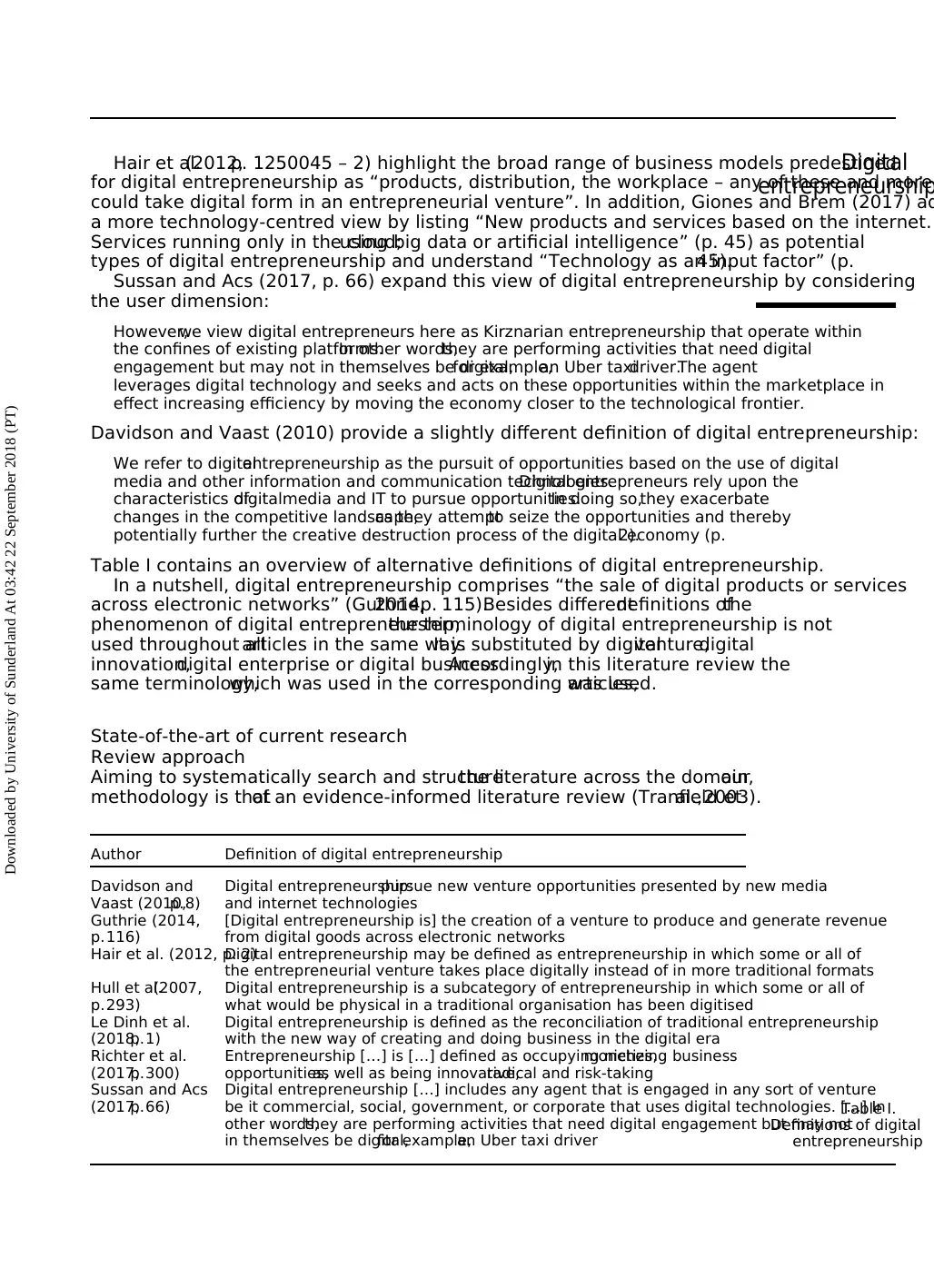
Hair et al.(2012,p. 1250045 – 2) highlight the broad range of business models predestined
for digital entrepreneurship as “products, distribution, the workplace – any of these and more
could take digital form in an entrepreneurial venture”. In addition, Giones and Brem (2017) ad
a more technology-centred view by listing “New products and services based on the internet.
Services running only in the cloud;using big data or artificial intelligence” (p. 45) as potential
types of digital entrepreneurship and understand “Technology as an input factor” (p.45).
Sussan and Acs (2017, p. 66) expand this view of digital entrepreneurship by considering
the user dimension:
However,we view digital entrepreneurs here as Kirznarian entrepreneurship that operate within
the confines of existing platforms.In other words,they are performing activities that need digital
engagement but may not in themselves be digital,for example,an Uber taxidriver.The agent
leverages digital technology and seeks and acts on these opportunities within the marketplace in
effect increasing efficiency by moving the economy closer to the technological frontier.
Davidson and Vaast (2010) provide a slightly different definition of digital entrepreneurship:
We refer to digitalentrepreneurship as the pursuit of opportunities based on the use of digital
media and other information and communication technologies.Digital entrepreneurs rely upon the
characteristics ofdigitalmedia and IT to pursue opportunities.In doing so,they exacerbate
changes in the competitive landscape,as they attemptto seize the opportunities and thereby
potentially further the creative destruction process of the digital economy (p.2).
Table I contains an overview of alternative definitions of digital entrepreneurship.
In a nutshell, digital entrepreneurship comprises “the sale of digital products or services
across electronic networks” (Guthrie,2014,p. 115).Besides differentdefinitions ofthe
phenomenon of digital entrepreneurship,the terminology of digital entrepreneurship is not
used throughout allarticles in the same way.It is substituted by digitalventure,digital
innovation,digital enterprise or digital business.Accordingly,in this literature review the
same terminology,which was used in the corresponding articles,was used.
State-of-the-art of current research
Review approach
Aiming to systematically search and structurethe literature across the domain,our
methodology is thatof an evidence-informed literature review (Tranfield etal.,2003).
Author Definition of digital entrepreneurship
Davidson and
Vaast (2010,p.8)
Digital entrepreneurship:pursue new venture opportunities presented by new media
and internet technologies
Guthrie (2014,
p.116)
[Digital entrepreneurship is] the creation of a venture to produce and generate revenue
from digital goods across electronic networks
Hair et al. (2012, p. 2)Digital entrepreneurship may be defined as entrepreneurship in which some or all of
the entrepreneurial venture takes place digitally instead of in more traditional formats
Hull et al.(2007,
p.293)
Digital entrepreneurship is a subcategory of entrepreneurship in which some or all of
what would be physical in a traditional organisation has been digitised
Le Dinh et al.
(2018,p.1)
Digital entrepreneurship is defined as the reconciliation of traditional entrepreneurship
with the new way of creating and doing business in the digital era
Richter et al.
(2017,p.300)
Entrepreneurship […] is […] defined as occupying niches,monetizing business
opportunities,as well as being innovative,radical and risk-taking
Sussan and Acs
(2017,p.66)
Digital entrepreneurship […] includes any agent that is engaged in any sort of venture
be it commercial, social, government, or corporate that uses digital technologies. […] In
other words,they are performing activities that need digital engagement but may not
in themselves be digital,for example,an Uber taxi driver
Table I.
Definitions of digital
entrepreneurship
Digital
entrepreneurship
Downloaded by University of Sunderland At 03:42 22 September 2018 (PT)
for digital entrepreneurship as “products, distribution, the workplace – any of these and more
could take digital form in an entrepreneurial venture”. In addition, Giones and Brem (2017) ad
a more technology-centred view by listing “New products and services based on the internet.
Services running only in the cloud;using big data or artificial intelligence” (p. 45) as potential
types of digital entrepreneurship and understand “Technology as an input factor” (p.45).
Sussan and Acs (2017, p. 66) expand this view of digital entrepreneurship by considering
the user dimension:
However,we view digital entrepreneurs here as Kirznarian entrepreneurship that operate within
the confines of existing platforms.In other words,they are performing activities that need digital
engagement but may not in themselves be digital,for example,an Uber taxidriver.The agent
leverages digital technology and seeks and acts on these opportunities within the marketplace in
effect increasing efficiency by moving the economy closer to the technological frontier.
Davidson and Vaast (2010) provide a slightly different definition of digital entrepreneurship:
We refer to digitalentrepreneurship as the pursuit of opportunities based on the use of digital
media and other information and communication technologies.Digital entrepreneurs rely upon the
characteristics ofdigitalmedia and IT to pursue opportunities.In doing so,they exacerbate
changes in the competitive landscape,as they attemptto seize the opportunities and thereby
potentially further the creative destruction process of the digital economy (p.2).
Table I contains an overview of alternative definitions of digital entrepreneurship.
In a nutshell, digital entrepreneurship comprises “the sale of digital products or services
across electronic networks” (Guthrie,2014,p. 115).Besides differentdefinitions ofthe
phenomenon of digital entrepreneurship,the terminology of digital entrepreneurship is not
used throughout allarticles in the same way.It is substituted by digitalventure,digital
innovation,digital enterprise or digital business.Accordingly,in this literature review the
same terminology,which was used in the corresponding articles,was used.
State-of-the-art of current research
Review approach
Aiming to systematically search and structurethe literature across the domain,our
methodology is thatof an evidence-informed literature review (Tranfield etal.,2003).
Author Definition of digital entrepreneurship
Davidson and
Vaast (2010,p.8)
Digital entrepreneurship:pursue new venture opportunities presented by new media
and internet technologies
Guthrie (2014,
p.116)
[Digital entrepreneurship is] the creation of a venture to produce and generate revenue
from digital goods across electronic networks
Hair et al. (2012, p. 2)Digital entrepreneurship may be defined as entrepreneurship in which some or all of
the entrepreneurial venture takes place digitally instead of in more traditional formats
Hull et al.(2007,
p.293)
Digital entrepreneurship is a subcategory of entrepreneurship in which some or all of
what would be physical in a traditional organisation has been digitised
Le Dinh et al.
(2018,p.1)
Digital entrepreneurship is defined as the reconciliation of traditional entrepreneurship
with the new way of creating and doing business in the digital era
Richter et al.
(2017,p.300)
Entrepreneurship […] is […] defined as occupying niches,monetizing business
opportunities,as well as being innovative,radical and risk-taking
Sussan and Acs
(2017,p.66)
Digital entrepreneurship […] includes any agent that is engaged in any sort of venture
be it commercial, social, government, or corporate that uses digital technologies. […] In
other words,they are performing activities that need digital engagement but may not
in themselves be digital,for example,an Uber taxi driver
Table I.
Definitions of digital
entrepreneurship
Digital
entrepreneurship
Downloaded by University of Sunderland At 03:42 22 September 2018 (PT)
Secure Best Marks with AI Grader
Need help grading? Try our AI Grader for instant feedback on your assignments.
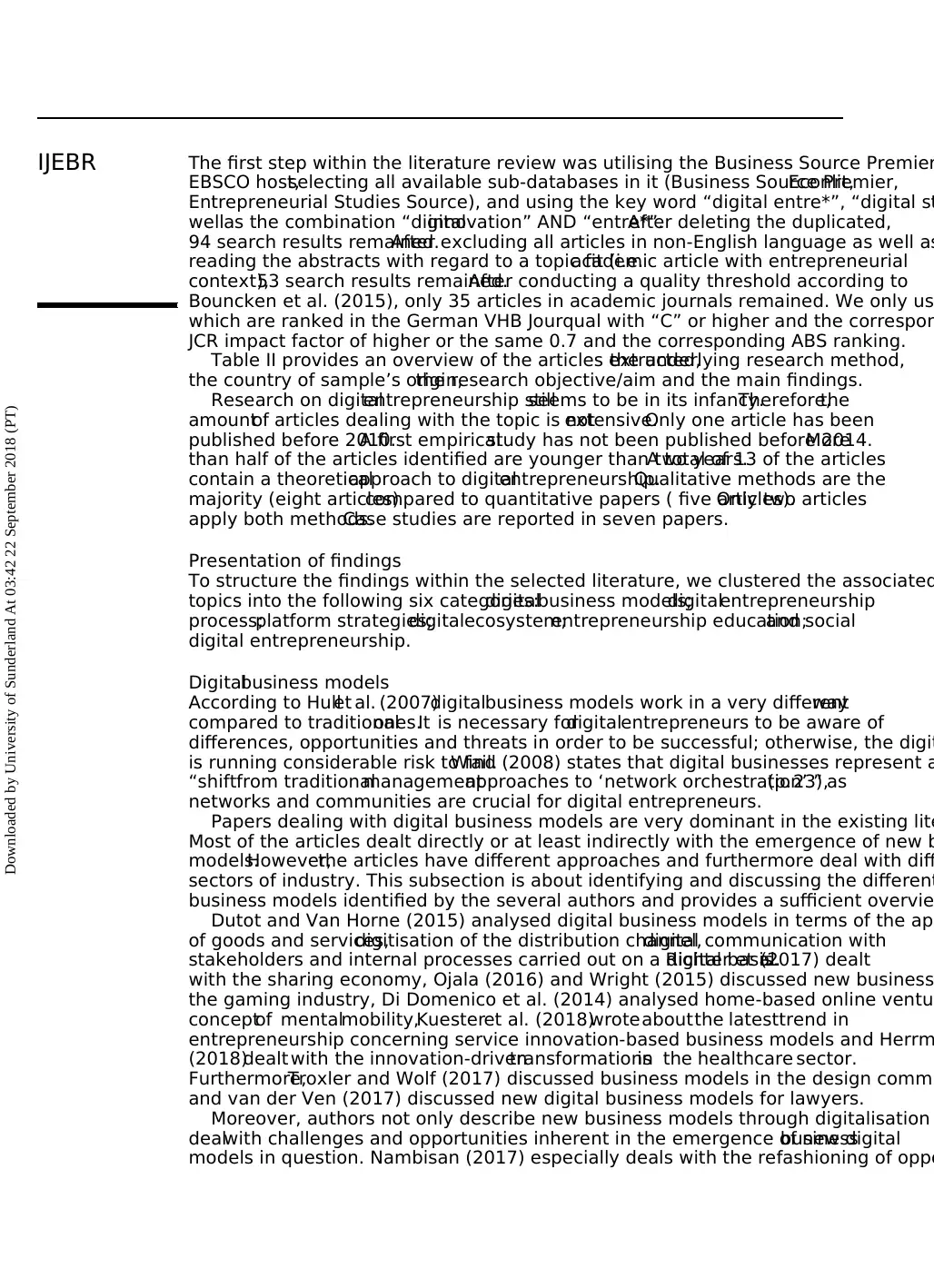
The first step within the literature review was utilising the Business Source Premier
EBSCO host,selecting all available sub-databases in it (Business Source Premier,Econlit,
Entrepreneurial Studies Source), and using the key word “digital entre*”, “digital st
wellas the combination “digitalinnovation” AND “entre*”.After deleting the duplicated,
94 search results remained.After excluding all articles in non-English language as well as
reading the abstracts with regard to a topic fit (i.e.academic article with entrepreneurial
context),53 search results remained.After conducting a quality threshold according to
Bouncken et al. (2015), only 35 articles in academic journals remained. We only us
which are ranked in the German VHB Jourqual with “C” or higher and the correspon
JCR impact factor of higher or the same 0.7 and the corresponding ABS ranking.
Table II provides an overview of the articles extracted,the underlying research method,
the country of sample’s origin,the research objective/aim and the main findings.
Research on digitalentrepreneurship stillseems to be in its infancy.Therefore,the
amountof articles dealing with the topic is notextensive.Only one article has been
published before 2010.A first empiricalstudy has not been published before 2014.More
than half of the articles identified are younger than two years.A total of 13 of the articles
contain a theoreticalapproach to digitalentrepreneurship.Qualitative methods are the
majority (eight articles)compared to quantitative papers ( five articles).Only two articles
apply both methods.Case studies are reported in seven papers.
Presentation of findings
To structure the findings within the selected literature, we clustered the associated
topics into the following six categories:digitalbusiness models;digitalentrepreneurship
process;platform strategies;digitalecosystem;entrepreneurship education;and social
digital entrepreneurship.
Digitalbusiness models
According to Hullet al. (2007)digitalbusiness models work in a very differentway
compared to traditionalones.It is necessary fordigitalentrepreneurs to be aware of
differences, opportunities and threats in order to be successful; otherwise, the digit
is running considerable risk to fail.Wind (2008) states that digital businesses represent a
“shiftfrom traditionalmanagementapproaches to ‘network orchestration’ ”(p. 23),as
networks and communities are crucial for digital entrepreneurs.
Papers dealing with digital business models are very dominant in the existing lite
Most of the articles dealt directly or at least indirectly with the emergence of new b
models.However,the articles have different approaches and furthermore deal with diff
sectors of industry. This subsection is about identifying and discussing the different
business models identified by the several authors and provides a sufficient overvie
Dutot and Van Horne (2015) analysed digital business models in terms of the ap
of goods and services,digitisation of the distribution channel,digital communication with
stakeholders and internal processes carried out on a digital basis.Richter et al.(2017) dealt
with the sharing economy, Ojala (2016) and Wright (2015) discussed new business
the gaming industry, Di Domenico et al. (2014) analysed home-based online ventu
conceptof mentalmobility,Kuesteret al. (2018)wroteaboutthe latesttrend in
entrepreneurship concerning service innovation-based business models and Herrm
(2018)dealt with the innovation-driventransformationsin the healthcare sector.
Furthermore,Troxler and Wolf (2017) discussed business models in the design commu
and van der Ven (2017) discussed new digital business models for lawyers.
Moreover, authors not only describe new business models through digitalisation
dealwith challenges and opportunities inherent in the emergence of new digitalbusiness
models in question. Nambisan (2017) especially deals with the refashioning of oppo
IJEBR
Downloaded by University of Sunderland At 03:42 22 September 2018 (PT)
EBSCO host,selecting all available sub-databases in it (Business Source Premier,Econlit,
Entrepreneurial Studies Source), and using the key word “digital entre*”, “digital st
wellas the combination “digitalinnovation” AND “entre*”.After deleting the duplicated,
94 search results remained.After excluding all articles in non-English language as well as
reading the abstracts with regard to a topic fit (i.e.academic article with entrepreneurial
context),53 search results remained.After conducting a quality threshold according to
Bouncken et al. (2015), only 35 articles in academic journals remained. We only us
which are ranked in the German VHB Jourqual with “C” or higher and the correspon
JCR impact factor of higher or the same 0.7 and the corresponding ABS ranking.
Table II provides an overview of the articles extracted,the underlying research method,
the country of sample’s origin,the research objective/aim and the main findings.
Research on digitalentrepreneurship stillseems to be in its infancy.Therefore,the
amountof articles dealing with the topic is notextensive.Only one article has been
published before 2010.A first empiricalstudy has not been published before 2014.More
than half of the articles identified are younger than two years.A total of 13 of the articles
contain a theoreticalapproach to digitalentrepreneurship.Qualitative methods are the
majority (eight articles)compared to quantitative papers ( five articles).Only two articles
apply both methods.Case studies are reported in seven papers.
Presentation of findings
To structure the findings within the selected literature, we clustered the associated
topics into the following six categories:digitalbusiness models;digitalentrepreneurship
process;platform strategies;digitalecosystem;entrepreneurship education;and social
digital entrepreneurship.
Digitalbusiness models
According to Hullet al. (2007)digitalbusiness models work in a very differentway
compared to traditionalones.It is necessary fordigitalentrepreneurs to be aware of
differences, opportunities and threats in order to be successful; otherwise, the digit
is running considerable risk to fail.Wind (2008) states that digital businesses represent a
“shiftfrom traditionalmanagementapproaches to ‘network orchestration’ ”(p. 23),as
networks and communities are crucial for digital entrepreneurs.
Papers dealing with digital business models are very dominant in the existing lite
Most of the articles dealt directly or at least indirectly with the emergence of new b
models.However,the articles have different approaches and furthermore deal with diff
sectors of industry. This subsection is about identifying and discussing the different
business models identified by the several authors and provides a sufficient overvie
Dutot and Van Horne (2015) analysed digital business models in terms of the ap
of goods and services,digitisation of the distribution channel,digital communication with
stakeholders and internal processes carried out on a digital basis.Richter et al.(2017) dealt
with the sharing economy, Ojala (2016) and Wright (2015) discussed new business
the gaming industry, Di Domenico et al. (2014) analysed home-based online ventu
conceptof mentalmobility,Kuesteret al. (2018)wroteaboutthe latesttrend in
entrepreneurship concerning service innovation-based business models and Herrm
(2018)dealt with the innovation-driventransformationsin the healthcare sector.
Furthermore,Troxler and Wolf (2017) discussed business models in the design commu
and van der Ven (2017) discussed new digital business models for lawyers.
Moreover, authors not only describe new business models through digitalisation
dealwith challenges and opportunities inherent in the emergence of new digitalbusiness
models in question. Nambisan (2017) especially deals with the refashioning of oppo
IJEBR
Downloaded by University of Sunderland At 03:42 22 September 2018 (PT)
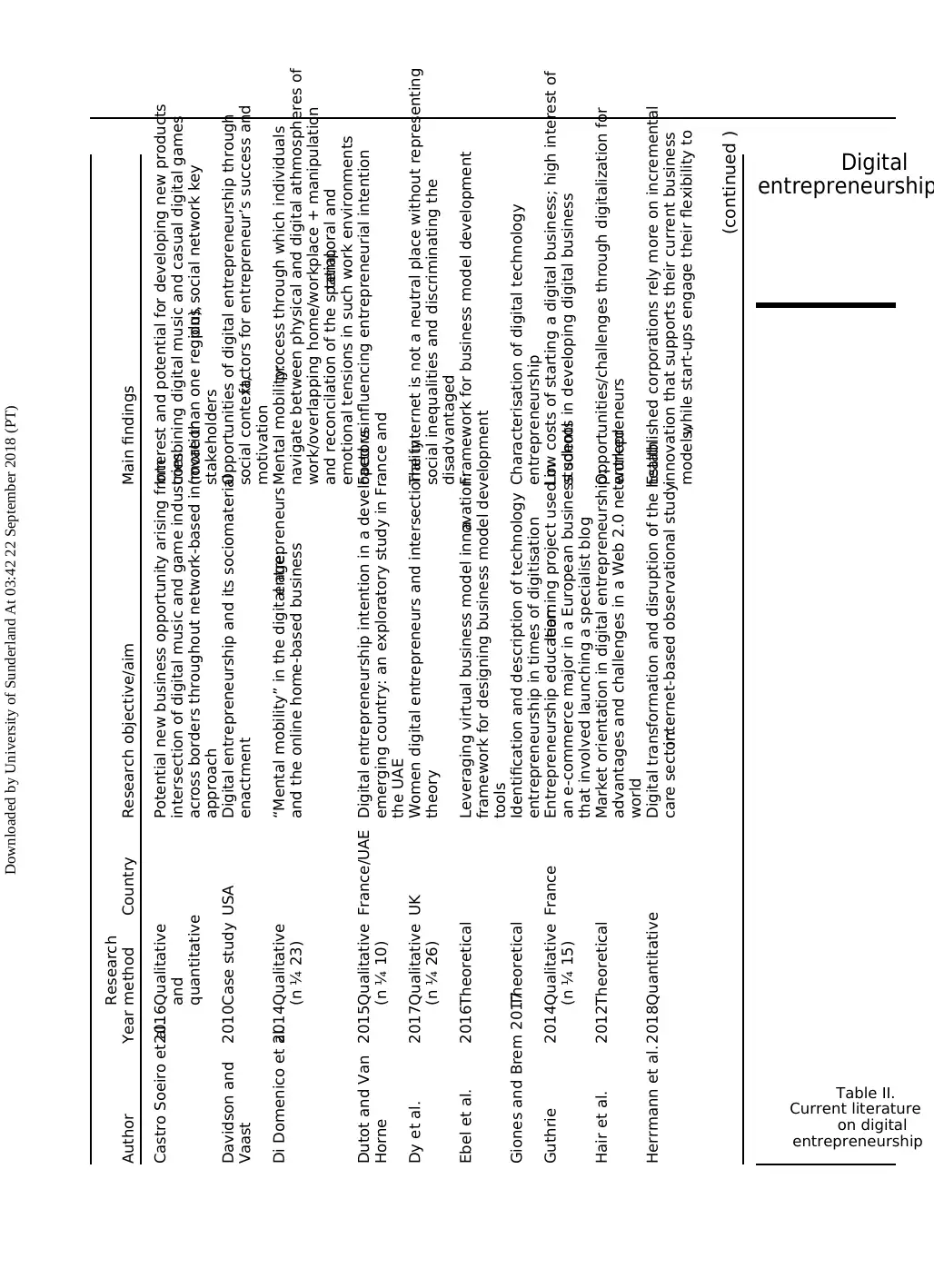
Author Year
Research
method Country Research objective/aim Main findings
Castro Soeiro et al.2016Qualitative
and
quantitative
Potential new business opportunity arising from
intersection of digital music and game industries
across borders throughout network-based innovation
approach
Interest and potential for developing new products
combining digital music and casual digital games
(more than one region),plus social network key
stakeholders
Davidson and
Vaast
2010Case study USA Digital entrepreneurship and its sociomaterial
enactment
Opportunities of digital entrepreneurship through
social context,factors for entrepreneur’s success and
motivation
Di Domenico et al.2014Qualitative
(n ¼ 23)
“Mental mobility” in the digital age:entrepreneurs
and the online home-based business
Mental mobility:process through which individuals
navigate between physical and digital athmospheres of
work/overlapping home/workplace + manipulation
and reconcilation of the spatial,temporal and
emotional tensions in such work environments
Dutot and Van
Horne
2015Qualitative
(n ¼ 10)
France/UAE Digital entrepreneurship intention in a developed vs
emerging country: an exploratory study in France and
the UAE
Factors influencing entrepreneurial intention
Dy et al. 2017Qualitative
(n ¼ 26)
UK Women digital entrepreneurs and intersectionality
theory
The internet is not a neutral place without representing
social inequalities and discriminating the
disadvantaged
Ebel et al. 2016Theoretical Leveraging virtual business model innovation:a
framework for designing business model development
tools
Framework for business model development
Giones and Brem 2017Theoretical Identification and description of technology
entrepreneurship in times of digitisation
Characterisation of digital technology
entrepreneurship
Guthrie 2014Qualitative
(n ¼ 15)
France Entrepreneurship education:learning project used in
an e-commerce major in a European business school
that involved launching a specialist blog
Low costs of starting a digital business; high interest of
students in developing digital business
Hair et al. 2012Theoretical Market orientation in digital entrepreneurship:
advantages and challenges in a Web 2.0 networked
world
Opportunities/challenges through digitalization for
entrepreneurs
Herrmann et al. 2018Quantitative Digital transformation and disruption of the health
care sector:internet-based observational study
Established corporations rely more on incremental
innovation that supports their current business
models,while start-ups engage their flexibility to
(continued )
Table II.
Current literature
on digital
entrepreneurship
Digital
entrepreneurship
Downloaded by University of Sunderland At 03:42 22 September 2018 (PT)
Research
method Country Research objective/aim Main findings
Castro Soeiro et al.2016Qualitative
and
quantitative
Potential new business opportunity arising from
intersection of digital music and game industries
across borders throughout network-based innovation
approach
Interest and potential for developing new products
combining digital music and casual digital games
(more than one region),plus social network key
stakeholders
Davidson and
Vaast
2010Case study USA Digital entrepreneurship and its sociomaterial
enactment
Opportunities of digital entrepreneurship through
social context,factors for entrepreneur’s success and
motivation
Di Domenico et al.2014Qualitative
(n ¼ 23)
“Mental mobility” in the digital age:entrepreneurs
and the online home-based business
Mental mobility:process through which individuals
navigate between physical and digital athmospheres of
work/overlapping home/workplace + manipulation
and reconcilation of the spatial,temporal and
emotional tensions in such work environments
Dutot and Van
Horne
2015Qualitative
(n ¼ 10)
France/UAE Digital entrepreneurship intention in a developed vs
emerging country: an exploratory study in France and
the UAE
Factors influencing entrepreneurial intention
Dy et al. 2017Qualitative
(n ¼ 26)
UK Women digital entrepreneurs and intersectionality
theory
The internet is not a neutral place without representing
social inequalities and discriminating the
disadvantaged
Ebel et al. 2016Theoretical Leveraging virtual business model innovation:a
framework for designing business model development
tools
Framework for business model development
Giones and Brem 2017Theoretical Identification and description of technology
entrepreneurship in times of digitisation
Characterisation of digital technology
entrepreneurship
Guthrie 2014Qualitative
(n ¼ 15)
France Entrepreneurship education:learning project used in
an e-commerce major in a European business school
that involved launching a specialist blog
Low costs of starting a digital business; high interest of
students in developing digital business
Hair et al. 2012Theoretical Market orientation in digital entrepreneurship:
advantages and challenges in a Web 2.0 networked
world
Opportunities/challenges through digitalization for
entrepreneurs
Herrmann et al. 2018Quantitative Digital transformation and disruption of the health
care sector:internet-based observational study
Established corporations rely more on incremental
innovation that supports their current business
models,while start-ups engage their flexibility to
(continued )
Table II.
Current literature
on digital
entrepreneurship
Digital
entrepreneurship
Downloaded by University of Sunderland At 03:42 22 September 2018 (PT)
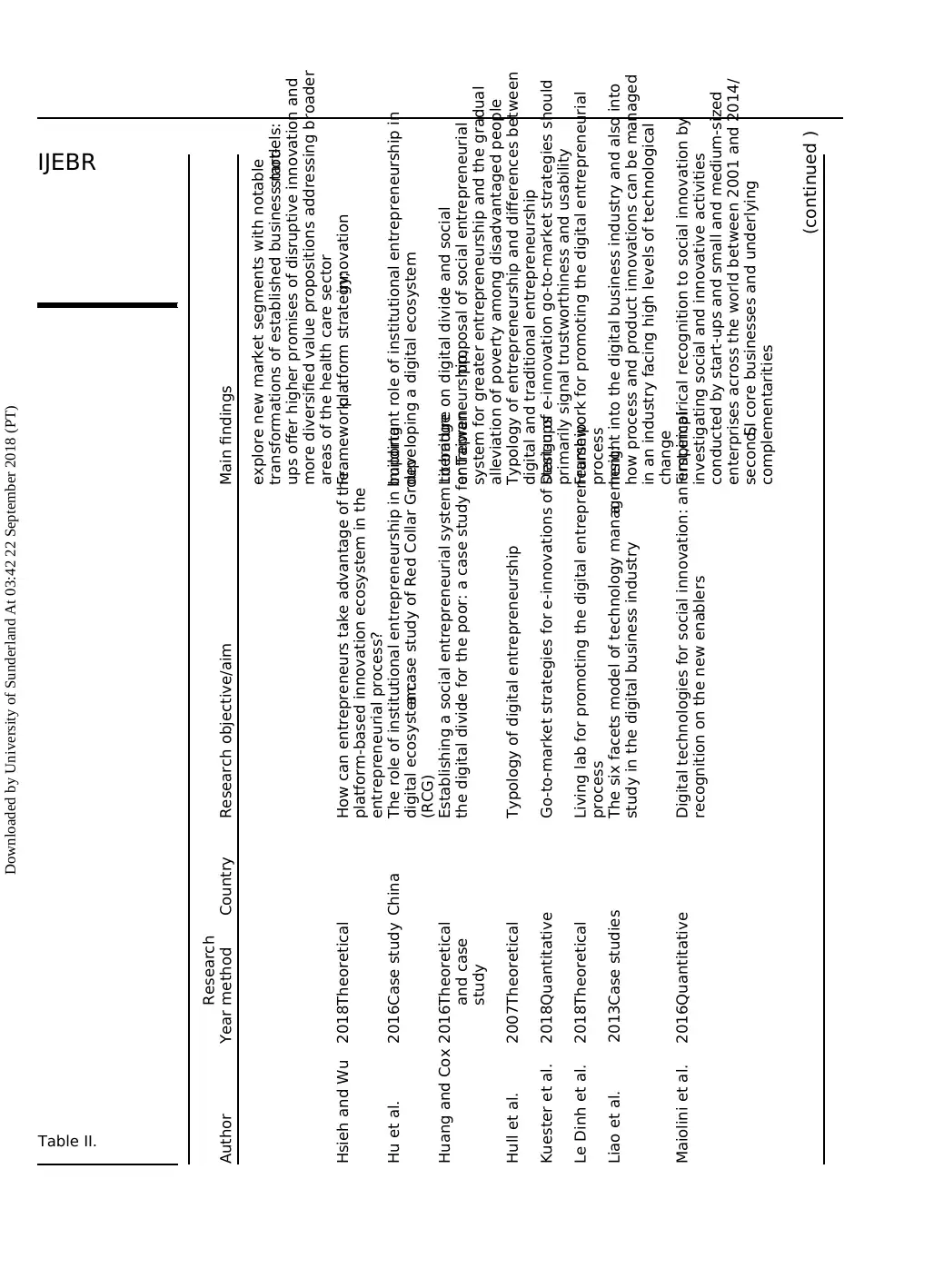
Author Year
Research
method Country Research objective/aim Main findings
explore new market segments with notable
transformations of established business models:start-
ups offer higher promises of disruptive innovation and
more diversified value propositions addressing broader
areas of the health care sector
Hsieh and Wu 2018Theoretical How can entrepreneurs take advantage of the
platform-based innovation ecosystem in the
entrepreneurial process?
Framework:platform strategy;innovation
Hu et al. 2016Case study China The role of institutional entrepreneurship in building
digital ecosystem:a case study of Red Collar Group
(RCG)
Important role of institutional entrepreneurship in
developing a digital ecosystem
Huang and Cox 2016Theoretical
and case
study
Establishing a social entrepreneurial system to bridge
the digital divide for the poor: a case study for Taiwan
Literature on digital divide and social
entrepreneurship,proposal of social entrepreneurial
system for greater entrepreneurship and the gradual
alleviation of poverty among disadvantaged people
Hull et al. 2007Theoretical Typology of digital entrepreneurship Typology of entrepreneurship and differences between
digital and traditional entrepreneurship
Kuester et al. 2018Quantitative Go-to-market strategies for e-innovations of start-upsDesign of e-innovation go-to-market strategies should
primarily signal trustworthiness and usability
Le Dinh et al. 2018Theoretical Living lab for promoting the digital entrepreneurship
process
Framework for promoting the digital entrepreneurial
process
Liao et al. 2013Case studies The six facets model of technology management:a
study in the digital business industry
Insight into the digital business industry and also into
how process and product innovations can be managed
in an industry facing high levels of technological
change
Maiolini et al. 2016Quantitative Digital technologies for social innovation: an empirical
recognition on the new enablers
First,empirical recognition to social innovation by
investigating social and innovative activities
conducted by start-ups and small and medium-sized
enterprises across the world between 2001 and 2014/
second,SI core businesses and underlying
complementarities
(continued )
Table II.
IJEBR
Downloaded by University of Sunderland At 03:42 22 September 2018 (PT)
Research
method Country Research objective/aim Main findings
explore new market segments with notable
transformations of established business models:start-
ups offer higher promises of disruptive innovation and
more diversified value propositions addressing broader
areas of the health care sector
Hsieh and Wu 2018Theoretical How can entrepreneurs take advantage of the
platform-based innovation ecosystem in the
entrepreneurial process?
Framework:platform strategy;innovation
Hu et al. 2016Case study China The role of institutional entrepreneurship in building
digital ecosystem:a case study of Red Collar Group
(RCG)
Important role of institutional entrepreneurship in
developing a digital ecosystem
Huang and Cox 2016Theoretical
and case
study
Establishing a social entrepreneurial system to bridge
the digital divide for the poor: a case study for Taiwan
Literature on digital divide and social
entrepreneurship,proposal of social entrepreneurial
system for greater entrepreneurship and the gradual
alleviation of poverty among disadvantaged people
Hull et al. 2007Theoretical Typology of digital entrepreneurship Typology of entrepreneurship and differences between
digital and traditional entrepreneurship
Kuester et al. 2018Quantitative Go-to-market strategies for e-innovations of start-upsDesign of e-innovation go-to-market strategies should
primarily signal trustworthiness and usability
Le Dinh et al. 2018Theoretical Living lab for promoting the digital entrepreneurship
process
Framework for promoting the digital entrepreneurial
process
Liao et al. 2013Case studies The six facets model of technology management:a
study in the digital business industry
Insight into the digital business industry and also into
how process and product innovations can be managed
in an industry facing high levels of technological
change
Maiolini et al. 2016Quantitative Digital technologies for social innovation: an empirical
recognition on the new enablers
First,empirical recognition to social innovation by
investigating social and innovative activities
conducted by start-ups and small and medium-sized
enterprises across the world between 2001 and 2014/
second,SI core businesses and underlying
complementarities
(continued )
Table II.
IJEBR
Downloaded by University of Sunderland At 03:42 22 September 2018 (PT)
Paraphrase This Document
Need a fresh take? Get an instant paraphrase of this document with our AI Paraphraser
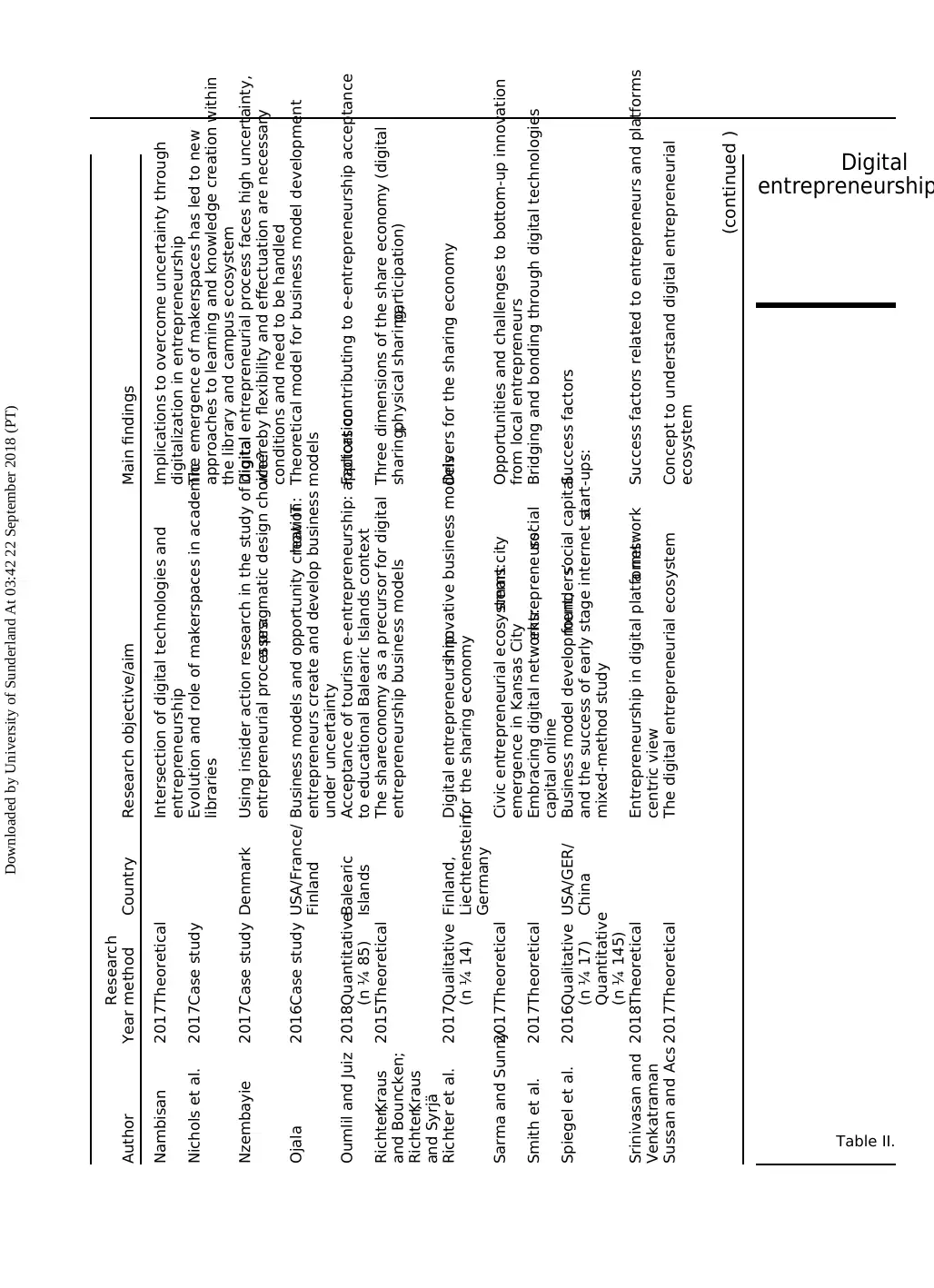
Author Year
Research
method Country Research objective/aim Main findings
Nambisan 2017Theoretical Intersection of digital technologies and
entrepreneurship
Implications to overcome uncertainty through
digitalization in entrepreneurship
Nichols et al. 2017Case study Evolution and role of makerspaces in academic
libraries
The emergence of makerspaces has led to new
approaches to learning and knowledge creation within
the library and campus ecosystem
Nzembayie 2017Case study Denmark Using insider action research in the study of digital
entrepreneurial processes:a pragmatic design choice?
Digital entrepreneurial process faces high uncertainty,
whereby flexibility and effectuation are necessary
conditions and need to be handled
Ojala 2016Case study USA/France/
Finland
Business models and opportunity creation:how IT
entrepreneurs create and develop business models
under uncertainty
Theoretical model for business model development
Oumlil and Juiz 2018Quantitative
(n ¼ 85)
Balearic
Islands
Acceptance of tourism e-entrepreneurship: application
to educational Balearic Islands context
Factors contributing to e-entrepreneurship acceptance
Richter,Kraus
and Bouncken;
Richter,Kraus
and Syrjä
2015Theoretical The shareconomy as a precursor for digital
entrepreneurship business models
Three dimensions of the share economy (digital
sharing,physical sharing,participation)
Richter et al. 2017Qualitative
(n ¼ 14)
Finland,
Liechtenstein,
Germany
Digital entrepreneurship:innovative business models
for the sharing economy
Drivers for the sharing economy
Sarma and Sunny2017Theoretical Civic entrepreneurial ecosystems:smart city
emergence in Kansas City
Opportunities and challenges to bottom-up innovation
from local entrepreneurs
Smith et al. 2017Theoretical Embracing digital networks:entrepreneurs’social
capital online
Bridging and bonding through digital technologies
Spiegel et al. 2016Qualitative
(n ¼ 17)
Quantitative
(n ¼ 145)
USA/GER/
China
Business model development,founders’social capital
and the success of early stage internet start-ups:a
mixed-method study
Success factors
Srinivasan and
Venkatraman
2018Theoretical Entrepreneurship in digital platforms:a network
centric view
Success factors related to entrepreneurs and platforms
Sussan and Acs 2017Theoretical The digital entrepreneurial ecosystem Concept to understand digital entrepreneurial
ecosystem
(continued )
Table II.
Digital
entrepreneurship
Downloaded by University of Sunderland At 03:42 22 September 2018 (PT)
Research
method Country Research objective/aim Main findings
Nambisan 2017Theoretical Intersection of digital technologies and
entrepreneurship
Implications to overcome uncertainty through
digitalization in entrepreneurship
Nichols et al. 2017Case study Evolution and role of makerspaces in academic
libraries
The emergence of makerspaces has led to new
approaches to learning and knowledge creation within
the library and campus ecosystem
Nzembayie 2017Case study Denmark Using insider action research in the study of digital
entrepreneurial processes:a pragmatic design choice?
Digital entrepreneurial process faces high uncertainty,
whereby flexibility and effectuation are necessary
conditions and need to be handled
Ojala 2016Case study USA/France/
Finland
Business models and opportunity creation:how IT
entrepreneurs create and develop business models
under uncertainty
Theoretical model for business model development
Oumlil and Juiz 2018Quantitative
(n ¼ 85)
Balearic
Islands
Acceptance of tourism e-entrepreneurship: application
to educational Balearic Islands context
Factors contributing to e-entrepreneurship acceptance
Richter,Kraus
and Bouncken;
Richter,Kraus
and Syrjä
2015Theoretical The shareconomy as a precursor for digital
entrepreneurship business models
Three dimensions of the share economy (digital
sharing,physical sharing,participation)
Richter et al. 2017Qualitative
(n ¼ 14)
Finland,
Liechtenstein,
Germany
Digital entrepreneurship:innovative business models
for the sharing economy
Drivers for the sharing economy
Sarma and Sunny2017Theoretical Civic entrepreneurial ecosystems:smart city
emergence in Kansas City
Opportunities and challenges to bottom-up innovation
from local entrepreneurs
Smith et al. 2017Theoretical Embracing digital networks:entrepreneurs’social
capital online
Bridging and bonding through digital technologies
Spiegel et al. 2016Qualitative
(n ¼ 17)
Quantitative
(n ¼ 145)
USA/GER/
China
Business model development,founders’social capital
and the success of early stage internet start-ups:a
mixed-method study
Success factors
Srinivasan and
Venkatraman
2018Theoretical Entrepreneurship in digital platforms:a network
centric view
Success factors related to entrepreneurs and platforms
Sussan and Acs 2017Theoretical The digital entrepreneurial ecosystem Concept to understand digital entrepreneurial
ecosystem
(continued )
Table II.
Digital
entrepreneurship
Downloaded by University of Sunderland At 03:42 22 September 2018 (PT)
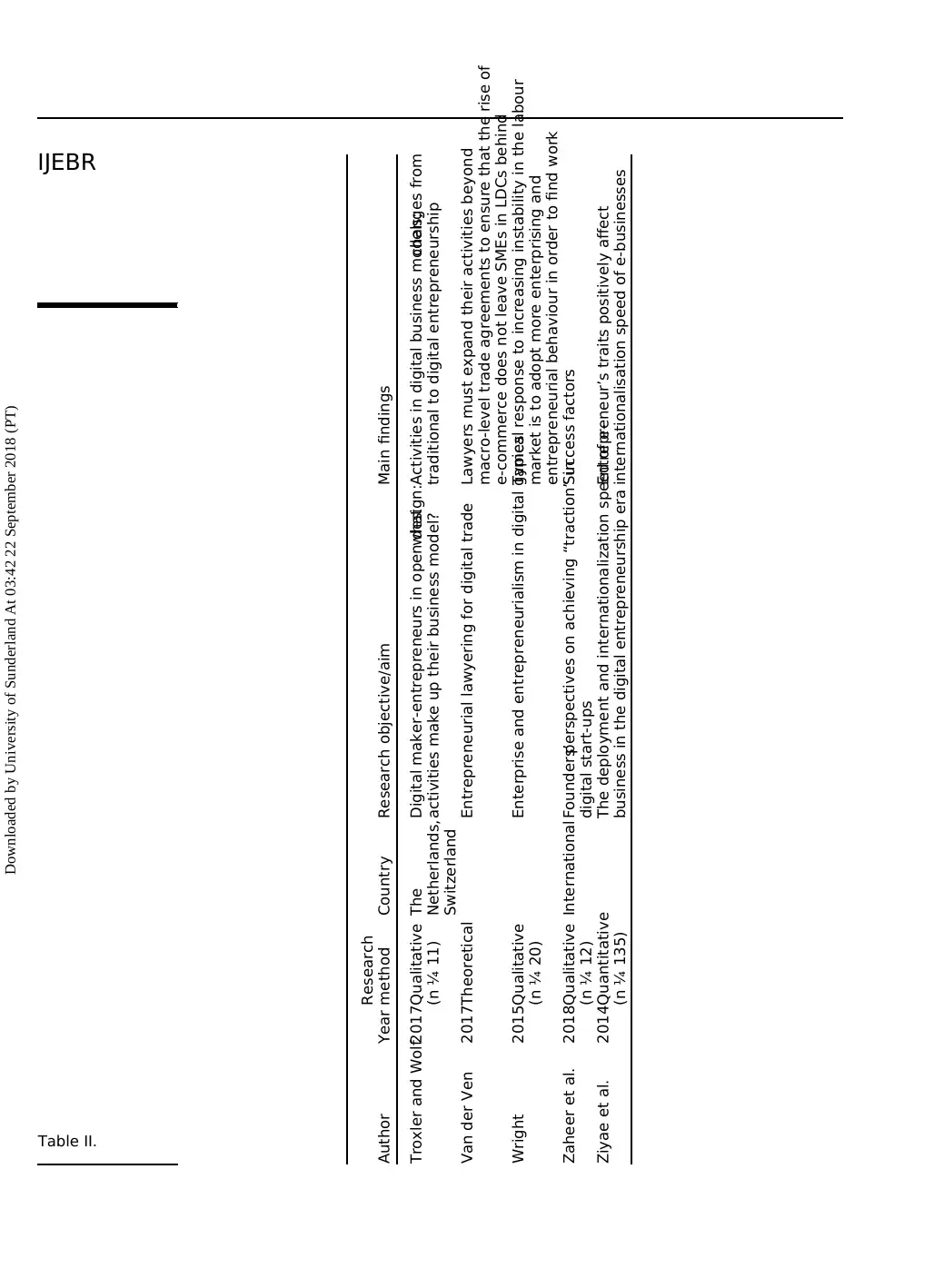
Author Year
Research
method Country Research objective/aim Main findings
Troxler and Wolf2017Qualitative
(n ¼ 11)
The
Netherlands,
Switzerland
Digital maker-entrepreneurs in open design:what
activities make up their business model?
Activities in digital business models;changes from
traditional to digital entrepreneurship
Van der Ven 2017Theoretical Entrepreneurial lawyering for digital trade Lawyers must expand their activities beyond
macro-level trade agreements to ensure that the rise of
e-commerce does not leave SMEs in LDCs behind
Wright 2015Qualitative
(n ¼ 20)
Enterprise and entrepreneurialism in digital gamesTypical response to increasing instability in the labour
market is to adopt more enterprising and
entrepreneurial behaviour in order to find work
Zaheer et al. 2018Qualitative
(n ¼ 12)
International Founders’perspectives on achieving “traction” in
digital start-ups
Success factors
Ziyae et al. 2014Quantitative
(n ¼ 135)
The deployment and internationalization speed of e-
business in the digital entrepreneurship era
Entrepreneur’s traits positively affect
internationalisation speed of e-businesses
Table II.
IJEBR
Downloaded by University of Sunderland At 03:42 22 September 2018 (PT)
Research
method Country Research objective/aim Main findings
Troxler and Wolf2017Qualitative
(n ¼ 11)
The
Netherlands,
Switzerland
Digital maker-entrepreneurs in open design:what
activities make up their business model?
Activities in digital business models;changes from
traditional to digital entrepreneurship
Van der Ven 2017Theoretical Entrepreneurial lawyering for digital trade Lawyers must expand their activities beyond
macro-level trade agreements to ensure that the rise of
e-commerce does not leave SMEs in LDCs behind
Wright 2015Qualitative
(n ¼ 20)
Enterprise and entrepreneurialism in digital gamesTypical response to increasing instability in the labour
market is to adopt more enterprising and
entrepreneurial behaviour in order to find work
Zaheer et al. 2018Qualitative
(n ¼ 12)
International Founders’perspectives on achieving “traction” in
digital start-ups
Success factors
Ziyae et al. 2014Quantitative
(n ¼ 135)
The deployment and internationalization speed of e-
business in the digital entrepreneurship era
Entrepreneur’s traits positively affect
internationalisation speed of e-businesses
Table II.
IJEBR
Downloaded by University of Sunderland At 03:42 22 September 2018 (PT)
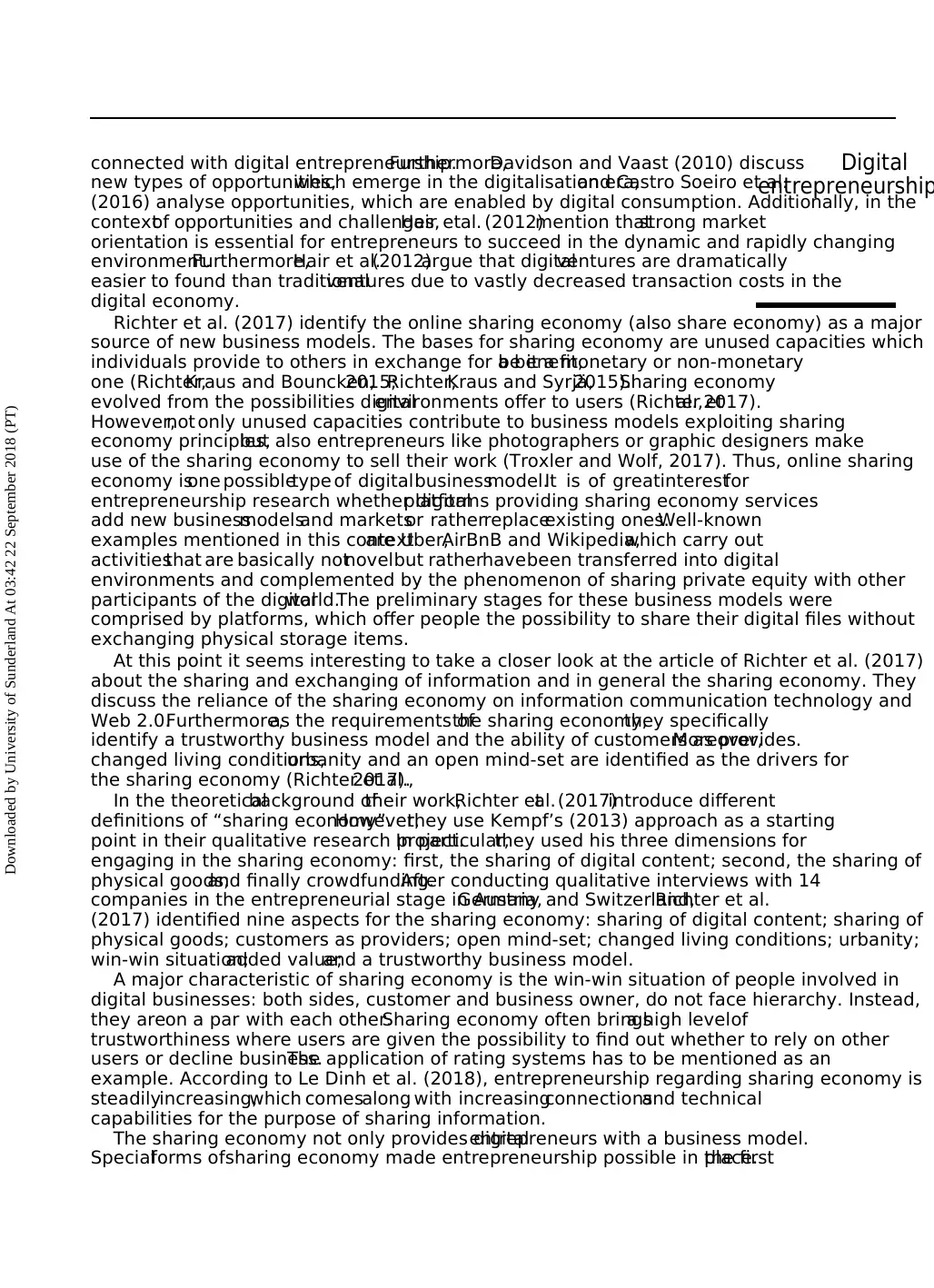
connected with digital entrepreneurship.Furthermore,Davidson and Vaast (2010) discuss
new types of opportunities,which emerge in the digitalisation era,and Castro Soeiro et al.
(2016) analyse opportunities, which are enabled by digital consumption. Additionally, in the
contextof opportunities and challenges,Hair etal. (2012)mention thatstrong market
orientation is essential for entrepreneurs to succeed in the dynamic and rapidly changing
environment.Furthermore,Hair et al.(2012)argue that digitalventures are dramatically
easier to found than traditionalventures due to vastly decreased transaction costs in the
digital economy.
Richter et al. (2017) identify the online sharing economy (also share economy) as a major
source of new business models. The bases for sharing economy are unused capacities which
individuals provide to others in exchange for a benefit,be it a monetary or non-monetary
one (Richter,Kraus and Bouncken,2015;Richter,Kraus and Syrjä,2015).Sharing economy
evolved from the possibilities digitalenvironments offer to users (Richter etal.,2017).
However,not only unused capacities contribute to business models exploiting sharing
economy principles,but also entrepreneurs like photographers or graphic designers make
use of the sharing economy to sell their work (Troxler and Wolf, 2017). Thus, online sharing
economy isone possibletype of digitalbusinessmodel.It is of greatinterestfor
entrepreneurship research whether digitalplatforms providing sharing economy services
add new businessmodelsand marketsor ratherreplaceexisting ones.Well-known
examples mentioned in this contextare Uber,AirBnB and Wikipedia,which carry out
activitiesthat are basically notnovelbut ratherhavebeen transferred into digital
environments and complemented by the phenomenon of sharing private equity with other
participants of the digitalworld.The preliminary stages for these business models were
comprised by platforms, which offer people the possibility to share their digital files without
exchanging physical storage items.
At this point it seems interesting to take a closer look at the article of Richter et al. (2017)
about the sharing and exchanging of information and in general the sharing economy. They
discuss the reliance of the sharing economy on information communication technology and
Web 2.0.Furthermore,as the requirements ofthe sharing economy,they specifically
identify a trustworthy business model and the ability of customers as provides.Moreover,
changed living conditions,urbanity and an open mind-set are identified as the drivers for
the sharing economy (Richter et al.,2017).
In the theoreticalbackground oftheir work,Richter etal. (2017)introduce different
definitions of “sharing economy”.However,they use Kempf’s (2013) approach as a starting
point in their qualitative research project.In particular,they used his three dimensions for
engaging in the sharing economy: first, the sharing of digital content; second, the sharing of
physical goods;and finally crowdfunding.After conducting qualitative interviews with 14
companies in the entrepreneurial stage in Austria,Germany and Switzerland,Richter et al.
(2017) identified nine aspects for the sharing economy: sharing of digital content; sharing of
physical goods; customers as providers; open mind-set; changed living conditions; urbanity;
win-win situation;added value;and a trustworthy business model.
A major characteristic of sharing economy is the win-win situation of people involved in
digital businesses: both sides, customer and business owner, do not face hierarchy. Instead,
they areon a par with each other.Sharing economy often bringsa high levelof
trustworthiness where users are given the possibility to find out whether to rely on other
users or decline business.The application of rating systems has to be mentioned as an
example. According to Le Dinh et al. (2018), entrepreneurship regarding sharing economy is
steadilyincreasing,which comesalong with increasingconnectionsand technical
capabilities for the purpose of sharing information.
The sharing economy not only provides digitalentrepreneurs with a business model.
Specialforms ofsharing economy made entrepreneurship possible in the firstplace.
Digital
entrepreneurship
Downloaded by University of Sunderland At 03:42 22 September 2018 (PT)
new types of opportunities,which emerge in the digitalisation era,and Castro Soeiro et al.
(2016) analyse opportunities, which are enabled by digital consumption. Additionally, in the
contextof opportunities and challenges,Hair etal. (2012)mention thatstrong market
orientation is essential for entrepreneurs to succeed in the dynamic and rapidly changing
environment.Furthermore,Hair et al.(2012)argue that digitalventures are dramatically
easier to found than traditionalventures due to vastly decreased transaction costs in the
digital economy.
Richter et al. (2017) identify the online sharing economy (also share economy) as a major
source of new business models. The bases for sharing economy are unused capacities which
individuals provide to others in exchange for a benefit,be it a monetary or non-monetary
one (Richter,Kraus and Bouncken,2015;Richter,Kraus and Syrjä,2015).Sharing economy
evolved from the possibilities digitalenvironments offer to users (Richter etal.,2017).
However,not only unused capacities contribute to business models exploiting sharing
economy principles,but also entrepreneurs like photographers or graphic designers make
use of the sharing economy to sell their work (Troxler and Wolf, 2017). Thus, online sharing
economy isone possibletype of digitalbusinessmodel.It is of greatinterestfor
entrepreneurship research whether digitalplatforms providing sharing economy services
add new businessmodelsand marketsor ratherreplaceexisting ones.Well-known
examples mentioned in this contextare Uber,AirBnB and Wikipedia,which carry out
activitiesthat are basically notnovelbut ratherhavebeen transferred into digital
environments and complemented by the phenomenon of sharing private equity with other
participants of the digitalworld.The preliminary stages for these business models were
comprised by platforms, which offer people the possibility to share their digital files without
exchanging physical storage items.
At this point it seems interesting to take a closer look at the article of Richter et al. (2017)
about the sharing and exchanging of information and in general the sharing economy. They
discuss the reliance of the sharing economy on information communication technology and
Web 2.0.Furthermore,as the requirements ofthe sharing economy,they specifically
identify a trustworthy business model and the ability of customers as provides.Moreover,
changed living conditions,urbanity and an open mind-set are identified as the drivers for
the sharing economy (Richter et al.,2017).
In the theoreticalbackground oftheir work,Richter etal. (2017)introduce different
definitions of “sharing economy”.However,they use Kempf’s (2013) approach as a starting
point in their qualitative research project.In particular,they used his three dimensions for
engaging in the sharing economy: first, the sharing of digital content; second, the sharing of
physical goods;and finally crowdfunding.After conducting qualitative interviews with 14
companies in the entrepreneurial stage in Austria,Germany and Switzerland,Richter et al.
(2017) identified nine aspects for the sharing economy: sharing of digital content; sharing of
physical goods; customers as providers; open mind-set; changed living conditions; urbanity;
win-win situation;added value;and a trustworthy business model.
A major characteristic of sharing economy is the win-win situation of people involved in
digital businesses: both sides, customer and business owner, do not face hierarchy. Instead,
they areon a par with each other.Sharing economy often bringsa high levelof
trustworthiness where users are given the possibility to find out whether to rely on other
users or decline business.The application of rating systems has to be mentioned as an
example. According to Le Dinh et al. (2018), entrepreneurship regarding sharing economy is
steadilyincreasing,which comesalong with increasingconnectionsand technical
capabilities for the purpose of sharing information.
The sharing economy not only provides digitalentrepreneurs with a business model.
Specialforms ofsharing economy made entrepreneurship possible in the firstplace.
Digital
entrepreneurship
Downloaded by University of Sunderland At 03:42 22 September 2018 (PT)
Secure Best Marks with AI Grader
Need help grading? Try our AI Grader for instant feedback on your assignments.
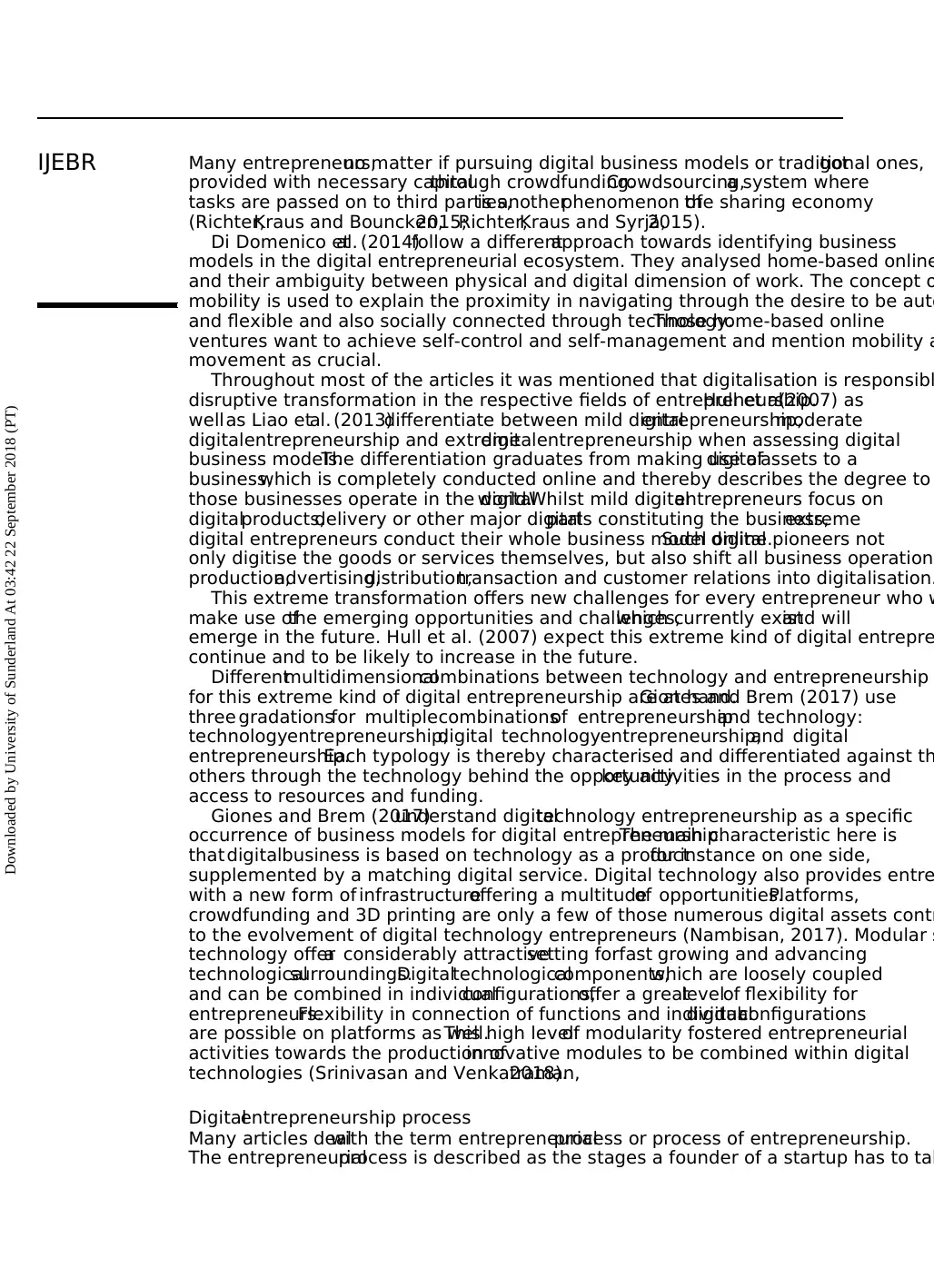
Many entrepreneurs,no matter if pursuing digital business models or traditional ones,got
provided with necessary capitalthrough crowdfunding.Crowdsourcing,a system where
tasks are passed on to third parties,is anotherphenomenon ofthe sharing economy
(Richter,Kraus and Bouncken,2015;Richter,Kraus and Syrjä,2015).
Di Domenico etal. (2014)follow a differentapproach towards identifying business
models in the digital entrepreneurial ecosystem. They analysed home-based online
and their ambiguity between physical and digital dimension of work. The concept o
mobility is used to explain the proximity in navigating through the desire to be auto
and flexible and also socially connected through technology.Those home-based online
ventures want to achieve self-control and self-management and mention mobility a
movement as crucial.
Throughout most of the articles it was mentioned that digitalisation is responsibl
disruptive transformation in the respective fields of entrepreneurship.Hull et al.(2007) as
wellas Liao etal. (2013)differentiate between mild digitalentrepreneurship,moderate
digitalentrepreneurship and extremedigitalentrepreneurship when assessing digital
business models.The differentiation graduates from making use ofdigitalassets to a
business,which is completely conducted online and thereby describes the degree to
those businesses operate in the digitalworld.Whilst mild digitalentrepreneurs focus on
digitalproducts,delivery or other major digitalparts constituting the business,extreme
digital entrepreneurs conduct their whole business model online.Such digital pioneers not
only digitise the goods or services themselves, but also shift all business operations
production,advertising,distribution,transaction and customer relations into digitalisation.
This extreme transformation offers new challenges for every entrepreneur who w
make use ofthe emerging opportunities and challenges,which currently existand will
emerge in the future. Hull et al. (2007) expect this extreme kind of digital entrepre
continue and to be likely to increase in the future.
Differentmultidimensionalcombinations between technology and entrepreneurship
for this extreme kind of digital entrepreneurship are at hand.Giones and Brem (2017) use
three gradationsfor multiplecombinationsof entrepreneurshipand technology:
technologyentrepreneurship;digital technologyentrepreneurship;and digital
entrepreneurship.Each typology is thereby characterised and differentiated against th
others through the technology behind the opportunity,key activities in the process and
access to resources and funding.
Giones and Brem (2017)understand digitaltechnology entrepreneurship as a specific
occurrence of business models for digital entrepreneurship.The main characteristic here is
that digitalbusiness is based on technology as a productfor instance on one side,
supplemented by a matching digital service. Digital technology also provides entre
with a new form of infrastructureoffering a multitudeof opportunities.Platforms,
crowdfunding and 3D printing are only a few of those numerous digital assets contr
to the evolvement of digital technology entrepreneurs (Nambisan, 2017). Modular s
technology offera considerably attractivesetting forfast growing and advancing
technologicalsurroundings.Digitaltechnologicalcomponents,which are loosely coupled
and can be combined in individualconfigurations,offer a greatlevelof flexibility for
entrepreneurs.Flexibility in connection of functions and individualdigitalconfigurations
are possible on platforms as well.This high levelof modularity fostered entrepreneurial
activities towards the production ofinnovative modules to be combined within digital
technologies (Srinivasan and Venkatraman,2018).
Digitalentrepreneurship process
Many articles dealwith the term entrepreneurialprocess or process of entrepreneurship.
The entrepreneurialprocess is described as the stages a founder of a startup has to tak
IJEBR
Downloaded by University of Sunderland At 03:42 22 September 2018 (PT)
provided with necessary capitalthrough crowdfunding.Crowdsourcing,a system where
tasks are passed on to third parties,is anotherphenomenon ofthe sharing economy
(Richter,Kraus and Bouncken,2015;Richter,Kraus and Syrjä,2015).
Di Domenico etal. (2014)follow a differentapproach towards identifying business
models in the digital entrepreneurial ecosystem. They analysed home-based online
and their ambiguity between physical and digital dimension of work. The concept o
mobility is used to explain the proximity in navigating through the desire to be auto
and flexible and also socially connected through technology.Those home-based online
ventures want to achieve self-control and self-management and mention mobility a
movement as crucial.
Throughout most of the articles it was mentioned that digitalisation is responsibl
disruptive transformation in the respective fields of entrepreneurship.Hull et al.(2007) as
wellas Liao etal. (2013)differentiate between mild digitalentrepreneurship,moderate
digitalentrepreneurship and extremedigitalentrepreneurship when assessing digital
business models.The differentiation graduates from making use ofdigitalassets to a
business,which is completely conducted online and thereby describes the degree to
those businesses operate in the digitalworld.Whilst mild digitalentrepreneurs focus on
digitalproducts,delivery or other major digitalparts constituting the business,extreme
digital entrepreneurs conduct their whole business model online.Such digital pioneers not
only digitise the goods or services themselves, but also shift all business operations
production,advertising,distribution,transaction and customer relations into digitalisation.
This extreme transformation offers new challenges for every entrepreneur who w
make use ofthe emerging opportunities and challenges,which currently existand will
emerge in the future. Hull et al. (2007) expect this extreme kind of digital entrepre
continue and to be likely to increase in the future.
Differentmultidimensionalcombinations between technology and entrepreneurship
for this extreme kind of digital entrepreneurship are at hand.Giones and Brem (2017) use
three gradationsfor multiplecombinationsof entrepreneurshipand technology:
technologyentrepreneurship;digital technologyentrepreneurship;and digital
entrepreneurship.Each typology is thereby characterised and differentiated against th
others through the technology behind the opportunity,key activities in the process and
access to resources and funding.
Giones and Brem (2017)understand digitaltechnology entrepreneurship as a specific
occurrence of business models for digital entrepreneurship.The main characteristic here is
that digitalbusiness is based on technology as a productfor instance on one side,
supplemented by a matching digital service. Digital technology also provides entre
with a new form of infrastructureoffering a multitudeof opportunities.Platforms,
crowdfunding and 3D printing are only a few of those numerous digital assets contr
to the evolvement of digital technology entrepreneurs (Nambisan, 2017). Modular s
technology offera considerably attractivesetting forfast growing and advancing
technologicalsurroundings.Digitaltechnologicalcomponents,which are loosely coupled
and can be combined in individualconfigurations,offer a greatlevelof flexibility for
entrepreneurs.Flexibility in connection of functions and individualdigitalconfigurations
are possible on platforms as well.This high levelof modularity fostered entrepreneurial
activities towards the production ofinnovative modules to be combined within digital
technologies (Srinivasan and Venkatraman,2018).
Digitalentrepreneurship process
Many articles dealwith the term entrepreneurialprocess or process of entrepreneurship.
The entrepreneurialprocess is described as the stages a founder of a startup has to tak
IJEBR
Downloaded by University of Sunderland At 03:42 22 September 2018 (PT)
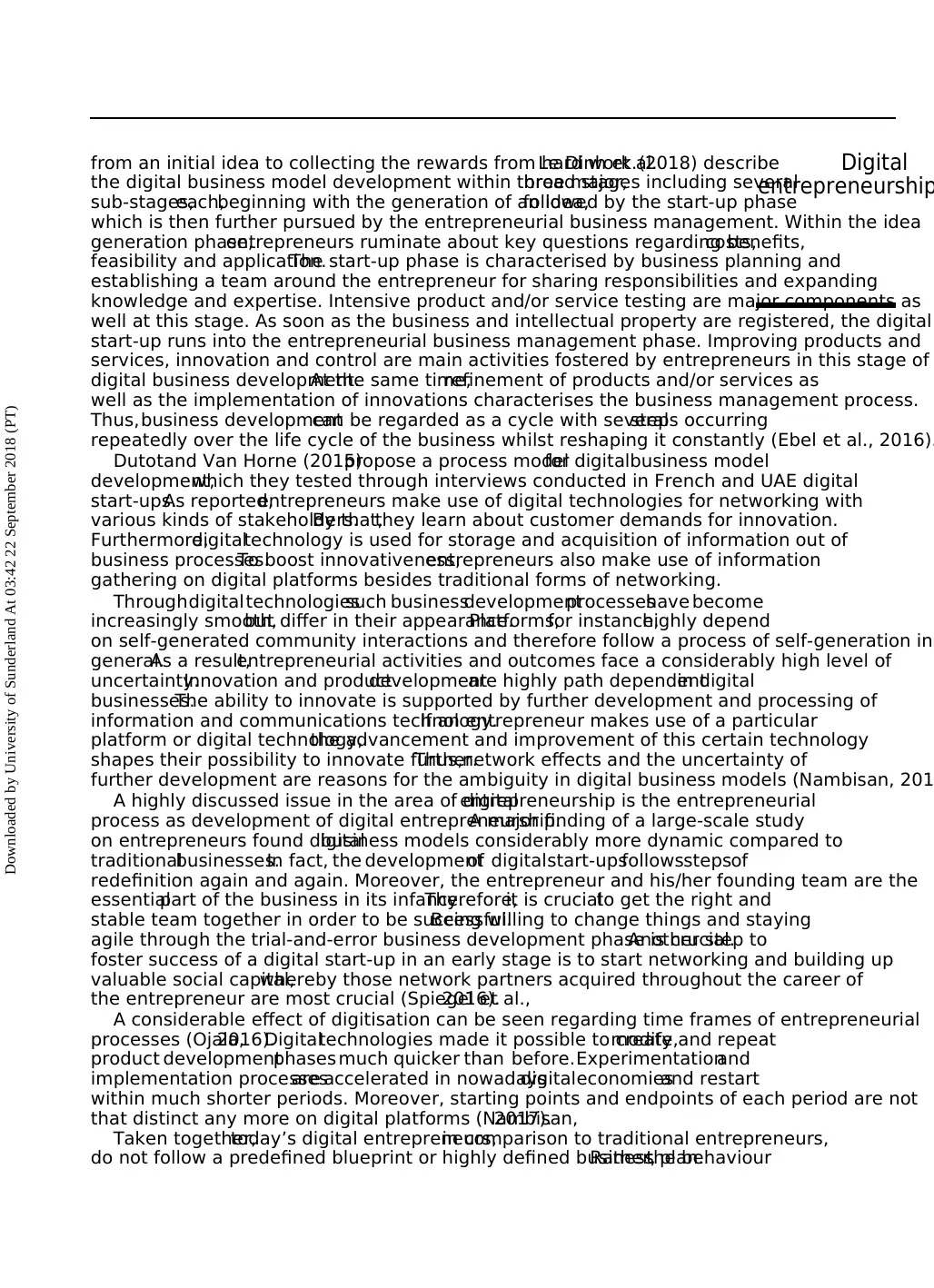
from an initial idea to collecting the rewards from hard work.Le Dinh et al.(2018) describe
the digital business model development within three major,broad stages including several
sub-stages,each,beginning with the generation of an idea,followed by the start-up phase
which is then further pursued by the entrepreneurial business management. Within the idea
generation phase,entrepreneurs ruminate about key questions regarding benefits,costs,
feasibility and application.The start-up phase is characterised by business planning and
establishing a team around the entrepreneur for sharing responsibilities and expanding
knowledge and expertise. Intensive product and/or service testing are major components as
well at this stage. As soon as the business and intellectual property are registered, the digital
start-up runs into the entrepreneurial business management phase. Improving products and
services, innovation and control are main activities fostered by entrepreneurs in this stage of
digital business development.At the same time,refinement of products and/or services as
well as the implementation of innovations characterises the business management process.
Thus,business developmentcan be regarded as a cycle with severalsteps occurring
repeatedly over the life cycle of the business whilst reshaping it constantly (Ebel et al., 2016).
Dutotand Van Horne (2015)propose a process modelfor digitalbusiness model
development,which they tested through interviews conducted in French and UAE digital
start-ups.As reported,entrepreneurs make use of digital technologies for networking with
various kinds of stakeholders.By that,they learn about customer demands for innovation.
Furthermore,digitaltechnology is used for storage and acquisition of information out of
business processes.To boost innovativeness,entrepreneurs also make use of information
gathering on digital platforms besides traditional forms of networking.
Throughdigitaltechnologiessuch businessdevelopmentprocesseshave become
increasingly smooth,but differ in their appearance.Platforms,for instance,highly depend
on self-generated community interactions and therefore follow a process of self-generation in
general.As a result,entrepreneurial activities and outcomes face a considerably high level of
uncertainty.Innovation and productdevelopmentare highly path dependentin digital
businesses.The ability to innovate is supported by further development and processing of
information and communications technology.If an entrepreneur makes use of a particular
platform or digital technology,the advancement and improvement of this certain technology
shapes their possibility to innovate further.Thus,network effects and the uncertainty of
further development are reasons for the ambiguity in digital business models (Nambisan, 201
A highly discussed issue in the area of digitalentrepreneurship is the entrepreneurial
process as development of digital entrepreneurship.A major finding of a large-scale study
on entrepreneurs found digitalbusiness models considerably more dynamic compared to
traditionalbusinesses.In fact, the developmentof digitalstart-upsfollowsstepsof
redefinition again and again. Moreover, the entrepreneur and his/her founding team are the
essentialpart of the business in its infancy.Therefore,it is crucialto get the right and
stable team together in order to be successful.Being willing to change things and staying
agile through the trial-and-error business development phase is crucial.Another step to
foster success of a digital start-up in an early stage is to start networking and building up
valuable social capital,whereby those network partners acquired throughout the career of
the entrepreneur are most crucial (Spiegel et al.,2016).
A considerable effect of digitisation can be seen regarding time frames of entrepreneurial
processes (Ojala,2016).Digitaltechnologies made it possible to create,modify and repeat
product developmentphases much quicker than before.Experimentationand
implementation processesare accelerated in nowadaysdigitaleconomiesand restart
within much shorter periods. Moreover, starting points and endpoints of each period are not
that distinct any more on digital platforms (Nambisan,2017).
Taken together,today’s digital entrepreneurs,in comparison to traditional entrepreneurs,
do not follow a predefined blueprint or highly defined business plan.Rather,the behaviour
Digital
entrepreneurship
Downloaded by University of Sunderland At 03:42 22 September 2018 (PT)
the digital business model development within three major,broad stages including several
sub-stages,each,beginning with the generation of an idea,followed by the start-up phase
which is then further pursued by the entrepreneurial business management. Within the idea
generation phase,entrepreneurs ruminate about key questions regarding benefits,costs,
feasibility and application.The start-up phase is characterised by business planning and
establishing a team around the entrepreneur for sharing responsibilities and expanding
knowledge and expertise. Intensive product and/or service testing are major components as
well at this stage. As soon as the business and intellectual property are registered, the digital
start-up runs into the entrepreneurial business management phase. Improving products and
services, innovation and control are main activities fostered by entrepreneurs in this stage of
digital business development.At the same time,refinement of products and/or services as
well as the implementation of innovations characterises the business management process.
Thus,business developmentcan be regarded as a cycle with severalsteps occurring
repeatedly over the life cycle of the business whilst reshaping it constantly (Ebel et al., 2016).
Dutotand Van Horne (2015)propose a process modelfor digitalbusiness model
development,which they tested through interviews conducted in French and UAE digital
start-ups.As reported,entrepreneurs make use of digital technologies for networking with
various kinds of stakeholders.By that,they learn about customer demands for innovation.
Furthermore,digitaltechnology is used for storage and acquisition of information out of
business processes.To boost innovativeness,entrepreneurs also make use of information
gathering on digital platforms besides traditional forms of networking.
Throughdigitaltechnologiessuch businessdevelopmentprocesseshave become
increasingly smooth,but differ in their appearance.Platforms,for instance,highly depend
on self-generated community interactions and therefore follow a process of self-generation in
general.As a result,entrepreneurial activities and outcomes face a considerably high level of
uncertainty.Innovation and productdevelopmentare highly path dependentin digital
businesses.The ability to innovate is supported by further development and processing of
information and communications technology.If an entrepreneur makes use of a particular
platform or digital technology,the advancement and improvement of this certain technology
shapes their possibility to innovate further.Thus,network effects and the uncertainty of
further development are reasons for the ambiguity in digital business models (Nambisan, 201
A highly discussed issue in the area of digitalentrepreneurship is the entrepreneurial
process as development of digital entrepreneurship.A major finding of a large-scale study
on entrepreneurs found digitalbusiness models considerably more dynamic compared to
traditionalbusinesses.In fact, the developmentof digitalstart-upsfollowsstepsof
redefinition again and again. Moreover, the entrepreneur and his/her founding team are the
essentialpart of the business in its infancy.Therefore,it is crucialto get the right and
stable team together in order to be successful.Being willing to change things and staying
agile through the trial-and-error business development phase is crucial.Another step to
foster success of a digital start-up in an early stage is to start networking and building up
valuable social capital,whereby those network partners acquired throughout the career of
the entrepreneur are most crucial (Spiegel et al.,2016).
A considerable effect of digitisation can be seen regarding time frames of entrepreneurial
processes (Ojala,2016).Digitaltechnologies made it possible to create,modify and repeat
product developmentphases much quicker than before.Experimentationand
implementation processesare accelerated in nowadaysdigitaleconomiesand restart
within much shorter periods. Moreover, starting points and endpoints of each period are not
that distinct any more on digital platforms (Nambisan,2017).
Taken together,today’s digital entrepreneurs,in comparison to traditional entrepreneurs,
do not follow a predefined blueprint or highly defined business plan.Rather,the behaviour
Digital
entrepreneurship
Downloaded by University of Sunderland At 03:42 22 September 2018 (PT)
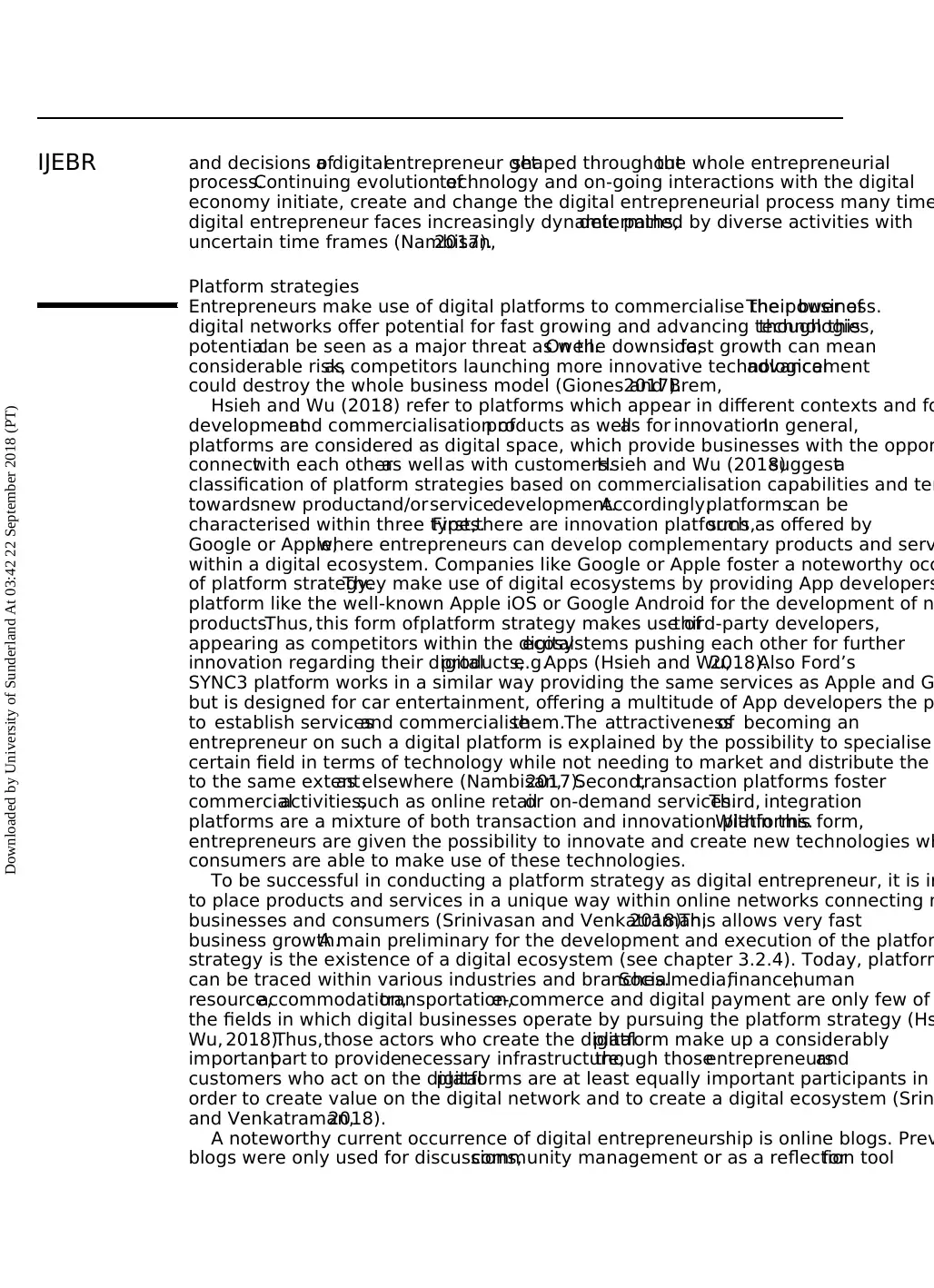
and decisions ofa digitalentrepreneur getshaped throughoutthe whole entrepreneurial
process.Continuing evolution oftechnology and on-going interactions with the digital
economy initiate, create and change the digital entrepreneurial process many time
digital entrepreneur faces increasingly dynamic paths,determined by diverse activities with
uncertain time frames (Nambisan,2017).
Platform strategies
Entrepreneurs make use of digital platforms to commercialise their business.The power of
digital networks offer potential for fast growing and advancing technologies,though this
potentialcan be seen as a major threat as well.On the downside,fast growth can mean
considerable risk,as competitors launching more innovative technologicaladvancement
could destroy the whole business model (Giones and Brem,2017).
Hsieh and Wu (2018) refer to platforms which appear in different contexts and fo
developmentand commercialisation ofproducts as wellas for innovation.In general,
platforms are considered as digital space, which provide businesses with the oppor
connectwith each otheras wellas with customers.Hsieh and Wu (2018)suggesta
classification of platform strategies based on commercialisation capabilities and ten
towardsnew productand/orservicedevelopment.Accordingly,platformscan be
characterised within three types.First,there are innovation platforms,such as offered by
Google or Apple,where entrepreneurs can develop complementary products and serv
within a digital ecosystem. Companies like Google or Apple foster a noteworthy occ
of platform strategy.They make use of digital ecosystems by providing App developers
platform like the well-known Apple iOS or Google Android for the development of n
products.Thus, this form ofplatform strategy makes use ofthird-party developers,
appearing as competitors within the digitalecosystems pushing each other for further
innovation regarding their digitalproducts,e.g.Apps (Hsieh and Wu,2018).Also Ford’s
SYNC3 platform works in a similar way providing the same services as Apple and G
but is designed for car entertainment, offering a multitude of App developers the p
to establish servicesand commercialisethem.The attractivenessof becoming an
entrepreneur on such a digital platform is explained by the possibility to specialise
certain field in terms of technology while not needing to market and distribute the
to the same extentas elsewhere (Nambisan,2017).Second,transaction platforms foster
commercialactivities,such as online retailor on-demand services.Third, integration
platforms are a mixture of both transaction and innovation platforms.Within this form,
entrepreneurs are given the possibility to innovate and create new technologies wh
consumers are able to make use of these technologies.
To be successful in conducting a platform strategy as digital entrepreneur, it is in
to place products and services in a unique way within online networks connecting m
businesses and consumers (Srinivasan and Venkatraman,2018).This allows very fast
business growth.A main preliminary for the development and execution of the platfor
strategy is the existence of a digital ecosystem (see chapter 3.2.4). Today, platform
can be traced within various industries and branches.Socialmedia,finance,human
resource,accommodation,transportation,e-commerce and digital payment are only few of
the fields in which digital businesses operate by pursuing the platform strategy (Hs
Wu, 2018).Thus,those actors who create the digitalplatform make up a considerably
importantpart to providenecessary infrastructure,though thoseentrepreneursand
customers who act on the digitalplatforms are at least equally important participants in
order to create value on the digital network and to create a digital ecosystem (Srin
and Venkatraman,2018).
A noteworthy current occurrence of digital entrepreneurship is online blogs. Prev
blogs were only used for discussions,community management or as a reflection toolfor
IJEBR
Downloaded by University of Sunderland At 03:42 22 September 2018 (PT)
process.Continuing evolution oftechnology and on-going interactions with the digital
economy initiate, create and change the digital entrepreneurial process many time
digital entrepreneur faces increasingly dynamic paths,determined by diverse activities with
uncertain time frames (Nambisan,2017).
Platform strategies
Entrepreneurs make use of digital platforms to commercialise their business.The power of
digital networks offer potential for fast growing and advancing technologies,though this
potentialcan be seen as a major threat as well.On the downside,fast growth can mean
considerable risk,as competitors launching more innovative technologicaladvancement
could destroy the whole business model (Giones and Brem,2017).
Hsieh and Wu (2018) refer to platforms which appear in different contexts and fo
developmentand commercialisation ofproducts as wellas for innovation.In general,
platforms are considered as digital space, which provide businesses with the oppor
connectwith each otheras wellas with customers.Hsieh and Wu (2018)suggesta
classification of platform strategies based on commercialisation capabilities and ten
towardsnew productand/orservicedevelopment.Accordingly,platformscan be
characterised within three types.First,there are innovation platforms,such as offered by
Google or Apple,where entrepreneurs can develop complementary products and serv
within a digital ecosystem. Companies like Google or Apple foster a noteworthy occ
of platform strategy.They make use of digital ecosystems by providing App developers
platform like the well-known Apple iOS or Google Android for the development of n
products.Thus, this form ofplatform strategy makes use ofthird-party developers,
appearing as competitors within the digitalecosystems pushing each other for further
innovation regarding their digitalproducts,e.g.Apps (Hsieh and Wu,2018).Also Ford’s
SYNC3 platform works in a similar way providing the same services as Apple and G
but is designed for car entertainment, offering a multitude of App developers the p
to establish servicesand commercialisethem.The attractivenessof becoming an
entrepreneur on such a digital platform is explained by the possibility to specialise
certain field in terms of technology while not needing to market and distribute the
to the same extentas elsewhere (Nambisan,2017).Second,transaction platforms foster
commercialactivities,such as online retailor on-demand services.Third, integration
platforms are a mixture of both transaction and innovation platforms.Within this form,
entrepreneurs are given the possibility to innovate and create new technologies wh
consumers are able to make use of these technologies.
To be successful in conducting a platform strategy as digital entrepreneur, it is in
to place products and services in a unique way within online networks connecting m
businesses and consumers (Srinivasan and Venkatraman,2018).This allows very fast
business growth.A main preliminary for the development and execution of the platfor
strategy is the existence of a digital ecosystem (see chapter 3.2.4). Today, platform
can be traced within various industries and branches.Socialmedia,finance,human
resource,accommodation,transportation,e-commerce and digital payment are only few of
the fields in which digital businesses operate by pursuing the platform strategy (Hs
Wu, 2018).Thus,those actors who create the digitalplatform make up a considerably
importantpart to providenecessary infrastructure,though thoseentrepreneursand
customers who act on the digitalplatforms are at least equally important participants in
order to create value on the digital network and to create a digital ecosystem (Srin
and Venkatraman,2018).
A noteworthy current occurrence of digital entrepreneurship is online blogs. Prev
blogs were only used for discussions,community management or as a reflection toolfor
IJEBR
Downloaded by University of Sunderland At 03:42 22 September 2018 (PT)
Paraphrase This Document
Need a fresh take? Get an instant paraphrase of this document with our AI Paraphraser
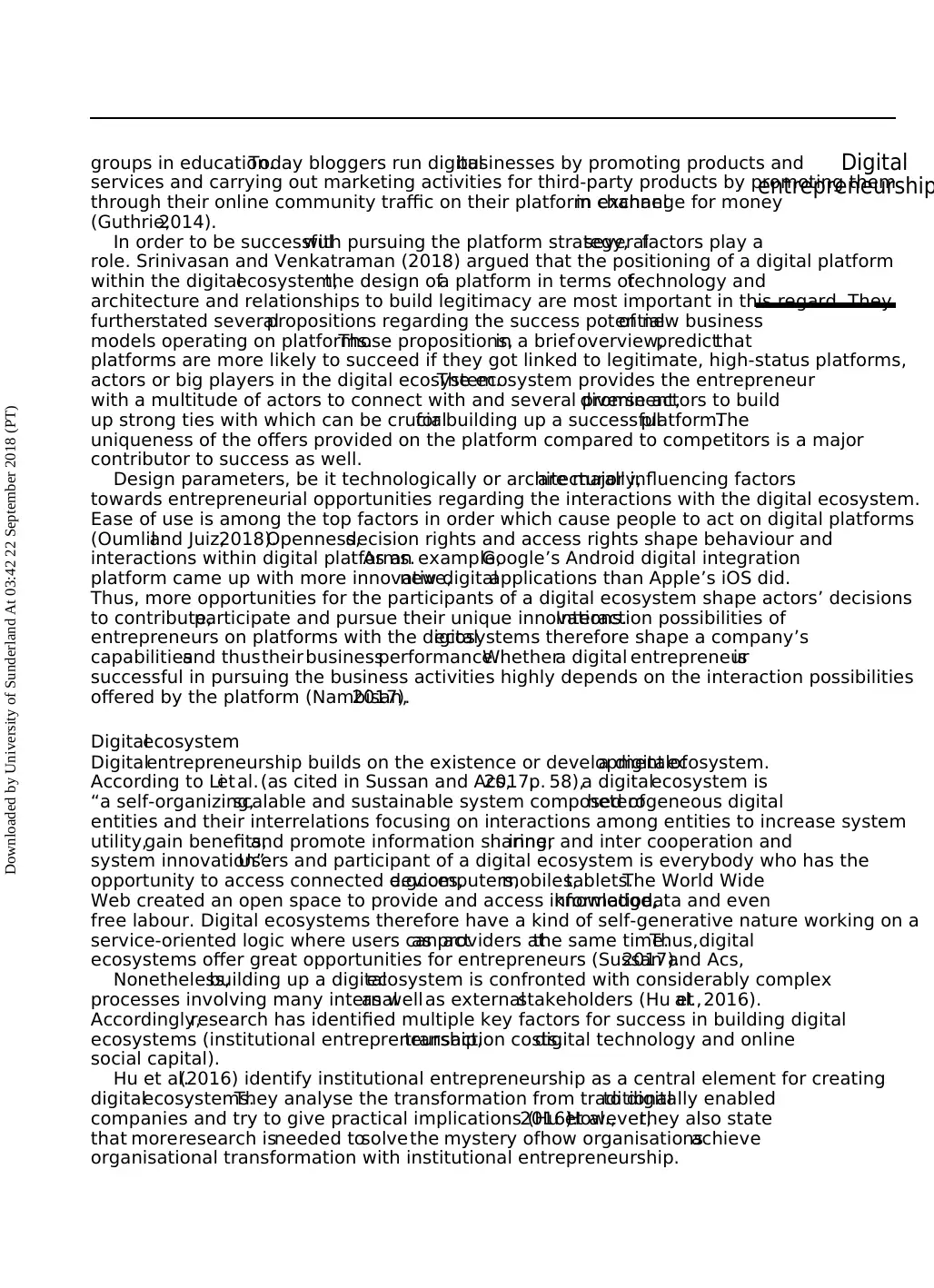
groups in education.Today bloggers run digitalbusinesses by promoting products and
services and carrying out marketing activities for third-party products by promoting them
through their online community traffic on their platform channelin exchange for money
(Guthrie,2014).
In order to be successfulwith pursuing the platform strategy,severalfactors play a
role. Srinivasan and Venkatraman (2018) argued that the positioning of a digital platform
within the digitalecosystem,the design ofa platform in terms oftechnology and
architecture and relationships to build legitimacy are most important in this regard. They
furtherstated severalpropositions regarding the success potentialof new business
models operating on platforms.Those propositions,in a brief overview,predictthat
platforms are more likely to succeed if they got linked to legitimate, high-status platforms,
actors or big players in the digital ecosystem.The ecosystem provides the entrepreneur
with a multitude of actors to connect with and several prominent,diverse actors to build
up strong ties with which can be crucialfor building up a successfulplatform.The
uniqueness of the offers provided on the platform compared to competitors is a major
contributor to success as well.
Design parameters, be it technologically or architecturally,are major influencing factors
towards entrepreneurial opportunities regarding the interactions with the digital ecosystem.
Ease of use is among the top factors in order which cause people to act on digital platforms
(Oumliland Juiz,2018).Openness,decision rights and access rights shape behaviour and
interactions within digital platforms.As an example,Google’s Android digital integration
platform came up with more innovative,new digitalapplications than Apple’s iOS did.
Thus, more opportunities for the participants of a digital ecosystem shape actors’ decisions
to contribute,participate and pursue their unique innovations.Interaction possibilities of
entrepreneurs on platforms with the digitalecosystems therefore shape a company’s
capabilitiesand thustheir businessperformance.Whethera digital entrepreneuris
successful in pursuing the business activities highly depends on the interaction possibilities
offered by the platform (Nambisan,2017).
Digitalecosystem
Digitalentrepreneurship builds on the existence or development ofa digitalecosystem.
According to Liet al. (as cited in Sussan and Acs,2017,p. 58),a digitalecosystem is
“a self-organizing,scalable and sustainable system composed ofheterogeneous digital
entities and their interrelations focusing on interactions among entities to increase system
utility,gain benefits,and promote information sharing,inner and inter cooperation and
system innovation”.Users and participant of a digital ecosystem is everybody who has the
opportunity to access connected devices,e.g.computers,mobiles,tablets.The World Wide
Web created an open space to provide and access information,knowledge,data and even
free labour. Digital ecosystems therefore have a kind of self-generative nature working on a
service-oriented logic where users can actas providers atthe same time.Thus,digital
ecosystems offer great opportunities for entrepreneurs (Sussan and Acs,2017).
Nonetheless,building up a digitalecosystem is confronted with considerably complex
processes involving many internalas well as externalstakeholders (Hu etal.,2016).
Accordingly,research has identified multiple key factors for success in building digital
ecosystems (institutional entrepreneurship,transaction costs,digital technology and online
social capital).
Hu et al.(2016) identify institutional entrepreneurship as a central element for creating
digitalecosystems.They analyse the transformation from traditionalto digitally enabled
companies and try to give practical implications (Hu et al.,2016).However,they also state
that moreresearch isneeded tosolve the mystery ofhow organisationsachieve
organisational transformation with institutional entrepreneurship.
Digital
entrepreneurship
Downloaded by University of Sunderland At 03:42 22 September 2018 (PT)
services and carrying out marketing activities for third-party products by promoting them
through their online community traffic on their platform channelin exchange for money
(Guthrie,2014).
In order to be successfulwith pursuing the platform strategy,severalfactors play a
role. Srinivasan and Venkatraman (2018) argued that the positioning of a digital platform
within the digitalecosystem,the design ofa platform in terms oftechnology and
architecture and relationships to build legitimacy are most important in this regard. They
furtherstated severalpropositions regarding the success potentialof new business
models operating on platforms.Those propositions,in a brief overview,predictthat
platforms are more likely to succeed if they got linked to legitimate, high-status platforms,
actors or big players in the digital ecosystem.The ecosystem provides the entrepreneur
with a multitude of actors to connect with and several prominent,diverse actors to build
up strong ties with which can be crucialfor building up a successfulplatform.The
uniqueness of the offers provided on the platform compared to competitors is a major
contributor to success as well.
Design parameters, be it technologically or architecturally,are major influencing factors
towards entrepreneurial opportunities regarding the interactions with the digital ecosystem.
Ease of use is among the top factors in order which cause people to act on digital platforms
(Oumliland Juiz,2018).Openness,decision rights and access rights shape behaviour and
interactions within digital platforms.As an example,Google’s Android digital integration
platform came up with more innovative,new digitalapplications than Apple’s iOS did.
Thus, more opportunities for the participants of a digital ecosystem shape actors’ decisions
to contribute,participate and pursue their unique innovations.Interaction possibilities of
entrepreneurs on platforms with the digitalecosystems therefore shape a company’s
capabilitiesand thustheir businessperformance.Whethera digital entrepreneuris
successful in pursuing the business activities highly depends on the interaction possibilities
offered by the platform (Nambisan,2017).
Digitalecosystem
Digitalentrepreneurship builds on the existence or development ofa digitalecosystem.
According to Liet al. (as cited in Sussan and Acs,2017,p. 58),a digitalecosystem is
“a self-organizing,scalable and sustainable system composed ofheterogeneous digital
entities and their interrelations focusing on interactions among entities to increase system
utility,gain benefits,and promote information sharing,inner and inter cooperation and
system innovation”.Users and participant of a digital ecosystem is everybody who has the
opportunity to access connected devices,e.g.computers,mobiles,tablets.The World Wide
Web created an open space to provide and access information,knowledge,data and even
free labour. Digital ecosystems therefore have a kind of self-generative nature working on a
service-oriented logic where users can actas providers atthe same time.Thus,digital
ecosystems offer great opportunities for entrepreneurs (Sussan and Acs,2017).
Nonetheless,building up a digitalecosystem is confronted with considerably complex
processes involving many internalas well as externalstakeholders (Hu etal.,2016).
Accordingly,research has identified multiple key factors for success in building digital
ecosystems (institutional entrepreneurship,transaction costs,digital technology and online
social capital).
Hu et al.(2016) identify institutional entrepreneurship as a central element for creating
digitalecosystems.They analyse the transformation from traditionalto digitally enabled
companies and try to give practical implications (Hu et al.,2016).However,they also state
that moreresearch isneeded tosolve the mystery ofhow organisationsachieve
organisational transformation with institutional entrepreneurship.
Digital
entrepreneurship
Downloaded by University of Sunderland At 03:42 22 September 2018 (PT)
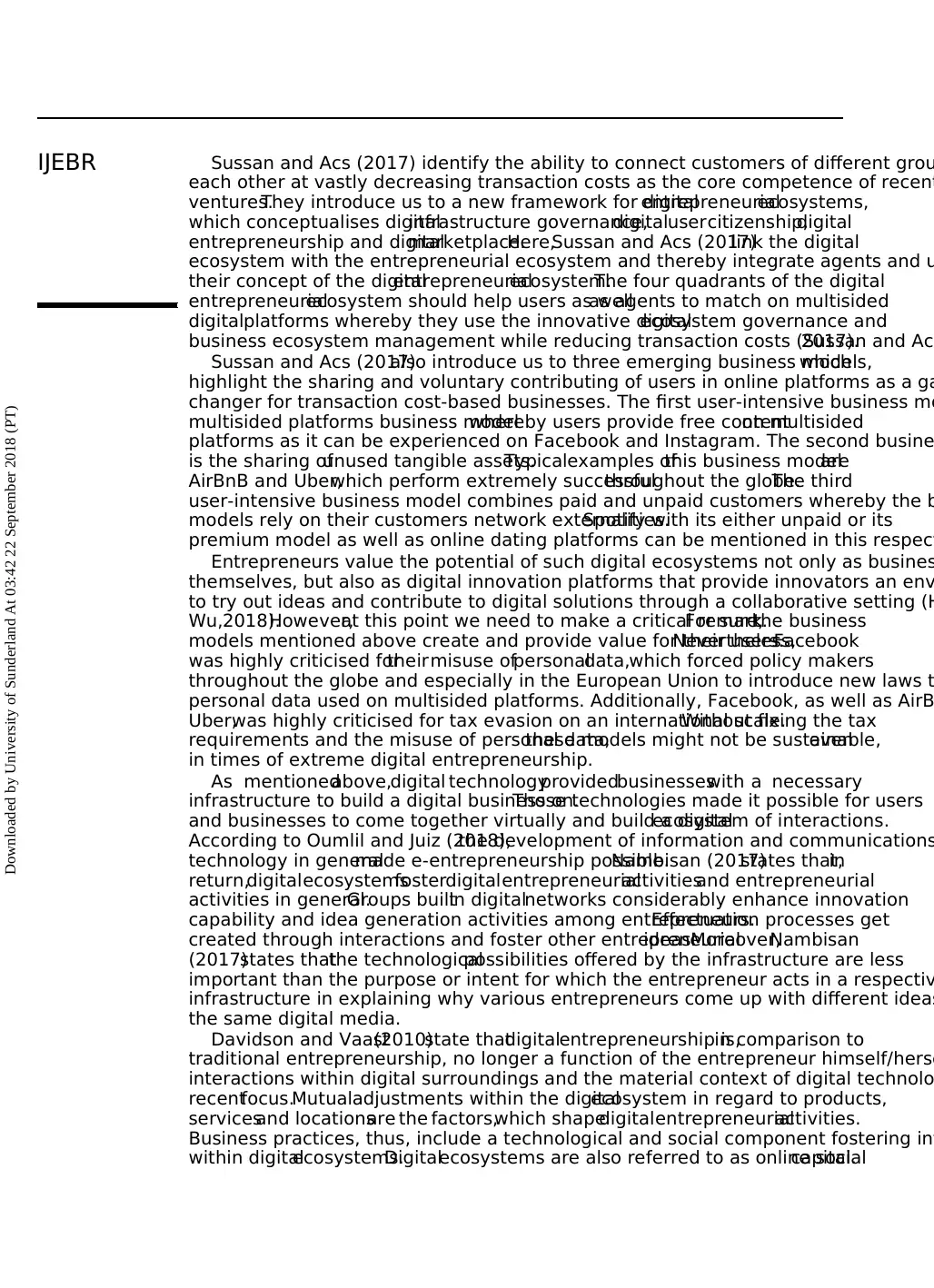
Sussan and Acs (2017) identify the ability to connect customers of different grou
each other at vastly decreasing transaction costs as the core competence of recent
ventures.They introduce us to a new framework for digitalentrepreneurialecosystems,
which conceptualises digitalinfrastructure governance,digitalusercitizenship,digital
entrepreneurship and digitalmarketplace.Here,Sussan and Acs (2017)link the digital
ecosystem with the entrepreneurial ecosystem and thereby integrate agents and u
their concept of the digitalentrepreneurialecosystem.The four quadrants of the digital
entrepreneurialecosystem should help users as wellas agents to match on multisided
digitalplatforms whereby they use the innovative digitalecosystem governance and
business ecosystem management while reducing transaction costs (Sussan and Ac2017).
Sussan and Acs (2017)also introduce us to three emerging business models,which
highlight the sharing and voluntary contributing of users in online platforms as a ga
changer for transaction cost-based businesses. The first user-intensive business mo
multisided platforms business modelwhereby users provide free contenton multisided
platforms as it can be experienced on Facebook and Instagram. The second busine
is the sharing ofunused tangible assets.Typicalexamples ofthis business modelare
AirBnB and Uber,which perform extremely successfulthroughout the globe.The third
user-intensive business model combines paid and unpaid customers whereby the b
models rely on their customers network externalities.Spotify with its either unpaid or its
premium model as well as online dating platforms can be mentioned in this respect
Entrepreneurs value the potential of such digital ecosystems not only as busines
themselves, but also as digital innovation platforms that provide innovators an env
to try out ideas and contribute to digital solutions through a collaborative setting (H
Wu,2018).However,at this point we need to make a critical remark.For sure,the business
models mentioned above create and provide value for their users.Nevertheless,Facebook
was highly criticised fortheirmisuse ofpersonaldata,which forced policy makers
throughout the globe and especially in the European Union to introduce new laws t
personal data used on multisided platforms. Additionally, Facebook, as well as AirB
Uber,was highly criticised for tax evasion on an international scale.Without fixing the tax
requirements and the misuse of personal data,these models might not be sustainable,even
in times of extreme digital entrepreneurship.
As mentionedabove,digital technologyprovidedbusinesseswith a necessary
infrastructure to build a digital business on.Those technologies made it possible for users
and businesses to come together virtually and build a digitalecosystem of interactions.
According to Oumlil and Juiz (2018),the development of information and communications
technology in generalmade e-entrepreneurship possible.Nambisan (2017)states that,in
return,digitalecosystemsfosterdigitalentrepreneurialactivitiesand entrepreneurial
activities in general.Groups builtin digitalnetworks considerably enhance innovation
capability and idea generation activities among entrepreneurs.Effectuation processes get
created through interactions and foster other entrepreneurialideas.Moreover,Nambisan
(2017)states thatthe technologicalpossibilities offered by the infrastructure are less
important than the purpose or intent for which the entrepreneur acts in a respectiv
infrastructure in explaining why various entrepreneurs come up with different ideas
the same digital media.
Davidson and Vaast(2010)state thatdigitalentrepreneurship is,in comparison to
traditional entrepreneurship, no longer a function of the entrepreneur himself/herse
interactions within digital surroundings and the material context of digital technolo
recentfocus.Mutualadjustments within the digitalecosystem in regard to products,
servicesand locationsare the factors,which shapedigitalentrepreneurialactivities.
Business practices, thus, include a technological and social component fostering int
within digitalecosystems.Digitalecosystems are also referred to as online socialcapital.
IJEBR
Downloaded by University of Sunderland At 03:42 22 September 2018 (PT)
each other at vastly decreasing transaction costs as the core competence of recent
ventures.They introduce us to a new framework for digitalentrepreneurialecosystems,
which conceptualises digitalinfrastructure governance,digitalusercitizenship,digital
entrepreneurship and digitalmarketplace.Here,Sussan and Acs (2017)link the digital
ecosystem with the entrepreneurial ecosystem and thereby integrate agents and u
their concept of the digitalentrepreneurialecosystem.The four quadrants of the digital
entrepreneurialecosystem should help users as wellas agents to match on multisided
digitalplatforms whereby they use the innovative digitalecosystem governance and
business ecosystem management while reducing transaction costs (Sussan and Ac2017).
Sussan and Acs (2017)also introduce us to three emerging business models,which
highlight the sharing and voluntary contributing of users in online platforms as a ga
changer for transaction cost-based businesses. The first user-intensive business mo
multisided platforms business modelwhereby users provide free contenton multisided
platforms as it can be experienced on Facebook and Instagram. The second busine
is the sharing ofunused tangible assets.Typicalexamples ofthis business modelare
AirBnB and Uber,which perform extremely successfulthroughout the globe.The third
user-intensive business model combines paid and unpaid customers whereby the b
models rely on their customers network externalities.Spotify with its either unpaid or its
premium model as well as online dating platforms can be mentioned in this respect
Entrepreneurs value the potential of such digital ecosystems not only as busines
themselves, but also as digital innovation platforms that provide innovators an env
to try out ideas and contribute to digital solutions through a collaborative setting (H
Wu,2018).However,at this point we need to make a critical remark.For sure,the business
models mentioned above create and provide value for their users.Nevertheless,Facebook
was highly criticised fortheirmisuse ofpersonaldata,which forced policy makers
throughout the globe and especially in the European Union to introduce new laws t
personal data used on multisided platforms. Additionally, Facebook, as well as AirB
Uber,was highly criticised for tax evasion on an international scale.Without fixing the tax
requirements and the misuse of personal data,these models might not be sustainable,even
in times of extreme digital entrepreneurship.
As mentionedabove,digital technologyprovidedbusinesseswith a necessary
infrastructure to build a digital business on.Those technologies made it possible for users
and businesses to come together virtually and build a digitalecosystem of interactions.
According to Oumlil and Juiz (2018),the development of information and communications
technology in generalmade e-entrepreneurship possible.Nambisan (2017)states that,in
return,digitalecosystemsfosterdigitalentrepreneurialactivitiesand entrepreneurial
activities in general.Groups builtin digitalnetworks considerably enhance innovation
capability and idea generation activities among entrepreneurs.Effectuation processes get
created through interactions and foster other entrepreneurialideas.Moreover,Nambisan
(2017)states thatthe technologicalpossibilities offered by the infrastructure are less
important than the purpose or intent for which the entrepreneur acts in a respectiv
infrastructure in explaining why various entrepreneurs come up with different ideas
the same digital media.
Davidson and Vaast(2010)state thatdigitalentrepreneurship is,in comparison to
traditional entrepreneurship, no longer a function of the entrepreneur himself/herse
interactions within digital surroundings and the material context of digital technolo
recentfocus.Mutualadjustments within the digitalecosystem in regard to products,
servicesand locationsare the factors,which shapedigitalentrepreneurialactivities.
Business practices, thus, include a technological and social component fostering int
within digitalecosystems.Digitalecosystems are also referred to as online socialcapital.
IJEBR
Downloaded by University of Sunderland At 03:42 22 September 2018 (PT)
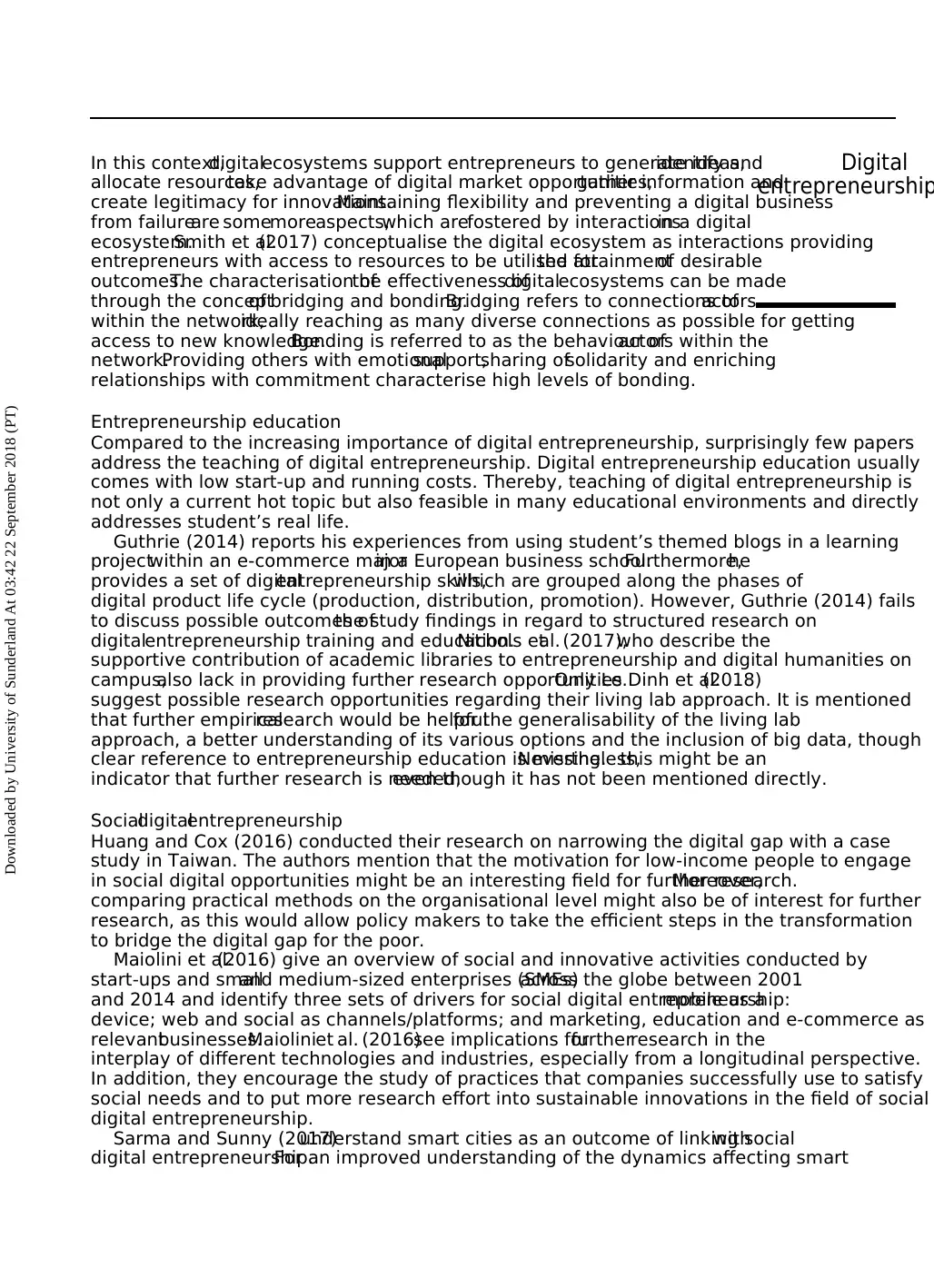
In this context,digitalecosystems support entrepreneurs to generate ideas,identify and
allocate resources,take advantage of digital market opportunities,gather information and
create legitimacy for innovations.Maintaining flexibility and preventing a digital business
from failureare somemoreaspects,which arefostered by interactionsin a digital
ecosystem.Smith et al.(2017) conceptualise the digital ecosystem as interactions providing
entrepreneurs with access to resources to be utilised forthe attainmentof desirable
outcomes.The characterisation ofthe effectiveness ofdigitalecosystems can be made
through the conceptof bridging and bonding.Bridging refers to connections ofactors
within the network,ideally reaching as many diverse connections as possible for getting
access to new knowledge.Bonding is referred to as the behaviour ofactors within the
network.Providing others with emotionalsupport,sharing ofsolidarity and enriching
relationships with commitment characterise high levels of bonding.
Entrepreneurship education
Compared to the increasing importance of digital entrepreneurship, surprisingly few papers
address the teaching of digital entrepreneurship. Digital entrepreneurship education usually
comes with low start-up and running costs. Thereby, teaching of digital entrepreneurship is
not only a current hot topic but also feasible in many educational environments and directly
addresses student’s real life.
Guthrie (2014) reports his experiences from using student’s themed blogs in a learning
projectwithin an e-commerce majorin a European business school.Furthermore,he
provides a set of digitalentrepreneurship skills,which are grouped along the phases of
digital product life cycle (production, distribution, promotion). However, Guthrie (2014) fails
to discuss possible outcomes ofthe study findings in regard to structured research on
digitalentrepreneurship training and education.Nichols etal. (2017),who describe the
supportive contribution of academic libraries to entrepreneurship and digital humanities on
campus,also lack in providing further research opportunities.Only Le Dinh et al.(2018)
suggest possible research opportunities regarding their living lab approach. It is mentioned
that further empiricalresearch would be helpfulfor the generalisability of the living lab
approach, a better understanding of its various options and the inclusion of big data, though
clear reference to entrepreneurship education is missing.Nevertheless,this might be an
indicator that further research is needed,even though it has not been mentioned directly.
Socialdigitalentrepreneurship
Huang and Cox (2016) conducted their research on narrowing the digital gap with a case
study in Taiwan. The authors mention that the motivation for low-income people to engage
in social digital opportunities might be an interesting field for further research.Moreover,
comparing practical methods on the organisational level might also be of interest for further
research, as this would allow policy makers to take the efficient steps in the transformation
to bridge the digital gap for the poor.
Maiolini et al.(2016) give an overview of social and innovative activities conducted by
start-ups and smalland medium-sized enterprises (SMEs)across the globe between 2001
and 2014 and identify three sets of drivers for social digital entrepreneurship:mobile as a
device; web and social as channels/platforms; and marketing, education and e-commerce as
relevantbusinesses.Maioliniet al. (2016)see implications forfurtherresearch in the
interplay of different technologies and industries, especially from a longitudinal perspective.
In addition, they encourage the study of practices that companies successfully use to satisfy
social needs and to put more research effort into sustainable innovations in the field of social
digital entrepreneurship.
Sarma and Sunny (2017)understand smart cities as an outcome of linking socialwith
digital entrepreneurship.For an improved understanding of the dynamics affecting smart
Digital
entrepreneurship
Downloaded by University of Sunderland At 03:42 22 September 2018 (PT)
allocate resources,take advantage of digital market opportunities,gather information and
create legitimacy for innovations.Maintaining flexibility and preventing a digital business
from failureare somemoreaspects,which arefostered by interactionsin a digital
ecosystem.Smith et al.(2017) conceptualise the digital ecosystem as interactions providing
entrepreneurs with access to resources to be utilised forthe attainmentof desirable
outcomes.The characterisation ofthe effectiveness ofdigitalecosystems can be made
through the conceptof bridging and bonding.Bridging refers to connections ofactors
within the network,ideally reaching as many diverse connections as possible for getting
access to new knowledge.Bonding is referred to as the behaviour ofactors within the
network.Providing others with emotionalsupport,sharing ofsolidarity and enriching
relationships with commitment characterise high levels of bonding.
Entrepreneurship education
Compared to the increasing importance of digital entrepreneurship, surprisingly few papers
address the teaching of digital entrepreneurship. Digital entrepreneurship education usually
comes with low start-up and running costs. Thereby, teaching of digital entrepreneurship is
not only a current hot topic but also feasible in many educational environments and directly
addresses student’s real life.
Guthrie (2014) reports his experiences from using student’s themed blogs in a learning
projectwithin an e-commerce majorin a European business school.Furthermore,he
provides a set of digitalentrepreneurship skills,which are grouped along the phases of
digital product life cycle (production, distribution, promotion). However, Guthrie (2014) fails
to discuss possible outcomes ofthe study findings in regard to structured research on
digitalentrepreneurship training and education.Nichols etal. (2017),who describe the
supportive contribution of academic libraries to entrepreneurship and digital humanities on
campus,also lack in providing further research opportunities.Only Le Dinh et al.(2018)
suggest possible research opportunities regarding their living lab approach. It is mentioned
that further empiricalresearch would be helpfulfor the generalisability of the living lab
approach, a better understanding of its various options and the inclusion of big data, though
clear reference to entrepreneurship education is missing.Nevertheless,this might be an
indicator that further research is needed,even though it has not been mentioned directly.
Socialdigitalentrepreneurship
Huang and Cox (2016) conducted their research on narrowing the digital gap with a case
study in Taiwan. The authors mention that the motivation for low-income people to engage
in social digital opportunities might be an interesting field for further research.Moreover,
comparing practical methods on the organisational level might also be of interest for further
research, as this would allow policy makers to take the efficient steps in the transformation
to bridge the digital gap for the poor.
Maiolini et al.(2016) give an overview of social and innovative activities conducted by
start-ups and smalland medium-sized enterprises (SMEs)across the globe between 2001
and 2014 and identify three sets of drivers for social digital entrepreneurship:mobile as a
device; web and social as channels/platforms; and marketing, education and e-commerce as
relevantbusinesses.Maioliniet al. (2016)see implications forfurtherresearch in the
interplay of different technologies and industries, especially from a longitudinal perspective.
In addition, they encourage the study of practices that companies successfully use to satisfy
social needs and to put more research effort into sustainable innovations in the field of social
digital entrepreneurship.
Sarma and Sunny (2017)understand smart cities as an outcome of linking socialwith
digital entrepreneurship.For an improved understanding of the dynamics affecting smart
Digital
entrepreneurship
Downloaded by University of Sunderland At 03:42 22 September 2018 (PT)
Secure Best Marks with AI Grader
Need help grading? Try our AI Grader for instant feedback on your assignments.
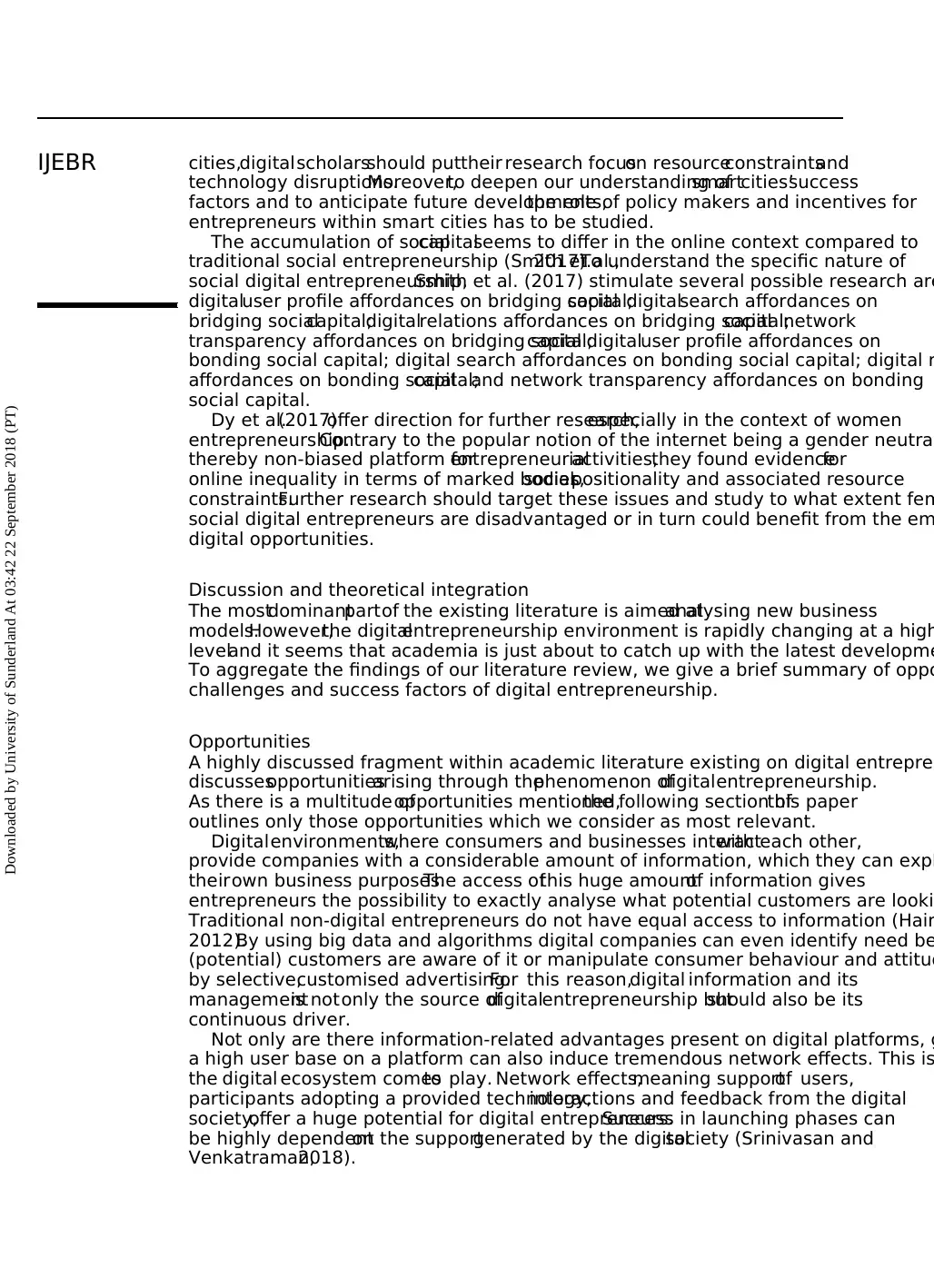
cities,digitalscholarsshould puttheir research focuson resourceconstraintsand
technology disruptions.Moreover,to deepen our understanding ofsmartcities’success
factors and to anticipate future developments,the role of policy makers and incentives for
entrepreneurs within smart cities has to be studied.
The accumulation of socialcapitalseems to differ in the online context compared to
traditional social entrepreneurship (Smith et al.,2017).To understand the specific nature of
social digital entrepreneurship,Smith et al. (2017) stimulate several possible research are
digitaluser profile affordances on bridging socialcapital;digitalsearch affordances on
bridging socialcapital;digitalrelations affordances on bridging socialcapital;network
transparency affordances on bridging socialcapital;digitaluser profile affordances on
bonding social capital; digital search affordances on bonding social capital; digital r
affordances on bonding socialcapital;and network transparency affordances on bonding
social capital.
Dy et al.(2017)offer direction for further research,especially in the context of women
entrepreneurship.Contrary to the popular notion of the internet being a gender neutral
thereby non-biased platform forentrepreneurialactivities,they found evidencefor
online inequality in terms of marked bodies,socialpositionality and associated resource
constraints.Further research should target these issues and study to what extent fem
social digital entrepreneurs are disadvantaged or in turn could benefit from the em
digital opportunities.
Discussion and theoretical integration
The mostdominantpartof the existing literature is aimed atanalysing new business
models.However,the digitalentrepreneurship environment is rapidly changing at a high
leveland it seems that academia is just about to catch up with the latest developme
To aggregate the findings of our literature review, we give a brief summary of oppo
challenges and success factors of digital entrepreneurship.
Opportunities
A highly discussed fragment within academic literature existing on digital entrepren
discussesopportunitiesarising through thephenomenon ofdigitalentrepreneurship.
As there is a multitude ofopportunities mentioned,the following section ofthis paper
outlines only those opportunities which we consider as most relevant.
Digitalenvironments,where consumers and businesses interactwith each other,
provide companies with a considerable amount of information, which they can expl
theirown business purposes.The access ofthis huge amountof information gives
entrepreneurs the possibility to exactly analyse what potential customers are looki
Traditional non-digital entrepreneurs do not have equal access to information (Hair
2012).By using big data and algorithms digital companies can even identify need be
(potential) customers are aware of it or manipulate consumer behaviour and attitud
by selective,customised advertising.For this reason,digital information and its
managementis notonly the source ofdigitalentrepreneurship butshould also be its
continuous driver.
Not only are there information-related advantages present on digital platforms, g
a high user base on a platform can also induce tremendous network effects. This is
the digital ecosystem comesto play. Network effects,meaning supportof users,
participants adopting a provided technology,interactions and feedback from the digital
society,offer a huge potential for digital entrepreneurs.Success in launching phases can
be highly dependenton the supportgenerated by the digitalsociety (Srinivasan and
Venkatraman,2018).
IJEBR
Downloaded by University of Sunderland At 03:42 22 September 2018 (PT)
technology disruptions.Moreover,to deepen our understanding ofsmartcities’success
factors and to anticipate future developments,the role of policy makers and incentives for
entrepreneurs within smart cities has to be studied.
The accumulation of socialcapitalseems to differ in the online context compared to
traditional social entrepreneurship (Smith et al.,2017).To understand the specific nature of
social digital entrepreneurship,Smith et al. (2017) stimulate several possible research are
digitaluser profile affordances on bridging socialcapital;digitalsearch affordances on
bridging socialcapital;digitalrelations affordances on bridging socialcapital;network
transparency affordances on bridging socialcapital;digitaluser profile affordances on
bonding social capital; digital search affordances on bonding social capital; digital r
affordances on bonding socialcapital;and network transparency affordances on bonding
social capital.
Dy et al.(2017)offer direction for further research,especially in the context of women
entrepreneurship.Contrary to the popular notion of the internet being a gender neutral
thereby non-biased platform forentrepreneurialactivities,they found evidencefor
online inequality in terms of marked bodies,socialpositionality and associated resource
constraints.Further research should target these issues and study to what extent fem
social digital entrepreneurs are disadvantaged or in turn could benefit from the em
digital opportunities.
Discussion and theoretical integration
The mostdominantpartof the existing literature is aimed atanalysing new business
models.However,the digitalentrepreneurship environment is rapidly changing at a high
leveland it seems that academia is just about to catch up with the latest developme
To aggregate the findings of our literature review, we give a brief summary of oppo
challenges and success factors of digital entrepreneurship.
Opportunities
A highly discussed fragment within academic literature existing on digital entrepren
discussesopportunitiesarising through thephenomenon ofdigitalentrepreneurship.
As there is a multitude ofopportunities mentioned,the following section ofthis paper
outlines only those opportunities which we consider as most relevant.
Digitalenvironments,where consumers and businesses interactwith each other,
provide companies with a considerable amount of information, which they can expl
theirown business purposes.The access ofthis huge amountof information gives
entrepreneurs the possibility to exactly analyse what potential customers are looki
Traditional non-digital entrepreneurs do not have equal access to information (Hair
2012).By using big data and algorithms digital companies can even identify need be
(potential) customers are aware of it or manipulate consumer behaviour and attitud
by selective,customised advertising.For this reason,digital information and its
managementis notonly the source ofdigitalentrepreneurship butshould also be its
continuous driver.
Not only are there information-related advantages present on digital platforms, g
a high user base on a platform can also induce tremendous network effects. This is
the digital ecosystem comesto play. Network effects,meaning supportof users,
participants adopting a provided technology,interactions and feedback from the digital
society,offer a huge potential for digital entrepreneurs.Success in launching phases can
be highly dependenton the supportgenerated by the digitalsociety (Srinivasan and
Venkatraman,2018).
IJEBR
Downloaded by University of Sunderland At 03:42 22 September 2018 (PT)
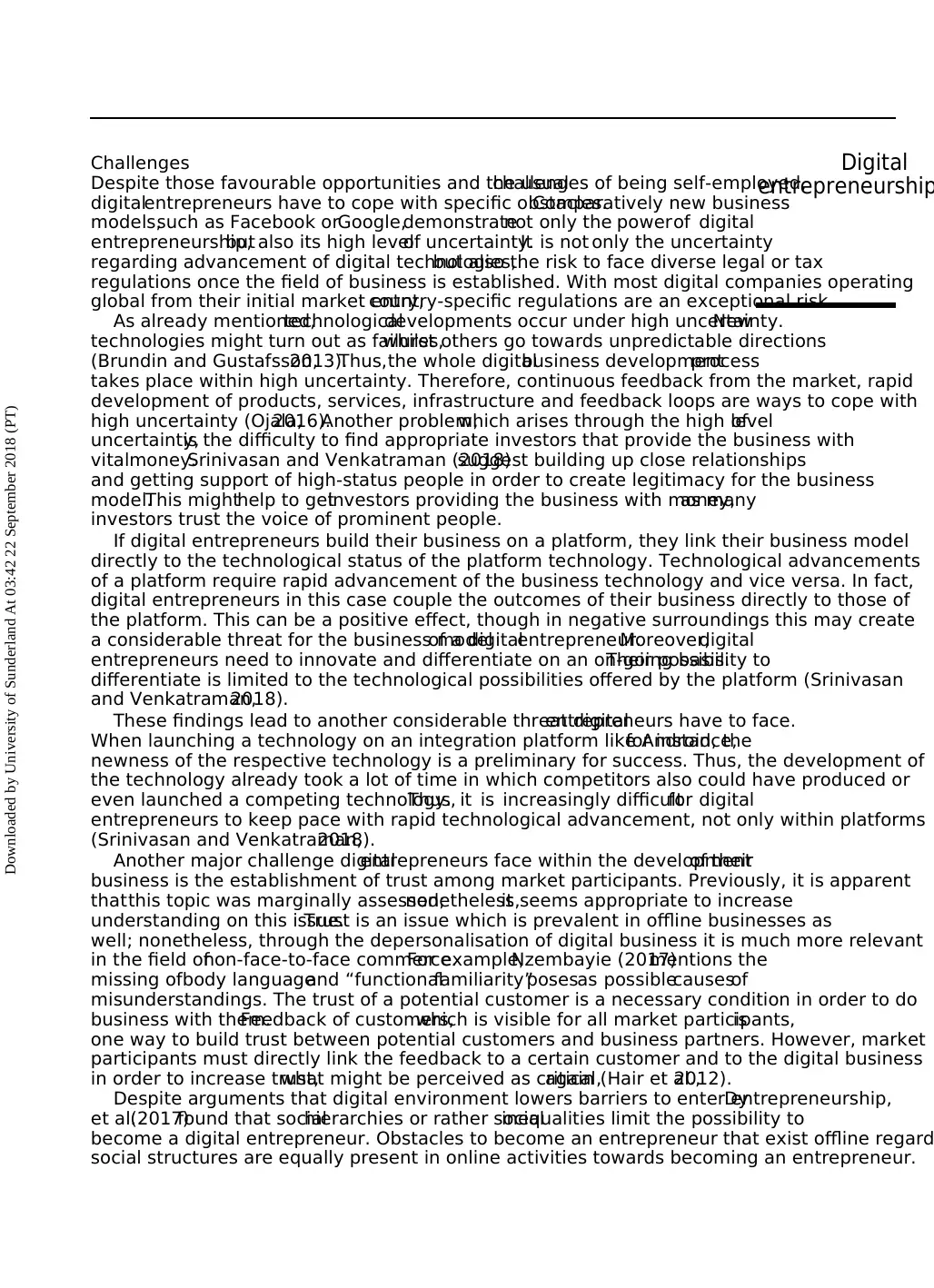
Challenges
Despite those favourable opportunities and the usualchallenges of being self-employed,
digitalentrepreneurs have to cope with specific obstacles.Comparatively new business
models,such as Facebook orGoogle,demonstratenot only the powerof digital
entrepreneurship,but also its high levelof uncertainty.It is not only the uncertainty
regarding advancement of digital technologies,but also the risk to face diverse legal or tax
regulations once the field of business is established. With most digital companies operating
global from their initial market entry,country-specific regulations are an exceptional risk.
As already mentioned,technologicaldevelopments occur under high uncertainty.New
technologies might turn out as failures,whilst others go towards unpredictable directions
(Brundin and Gustafsson,2013).Thus,the whole digitalbusiness developmentprocess
takes place within high uncertainty. Therefore, continuous feedback from the market, rapid
development of products, services, infrastructure and feedback loops are ways to cope with
high uncertainty (Ojala,2016).Another problem,which arises through the high levelof
uncertainty,is the difficulty to find appropriate investors that provide the business with
vitalmoney.Srinivasan and Venkatraman (2018)suggest building up close relationships
and getting support of high-status people in order to create legitimacy for the business
model.This mighthelp to getinvestors providing the business with money,as many
investors trust the voice of prominent people.
If digital entrepreneurs build their business on a platform, they link their business model
directly to the technological status of the platform technology. Technological advancements
of a platform require rapid advancement of the business technology and vice versa. In fact,
digital entrepreneurs in this case couple the outcomes of their business directly to those of
the platform. This can be a positive effect, though in negative surroundings this may create
a considerable threat for the business modelof a digitalentrepreneur.Moreover,digital
entrepreneurs need to innovate and differentiate on an on-going basis.Their possibility to
differentiate is limited to the technological possibilities offered by the platform (Srinivasan
and Venkatraman,2018).
These findings lead to another considerable threat digitalentrepreneurs have to face.
When launching a technology on an integration platform like Android,for instance,the
newness of the respective technology is a preliminary for success. Thus, the development of
the technology already took a lot of time in which competitors also could have produced or
even launched a competing technology.Thus, it is increasingly difficultfor digital
entrepreneurs to keep pace with rapid technological advancement, not only within platforms
(Srinivasan and Venkatraman,2018).
Another major challenge digitalentrepreneurs face within the developmentof their
business is the establishment of trust among market participants. Previously, it is apparent
thatthis topic was marginally assessed;nonetheless,it seems appropriate to increase
understanding on this issue.Trust is an issue which is prevalent in offline businesses as
well; nonetheless, through the depersonalisation of digital business it is much more relevant
in the field ofnon-face-to-face commerce.For example,Nzembayie (2017)mentions the
missing ofbody languageand “functionalfamiliarity”posesas possiblecausesof
misunderstandings. The trust of a potential customer is a necessary condition in order to do
business with them.Feedback of customers,which is visible for all market participants,is
one way to build trust between potential customers and business partners. However, market
participants must directly link the feedback to a certain customer and to the digital business
in order to increase trust,what might be perceived as critical,again (Hair et al.,2012).
Despite arguments that digital environment lowers barriers to enter entrepreneurship,Dy
et al.(2017)found that socialhierarchies or rather socialinequalities limit the possibility to
become a digital entrepreneur. Obstacles to become an entrepreneur that exist offline regard
social structures are equally present in online activities towards becoming an entrepreneur.
Digital
entrepreneurship
Downloaded by University of Sunderland At 03:42 22 September 2018 (PT)
Despite those favourable opportunities and the usualchallenges of being self-employed,
digitalentrepreneurs have to cope with specific obstacles.Comparatively new business
models,such as Facebook orGoogle,demonstratenot only the powerof digital
entrepreneurship,but also its high levelof uncertainty.It is not only the uncertainty
regarding advancement of digital technologies,but also the risk to face diverse legal or tax
regulations once the field of business is established. With most digital companies operating
global from their initial market entry,country-specific regulations are an exceptional risk.
As already mentioned,technologicaldevelopments occur under high uncertainty.New
technologies might turn out as failures,whilst others go towards unpredictable directions
(Brundin and Gustafsson,2013).Thus,the whole digitalbusiness developmentprocess
takes place within high uncertainty. Therefore, continuous feedback from the market, rapid
development of products, services, infrastructure and feedback loops are ways to cope with
high uncertainty (Ojala,2016).Another problem,which arises through the high levelof
uncertainty,is the difficulty to find appropriate investors that provide the business with
vitalmoney.Srinivasan and Venkatraman (2018)suggest building up close relationships
and getting support of high-status people in order to create legitimacy for the business
model.This mighthelp to getinvestors providing the business with money,as many
investors trust the voice of prominent people.
If digital entrepreneurs build their business on a platform, they link their business model
directly to the technological status of the platform technology. Technological advancements
of a platform require rapid advancement of the business technology and vice versa. In fact,
digital entrepreneurs in this case couple the outcomes of their business directly to those of
the platform. This can be a positive effect, though in negative surroundings this may create
a considerable threat for the business modelof a digitalentrepreneur.Moreover,digital
entrepreneurs need to innovate and differentiate on an on-going basis.Their possibility to
differentiate is limited to the technological possibilities offered by the platform (Srinivasan
and Venkatraman,2018).
These findings lead to another considerable threat digitalentrepreneurs have to face.
When launching a technology on an integration platform like Android,for instance,the
newness of the respective technology is a preliminary for success. Thus, the development of
the technology already took a lot of time in which competitors also could have produced or
even launched a competing technology.Thus, it is increasingly difficultfor digital
entrepreneurs to keep pace with rapid technological advancement, not only within platforms
(Srinivasan and Venkatraman,2018).
Another major challenge digitalentrepreneurs face within the developmentof their
business is the establishment of trust among market participants. Previously, it is apparent
thatthis topic was marginally assessed;nonetheless,it seems appropriate to increase
understanding on this issue.Trust is an issue which is prevalent in offline businesses as
well; nonetheless, through the depersonalisation of digital business it is much more relevant
in the field ofnon-face-to-face commerce.For example,Nzembayie (2017)mentions the
missing ofbody languageand “functionalfamiliarity”posesas possiblecausesof
misunderstandings. The trust of a potential customer is a necessary condition in order to do
business with them.Feedback of customers,which is visible for all market participants,is
one way to build trust between potential customers and business partners. However, market
participants must directly link the feedback to a certain customer and to the digital business
in order to increase trust,what might be perceived as critical,again (Hair et al.,2012).
Despite arguments that digital environment lowers barriers to enter entrepreneurship,Dy
et al.(2017)found that socialhierarchies or rather socialinequalities limit the possibility to
become a digital entrepreneur. Obstacles to become an entrepreneur that exist offline regard
social structures are equally present in online activities towards becoming an entrepreneur.
Digital
entrepreneurship
Downloaded by University of Sunderland At 03:42 22 September 2018 (PT)
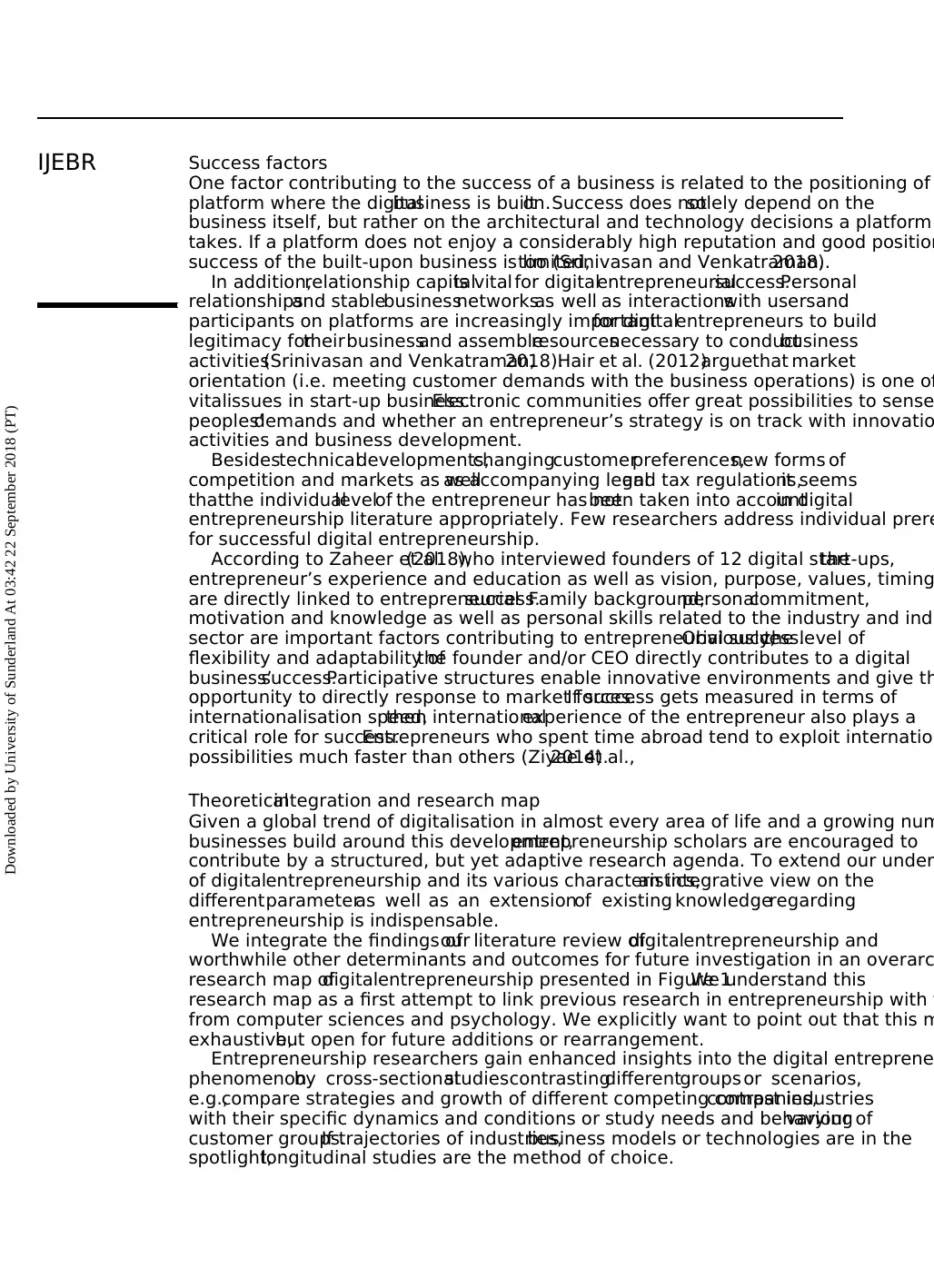
Success factors
One factor contributing to the success of a business is related to the positioning of
platform where the digitalbusiness is builton.Success does notsolely depend on the
business itself, but rather on the architectural and technology decisions a platform
takes. If a platform does not enjoy a considerably high reputation and good position
success of the built-upon business is limited,too (Srinivasan and Venkatraman,2018).
In addition,relationship capitalis vital for digitalentrepreneurialsuccess.Personal
relationshipsand stablebusinessnetworksas well as interactionswith usersand
participants on platforms are increasingly importantfor digitalentrepreneurs to build
legitimacy fortheirbusinessand assembleresourcesnecessary to conductbusiness
activities(Srinivasan and Venkatraman,2018).Hair et al. (2012)arguethat market
orientation (i.e. meeting customer demands with the business operations) is one of
vitalissues in start-up business.Electronic communities offer great possibilities to sense
peoples’demands and whether an entrepreneur’s strategy is on track with innovatio
activities and business development.
Besidestechnicaldevelopments,changingcustomerpreferences,new forms of
competition and markets as wellas accompanying legaland tax regulations,it seems
thatthe individuallevelof the entrepreneur has notbeen taken into accountin digital
entrepreneurship literature appropriately. Few researchers address individual prere
for successful digital entrepreneurship.
According to Zaheer et al.(2018),who interviewed founders of 12 digital start-ups,the
entrepreneur’s experience and education as well as vision, purpose, values, timing
are directly linked to entrepreneurialsuccess.Family background,personalcommitment,
motivation and knowledge as well as personal skills related to the industry and indu
sector are important factors contributing to entrepreneurial success.Obviously,the level of
flexibility and adaptability ofthe founder and/or CEO directly contributes to a digital
business’success.Participative structures enable innovative environments and give th
opportunity to directly response to market forces.If success gets measured in terms of
internationalisation speed,then internationalexperience of the entrepreneur also plays a
critical role for success.Entrepreneurs who spent time abroad tend to exploit internation
possibilities much faster than others (Ziyae et al.,2014).
Theoreticalintegration and research map
Given a global trend of digitalisation in almost every area of life and a growing num
businesses build around this development,entrepreneurship scholars are encouraged to
contribute by a structured, but yet adaptive research agenda. To extend our under
of digitalentrepreneurship and its various characteristics,an integrative view on the
differentparameteras well as an extensionof existing knowledgeregarding
entrepreneurship is indispensable.
We integrate the findings ofour literature review ofdigitalentrepreneurship and
worthwhile other determinants and outcomes for future investigation in an overarc
research map ofdigitalentrepreneurship presented in Figure 1.We understand this
research map as a first attempt to link previous research in entrepreneurship with fi
from computer sciences and psychology. We explicitly want to point out that this m
exhaustive,but open for future additions or rearrangement.
Entrepreneurship researchers gain enhanced insights into the digital entreprene
phenomenonby cross-sectionalstudiescontrastingdifferentgroups or scenarios,
e.g.,compare strategies and growth of different competing companies,contrast industries
with their specific dynamics and conditions or study needs and behaviour ofvarying
customer groups.If trajectories of industries,business models or technologies are in the
spotlight,longitudinal studies are the method of choice.
IJEBR
Downloaded by University of Sunderland At 03:42 22 September 2018 (PT)
One factor contributing to the success of a business is related to the positioning of
platform where the digitalbusiness is builton.Success does notsolely depend on the
business itself, but rather on the architectural and technology decisions a platform
takes. If a platform does not enjoy a considerably high reputation and good position
success of the built-upon business is limited,too (Srinivasan and Venkatraman,2018).
In addition,relationship capitalis vital for digitalentrepreneurialsuccess.Personal
relationshipsand stablebusinessnetworksas well as interactionswith usersand
participants on platforms are increasingly importantfor digitalentrepreneurs to build
legitimacy fortheirbusinessand assembleresourcesnecessary to conductbusiness
activities(Srinivasan and Venkatraman,2018).Hair et al. (2012)arguethat market
orientation (i.e. meeting customer demands with the business operations) is one of
vitalissues in start-up business.Electronic communities offer great possibilities to sense
peoples’demands and whether an entrepreneur’s strategy is on track with innovatio
activities and business development.
Besidestechnicaldevelopments,changingcustomerpreferences,new forms of
competition and markets as wellas accompanying legaland tax regulations,it seems
thatthe individuallevelof the entrepreneur has notbeen taken into accountin digital
entrepreneurship literature appropriately. Few researchers address individual prere
for successful digital entrepreneurship.
According to Zaheer et al.(2018),who interviewed founders of 12 digital start-ups,the
entrepreneur’s experience and education as well as vision, purpose, values, timing
are directly linked to entrepreneurialsuccess.Family background,personalcommitment,
motivation and knowledge as well as personal skills related to the industry and indu
sector are important factors contributing to entrepreneurial success.Obviously,the level of
flexibility and adaptability ofthe founder and/or CEO directly contributes to a digital
business’success.Participative structures enable innovative environments and give th
opportunity to directly response to market forces.If success gets measured in terms of
internationalisation speed,then internationalexperience of the entrepreneur also plays a
critical role for success.Entrepreneurs who spent time abroad tend to exploit internation
possibilities much faster than others (Ziyae et al.,2014).
Theoreticalintegration and research map
Given a global trend of digitalisation in almost every area of life and a growing num
businesses build around this development,entrepreneurship scholars are encouraged to
contribute by a structured, but yet adaptive research agenda. To extend our under
of digitalentrepreneurship and its various characteristics,an integrative view on the
differentparameteras well as an extensionof existing knowledgeregarding
entrepreneurship is indispensable.
We integrate the findings ofour literature review ofdigitalentrepreneurship and
worthwhile other determinants and outcomes for future investigation in an overarc
research map ofdigitalentrepreneurship presented in Figure 1.We understand this
research map as a first attempt to link previous research in entrepreneurship with fi
from computer sciences and psychology. We explicitly want to point out that this m
exhaustive,but open for future additions or rearrangement.
Entrepreneurship researchers gain enhanced insights into the digital entreprene
phenomenonby cross-sectionalstudiescontrastingdifferentgroups or scenarios,
e.g.,compare strategies and growth of different competing companies,contrast industries
with their specific dynamics and conditions or study needs and behaviour ofvarying
customer groups.If trajectories of industries,business models or technologies are in the
spotlight,longitudinal studies are the method of choice.
IJEBR
Downloaded by University of Sunderland At 03:42 22 September 2018 (PT)
Paraphrase This Document
Need a fresh take? Get an instant paraphrase of this document with our AI Paraphraser
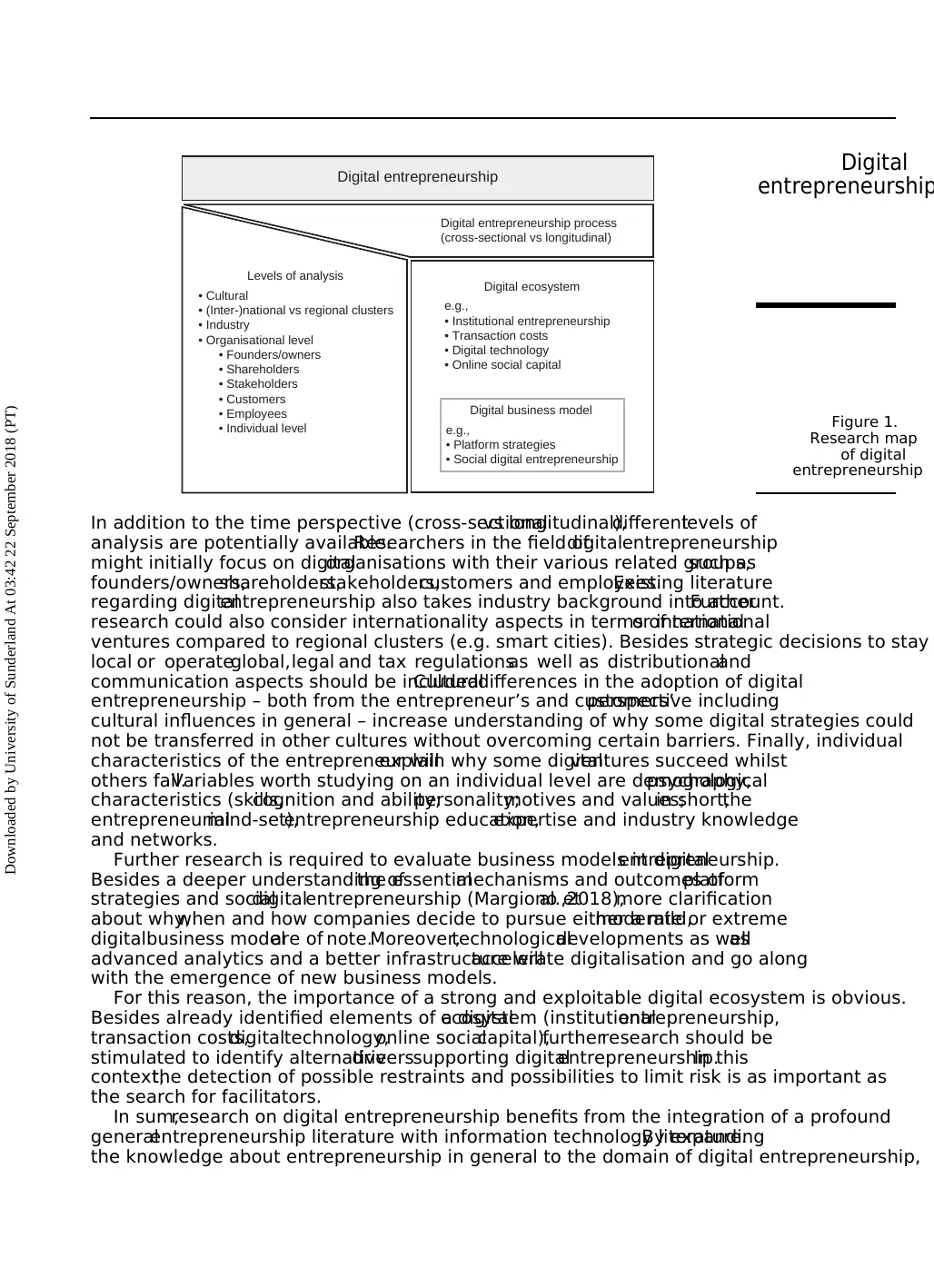
In addition to the time perspective (cross-sectionalvs longitudinal),differentlevels of
analysis are potentially available.Researchers in the field ofdigitalentrepreneurship
might initially focus on digitalorganisations with their various related groups,such as
founders/owners,shareholders,stakeholders,customers and employees.Existing literature
regarding digitalentrepreneurship also takes industry background into account.Further
research could also consider internationality aspects in terms of nationalor international
ventures compared to regional clusters (e.g. smart cities). Besides strategic decisions to stay
local or operateglobal,legal and tax regulationsas well as distributionaland
communication aspects should be included.Culturaldifferences in the adoption of digital
entrepreneurship – both from the entrepreneur’s and customers’perspective including
cultural influences in general – increase understanding of why some digital strategies could
not be transferred in other cultures without overcoming certain barriers. Finally, individual
characteristics of the entrepreneur willexplain why some digitalventures succeed whilst
others fail.Variables worth studying on an individual level are demography,psychological
characteristics (skills,cognition and ability;personality;motives and values;in short,the
entrepreneurialmind-set),entrepreneurship education,expertise and industry knowledge
and networks.
Further research is required to evaluate business models in digitalentrepreneurship.
Besides a deeper understanding ofthe essentialmechanisms and outcomes ofplatform
strategies and socialdigitalentrepreneurship (Margiono etal.,2018),more clarification
about why,when and how companies decide to pursue either a mild,moderate or extreme
digitalbusiness modelare of note.Moreover,technologicaldevelopments as wellas
advanced analytics and a better infrastructure willaccelerate digitalisation and go along
with the emergence of new business models.
For this reason, the importance of a strong and exploitable digital ecosystem is obvious.
Besides already identified elements of a digitalecosystem (institutionalentrepreneurship,
transaction costs,digitaltechnology,online socialcapital),furtherresearch should be
stimulated to identify alternativedriverssupporting digitalentrepreneurship.In this
context,the detection of possible restraints and possibilities to limit risk is as important as
the search for facilitators.
In sum,research on digital entrepreneurship benefits from the integration of a profound
generalentrepreneurship literature with information technology literature.By expanding
the knowledge about entrepreneurship in general to the domain of digital entrepreneurship,
Digital entrepreneurship process
(cross-sectional vs longitudinal)
Levels of analysis Digital ecosystem
Digital business model
• Cultural
• (Inter-)national vs regional clusters
• Industry
• Organisational level
• Founders/owners
• Shareholders
• Stakeholders
• Customers
• Employees
• Individual level
e.g.,
• Institutional entrepreneurship
• Transaction costs
• Digital technology
• Online social capital
e.g.,
• Platform strategies
• Social digital entrepreneurship
Digital entrepreneurship
Figure 1.
Research map
of digital
entrepreneurship
Digital
entrepreneurship
Downloaded by University of Sunderland At 03:42 22 September 2018 (PT)
analysis are potentially available.Researchers in the field ofdigitalentrepreneurship
might initially focus on digitalorganisations with their various related groups,such as
founders/owners,shareholders,stakeholders,customers and employees.Existing literature
regarding digitalentrepreneurship also takes industry background into account.Further
research could also consider internationality aspects in terms of nationalor international
ventures compared to regional clusters (e.g. smart cities). Besides strategic decisions to stay
local or operateglobal,legal and tax regulationsas well as distributionaland
communication aspects should be included.Culturaldifferences in the adoption of digital
entrepreneurship – both from the entrepreneur’s and customers’perspective including
cultural influences in general – increase understanding of why some digital strategies could
not be transferred in other cultures without overcoming certain barriers. Finally, individual
characteristics of the entrepreneur willexplain why some digitalventures succeed whilst
others fail.Variables worth studying on an individual level are demography,psychological
characteristics (skills,cognition and ability;personality;motives and values;in short,the
entrepreneurialmind-set),entrepreneurship education,expertise and industry knowledge
and networks.
Further research is required to evaluate business models in digitalentrepreneurship.
Besides a deeper understanding ofthe essentialmechanisms and outcomes ofplatform
strategies and socialdigitalentrepreneurship (Margiono etal.,2018),more clarification
about why,when and how companies decide to pursue either a mild,moderate or extreme
digitalbusiness modelare of note.Moreover,technologicaldevelopments as wellas
advanced analytics and a better infrastructure willaccelerate digitalisation and go along
with the emergence of new business models.
For this reason, the importance of a strong and exploitable digital ecosystem is obvious.
Besides already identified elements of a digitalecosystem (institutionalentrepreneurship,
transaction costs,digitaltechnology,online socialcapital),furtherresearch should be
stimulated to identify alternativedriverssupporting digitalentrepreneurship.In this
context,the detection of possible restraints and possibilities to limit risk is as important as
the search for facilitators.
In sum,research on digital entrepreneurship benefits from the integration of a profound
generalentrepreneurship literature with information technology literature.By expanding
the knowledge about entrepreneurship in general to the domain of digital entrepreneurship,
Digital entrepreneurship process
(cross-sectional vs longitudinal)
Levels of analysis Digital ecosystem
Digital business model
• Cultural
• (Inter-)national vs regional clusters
• Industry
• Organisational level
• Founders/owners
• Shareholders
• Stakeholders
• Customers
• Employees
• Individual level
e.g.,
• Institutional entrepreneurship
• Transaction costs
• Digital technology
• Online social capital
e.g.,
• Platform strategies
• Social digital entrepreneurship
Digital entrepreneurship
Figure 1.
Research map
of digital
entrepreneurship
Digital
entrepreneurship
Downloaded by University of Sunderland At 03:42 22 September 2018 (PT)
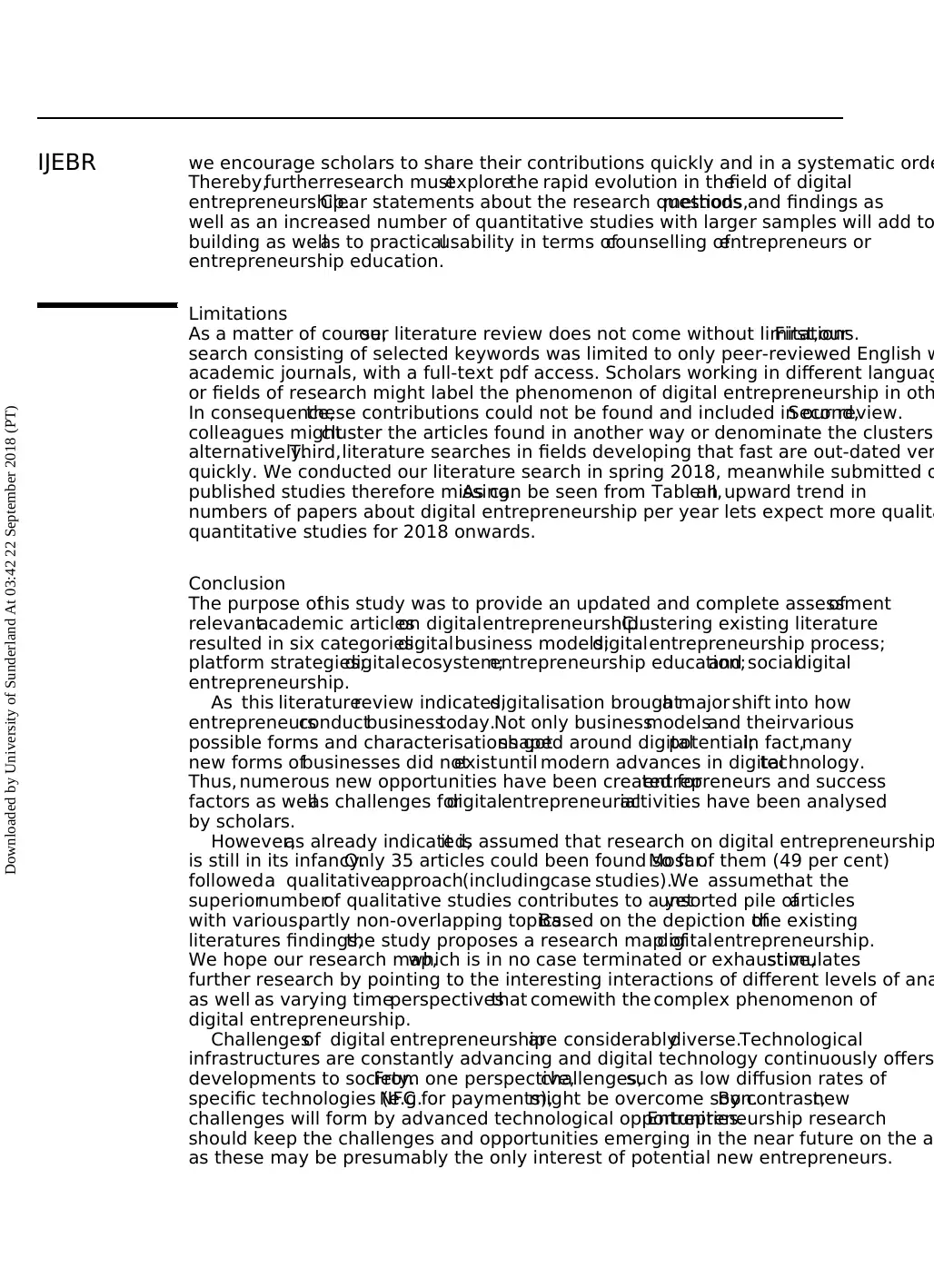
we encourage scholars to share their contributions quickly and in a systematic orde
Thereby,furtherresearch mustexplorethe rapid evolution in thefield of digital
entrepreneurship.Clear statements about the research questions,methods and findings as
well as an increased number of quantitative studies with larger samples will add to
building as wellas to practicalusability in terms ofcounselling ofentrepreneurs or
entrepreneurship education.
Limitations
As a matter of course,our literature review does not come without limitations.First,our
search consisting of selected keywords was limited to only peer-reviewed English w
academic journals, with a full-text pdf access. Scholars working in different languag
or fields of research might label the phenomenon of digital entrepreneurship in oth
In consequence,these contributions could not be found and included in our review.Second,
colleagues mightcluster the articles found in another way or denominate the clusters
alternatively.Third,literature searches in fields developing that fast are out-dated ver
quickly. We conducted our literature search in spring 2018, meanwhile submitted o
published studies therefore missing.As can be seen from Table II,an upward trend in
numbers of papers about digital entrepreneurship per year lets expect more qualita
quantitative studies for 2018 onwards.
Conclusion
The purpose ofthis study was to provide an updated and complete assessmentof
relevantacademic articleson digitalentrepreneurship.Clustering existing literature
resulted in six categories:digitalbusiness models;digitalentrepreneurship process;
platform strategies;digitalecosystem;entrepreneurship education;and socialdigital
entrepreneurship.
As this literaturereview indicates,digitalisation broughta major shift into how
entrepreneursconductbusinesstoday.Not only businessmodelsand theirvarious
possible forms and characterisations gotshaped around digitalpotential;in fact,many
new forms ofbusinesses did notexistuntil modern advances in digitaltechnology.
Thus, numerous new opportunities have been created forentrepreneurs and success
factors as wellas challenges fordigitalentrepreneurialactivities have been analysed
by scholars.
However,as already indicated,it is assumed that research on digital entrepreneurship
is still in its infancy.Only 35 articles could been found so far.Most of them (49 per cent)
followeda qualitativeapproach(includingcase studies).We assumethat the
superiornumberof qualitative studies contributes to a yetunsorted pile ofarticles
with various,partly non-overlapping topics.Based on the depiction ofthe existing
literatures findings,the study proposes a research map ofdigitalentrepreneurship.
We hope our research map,which is in no case terminated or exhaustive,stimulates
further research by pointing to the interesting interactions of different levels of ana
as well as varying timeperspectivesthat comewith the complex phenomenon of
digital entrepreneurship.
Challengesof digital entrepreneurshipare considerablydiverse.Technological
infrastructures are constantly advancing and digital technology continuously offers
developments to society.From one perspective,challenges,such as low diffusion rates of
specific technologies (e.g.NFC for payments),might be overcome soon.By contrast,new
challenges will form by advanced technological opportunities.Entrepreneurship research
should keep the challenges and opportunities emerging in the near future on the a
as these may be presumably the only interest of potential new entrepreneurs.
IJEBR
Downloaded by University of Sunderland At 03:42 22 September 2018 (PT)
Thereby,furtherresearch mustexplorethe rapid evolution in thefield of digital
entrepreneurship.Clear statements about the research questions,methods and findings as
well as an increased number of quantitative studies with larger samples will add to
building as wellas to practicalusability in terms ofcounselling ofentrepreneurs or
entrepreneurship education.
Limitations
As a matter of course,our literature review does not come without limitations.First,our
search consisting of selected keywords was limited to only peer-reviewed English w
academic journals, with a full-text pdf access. Scholars working in different languag
or fields of research might label the phenomenon of digital entrepreneurship in oth
In consequence,these contributions could not be found and included in our review.Second,
colleagues mightcluster the articles found in another way or denominate the clusters
alternatively.Third,literature searches in fields developing that fast are out-dated ver
quickly. We conducted our literature search in spring 2018, meanwhile submitted o
published studies therefore missing.As can be seen from Table II,an upward trend in
numbers of papers about digital entrepreneurship per year lets expect more qualita
quantitative studies for 2018 onwards.
Conclusion
The purpose ofthis study was to provide an updated and complete assessmentof
relevantacademic articleson digitalentrepreneurship.Clustering existing literature
resulted in six categories:digitalbusiness models;digitalentrepreneurship process;
platform strategies;digitalecosystem;entrepreneurship education;and socialdigital
entrepreneurship.
As this literaturereview indicates,digitalisation broughta major shift into how
entrepreneursconductbusinesstoday.Not only businessmodelsand theirvarious
possible forms and characterisations gotshaped around digitalpotential;in fact,many
new forms ofbusinesses did notexistuntil modern advances in digitaltechnology.
Thus, numerous new opportunities have been created forentrepreneurs and success
factors as wellas challenges fordigitalentrepreneurialactivities have been analysed
by scholars.
However,as already indicated,it is assumed that research on digital entrepreneurship
is still in its infancy.Only 35 articles could been found so far.Most of them (49 per cent)
followeda qualitativeapproach(includingcase studies).We assumethat the
superiornumberof qualitative studies contributes to a yetunsorted pile ofarticles
with various,partly non-overlapping topics.Based on the depiction ofthe existing
literatures findings,the study proposes a research map ofdigitalentrepreneurship.
We hope our research map,which is in no case terminated or exhaustive,stimulates
further research by pointing to the interesting interactions of different levels of ana
as well as varying timeperspectivesthat comewith the complex phenomenon of
digital entrepreneurship.
Challengesof digital entrepreneurshipare considerablydiverse.Technological
infrastructures are constantly advancing and digital technology continuously offers
developments to society.From one perspective,challenges,such as low diffusion rates of
specific technologies (e.g.NFC for payments),might be overcome soon.By contrast,new
challenges will form by advanced technological opportunities.Entrepreneurship research
should keep the challenges and opportunities emerging in the near future on the a
as these may be presumably the only interest of potential new entrepreneurs.
IJEBR
Downloaded by University of Sunderland At 03:42 22 September 2018 (PT)
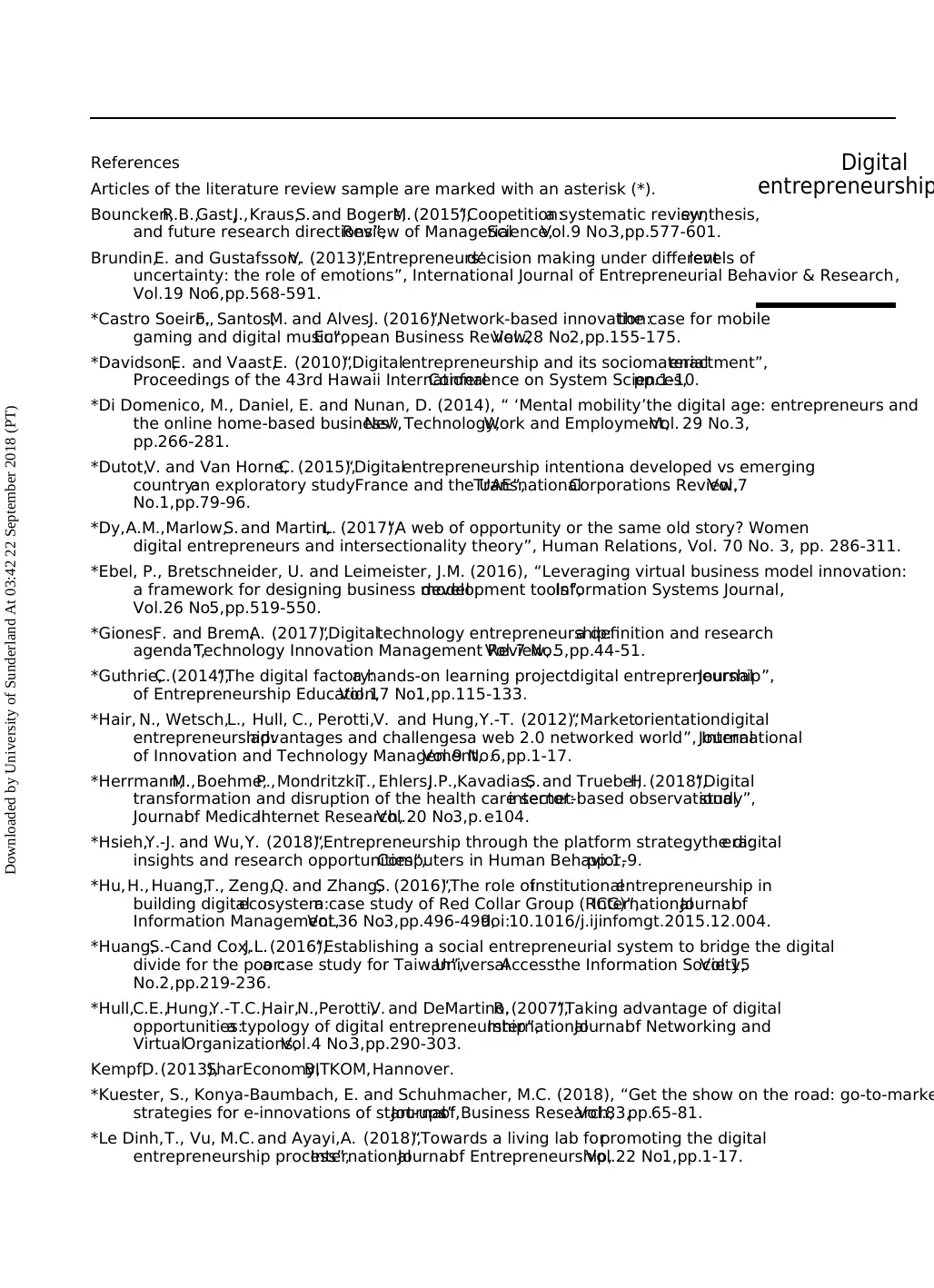
References
Articles of the literature review sample are marked with an asterisk (*).
Bouncken,R.B.,Gast,J.,Kraus,S.and Bogers,M. (2015),“Coopetition:a systematic review,synthesis,
and future research directions”,Review of ManagerialScience,Vol.9 No.3,pp.577-601.
Brundin,E. and Gustafsson,V. (2013),“Entrepreneurs’decision making under differentlevels of
uncertainty: the role of emotions”, International Journal of Entrepreneurial Behavior & Research,
Vol.19 No.6,pp.568-591.
*Castro Soeiro,F., Santos,M. and Alves,J. (2016),“Network-based innovation:the case for mobile
gaming and digital music”,European Business Review,Vol.28 No.2,pp.155-175.
*Davidson,E. and Vaast,E. (2010),“Digitalentrepreneurship and its sociomaterialenactment”,
Proceedings of the 43rd Hawaii InternationalConference on System Sciences,pp.1-10.
*Di Domenico, M., Daniel, E. and Nunan, D. (2014), “ ‘Mental mobility’the digital age: entrepreneurs and
the online home-based business”,New Technology,Work and Employment,Vol. 29 No.3,
pp.266-281.
*Dutot,V. and Van Horne,C. (2015),“Digitalentrepreneurship intentiona developed vs emerging
country:an exploratory studyFrance and the UAE”,TransnationalCorporations Review,Vol.7
No.1,pp.79-96.
*Dy,A.M.,Marlow,S. and Martin,L. (2017),“A web of opportunity or the same old story? Women
digital entrepreneurs and intersectionality theory”, Human Relations, Vol. 70 No. 3, pp. 286-311.
*Ebel, P., Bretschneider, U. and Leimeister, J.M. (2016), “Leveraging virtual business model innovation:
a framework for designing business modeldevelopment tools”,Information Systems Journal,
Vol.26 No.5,pp.519-550.
*Giones,F. and Brem,A. (2017),“Digitaltechnology entrepreneurship:a definition and research
agenda”,Technology Innovation Management Review,Vol.7 No.5,pp.44-51.
*Guthrie,C.(2014),“The digital factory:a hands-on learning projectdigital entrepreneurship”,Journal
of Entrepreneurship Education,Vol.17 No.1,pp.115-133.
*Hair, N., Wetsch,L., Hull, C., Perotti,V. and Hung,Y.-T. (2012),“Marketorientationdigital
entrepreneurship:advantages and challengesa web 2.0 networked world”, InternationalJournal
of Innovation and Technology Management,Vol.9 No.6,pp.1-17.
*Herrmann,M.,Boehme,P.,Mondritzki,T., Ehlers,J.P.,Kavadias,S.and Truebel,H. (2018),“Digital
transformation and disruption of the health care sector:internet-based observationalstudy”,
Journalof MedicalInternet Research,Vol.20 No.3,p.e104.
*Hsieh,Y.-J. and Wu,Y. (2018),“Entrepreneurship through the platform strategythe digitalera:
insights and research opportunities”,Computers in Human Behavior,pp.1-9.
*Hu, H., Huang,T., Zeng,Q. and Zhang,S. (2016),“The role ofinstitutionalentrepreneurship in
building digitalecosystem:a case study of Red Collar Group (RCG)”,InternationalJournalof
Information Management,Vol.36 No.3,pp.496-499,doi:10.1016/j.ijinfomgt.2015.12.004.
*Huang,S.-C.and Cox,J.L. (2016),“Establishing a social entrepreneurial system to bridge the digital
divide for the poor:a case study for Taiwan”,UniversalAccessthe Information Society,Vol.15
No.2,pp.219-236.
*Hull,C.E.,Hung,Y.-T.C.,Hair,N.,Perotti,V. and DeMartino,R.(2007),“Taking advantage of digital
opportunities:a typology of digital entrepreneurship”,InternationalJournalof Networking and
VirtualOrganizations,Vol.4 No.3,pp.290-303.
Kempf,D.(2013),SharEconomy,BITKOM,Hannover.
*Kuester, S., Konya-Baumbach, E. and Schuhmacher, M.C. (2018), “Get the show on the road: go-to-marke
strategies for e-innovations of start-ups”,Journalof Business Research,Vol.83,pp.65-81.
*Le Dinh,T., Vu, M.C. and Ayayi,A. (2018),“Towards a living lab forpromoting the digital
entrepreneurship process”,InternationalJournalof Entrepreneurship,Vol.22 No.1,pp.1-17.
Digital
entrepreneurship
Downloaded by University of Sunderland At 03:42 22 September 2018 (PT)
Articles of the literature review sample are marked with an asterisk (*).
Bouncken,R.B.,Gast,J.,Kraus,S.and Bogers,M. (2015),“Coopetition:a systematic review,synthesis,
and future research directions”,Review of ManagerialScience,Vol.9 No.3,pp.577-601.
Brundin,E. and Gustafsson,V. (2013),“Entrepreneurs’decision making under differentlevels of
uncertainty: the role of emotions”, International Journal of Entrepreneurial Behavior & Research,
Vol.19 No.6,pp.568-591.
*Castro Soeiro,F., Santos,M. and Alves,J. (2016),“Network-based innovation:the case for mobile
gaming and digital music”,European Business Review,Vol.28 No.2,pp.155-175.
*Davidson,E. and Vaast,E. (2010),“Digitalentrepreneurship and its sociomaterialenactment”,
Proceedings of the 43rd Hawaii InternationalConference on System Sciences,pp.1-10.
*Di Domenico, M., Daniel, E. and Nunan, D. (2014), “ ‘Mental mobility’the digital age: entrepreneurs and
the online home-based business”,New Technology,Work and Employment,Vol. 29 No.3,
pp.266-281.
*Dutot,V. and Van Horne,C. (2015),“Digitalentrepreneurship intentiona developed vs emerging
country:an exploratory studyFrance and the UAE”,TransnationalCorporations Review,Vol.7
No.1,pp.79-96.
*Dy,A.M.,Marlow,S. and Martin,L. (2017),“A web of opportunity or the same old story? Women
digital entrepreneurs and intersectionality theory”, Human Relations, Vol. 70 No. 3, pp. 286-311.
*Ebel, P., Bretschneider, U. and Leimeister, J.M. (2016), “Leveraging virtual business model innovation:
a framework for designing business modeldevelopment tools”,Information Systems Journal,
Vol.26 No.5,pp.519-550.
*Giones,F. and Brem,A. (2017),“Digitaltechnology entrepreneurship:a definition and research
agenda”,Technology Innovation Management Review,Vol.7 No.5,pp.44-51.
*Guthrie,C.(2014),“The digital factory:a hands-on learning projectdigital entrepreneurship”,Journal
of Entrepreneurship Education,Vol.17 No.1,pp.115-133.
*Hair, N., Wetsch,L., Hull, C., Perotti,V. and Hung,Y.-T. (2012),“Marketorientationdigital
entrepreneurship:advantages and challengesa web 2.0 networked world”, InternationalJournal
of Innovation and Technology Management,Vol.9 No.6,pp.1-17.
*Herrmann,M.,Boehme,P.,Mondritzki,T., Ehlers,J.P.,Kavadias,S.and Truebel,H. (2018),“Digital
transformation and disruption of the health care sector:internet-based observationalstudy”,
Journalof MedicalInternet Research,Vol.20 No.3,p.e104.
*Hsieh,Y.-J. and Wu,Y. (2018),“Entrepreneurship through the platform strategythe digitalera:
insights and research opportunities”,Computers in Human Behavior,pp.1-9.
*Hu, H., Huang,T., Zeng,Q. and Zhang,S. (2016),“The role ofinstitutionalentrepreneurship in
building digitalecosystem:a case study of Red Collar Group (RCG)”,InternationalJournalof
Information Management,Vol.36 No.3,pp.496-499,doi:10.1016/j.ijinfomgt.2015.12.004.
*Huang,S.-C.and Cox,J.L. (2016),“Establishing a social entrepreneurial system to bridge the digital
divide for the poor:a case study for Taiwan”,UniversalAccessthe Information Society,Vol.15
No.2,pp.219-236.
*Hull,C.E.,Hung,Y.-T.C.,Hair,N.,Perotti,V. and DeMartino,R.(2007),“Taking advantage of digital
opportunities:a typology of digital entrepreneurship”,InternationalJournalof Networking and
VirtualOrganizations,Vol.4 No.3,pp.290-303.
Kempf,D.(2013),SharEconomy,BITKOM,Hannover.
*Kuester, S., Konya-Baumbach, E. and Schuhmacher, M.C. (2018), “Get the show on the road: go-to-marke
strategies for e-innovations of start-ups”,Journalof Business Research,Vol.83,pp.65-81.
*Le Dinh,T., Vu, M.C. and Ayayi,A. (2018),“Towards a living lab forpromoting the digital
entrepreneurship process”,InternationalJournalof Entrepreneurship,Vol.22 No.1,pp.1-17.
Digital
entrepreneurship
Downloaded by University of Sunderland At 03:42 22 September 2018 (PT)
Secure Best Marks with AI Grader
Need help grading? Try our AI Grader for instant feedback on your assignments.
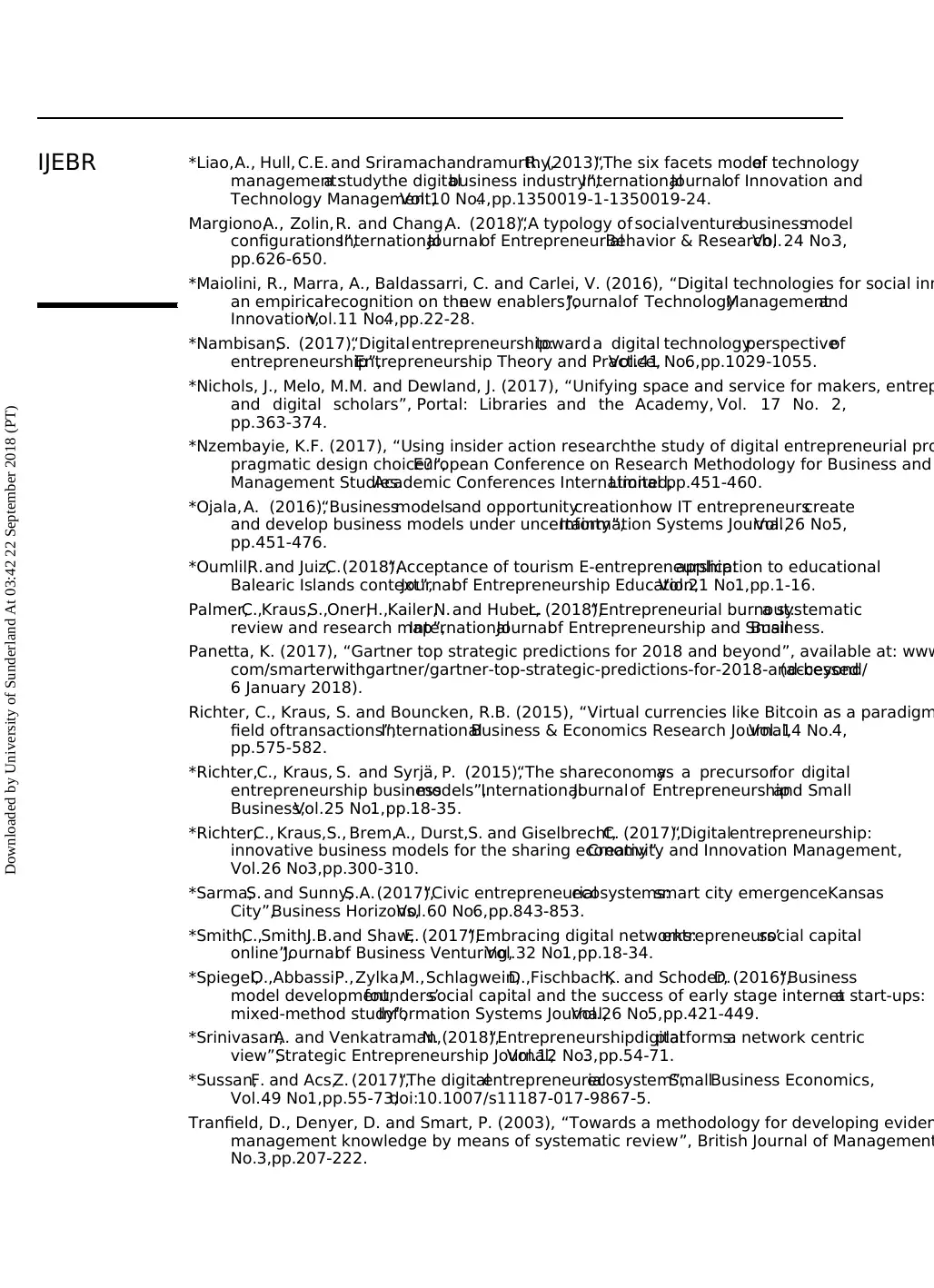
*Liao,A., Hull, C.E. and Sriramachandramurthy,R. (2013),“The six facets modelof technology
management:a studythe digitalbusiness industry”,InternationalJournalof Innovation and
Technology Management,Vol.10 No.4,pp.1350019-1-1350019-24.
Margiono,A., Zolin,R. and Chang,A. (2018),“A typology of socialventurebusinessmodel
configurations”,InternationalJournalof EntrepreneurialBehavior & Research,Vol.24 No.3,
pp.626-650.
*Maiolini, R., Marra, A., Baldassarri, C. and Carlei, V. (2016), “Digital technologies for social inn
an empiricalrecognition on thenew enablers”,Journalof TechnologyManagementand
Innovation,Vol.11 No.4,pp.22-28.
*Nambisan,S. (2017),“Digitalentrepreneurship:toward a digital technologyperspectiveof
entrepreneurship”,Entrepreneurship Theory and Practice,Vol.41 No.6,pp.1029-1055.
*Nichols, J., Melo, M.M. and Dewland, J. (2017), “Unifying space and service for makers, entrep
and digital scholars”, Portal: Libraries and the Academy, Vol. 17 No. 2,
pp.363-374.
*Nzembayie, K.F. (2017), “Using insider action researchthe study of digital entrepreneurial pro
pragmatic design choice?”,European Conference on Research Methodology for Business and
Management Studies.Academic Conferences InternationalLimited,pp.451-460.
*Ojala,A. (2016),“Businessmodelsand opportunitycreation:how IT entrepreneurscreate
and develop business models under uncertainty”,Information Systems Journal,Vol.26 No.5,
pp.451-476.
*Oumlil,R.and Juiz,C.(2018),“Acceptance of tourism E-entrepreneurship:application to educational
Balearic Islands context”,Journalof Entrepreneurship Education,Vol.21 No.1,pp.1-16.
Palmer,C.,Kraus,S.,Oner,H.,Kailer,N.and Huber,L. (2018),“Entrepreneurial burnout:a systematic
review and research map”,InternationalJournalof Entrepreneurship and SmallBusiness.
Panetta, K. (2017), “Gartner top strategic predictions for 2018 and beyond”, available at: www
com/smarterwithgartner/gartner-top-strategic-predictions-for-2018-and-beyond/(accessed
6 January 2018).
Richter, C., Kraus, S. and Bouncken, R.B. (2015), “Virtual currencies like Bitcoin as a paradigm
field oftransactions”,InternationalBusiness & Economics Research Journal,Vol. 14 No.4,
pp.575-582.
*Richter,C., Kraus, S. and Syrjä, P. (2015),“The shareconomyas a precursorfor digital
entrepreneurship businessmodels”,InternationalJournalof Entrepreneurshipand Small
Business,Vol.25 No.1,pp.18-35.
*Richter,C., Kraus,S., Brem,A., Durst,S. and Giselbrecht,C. (2017),“Digitalentrepreneurship:
innovative business models for the sharing economy”,Creativity and Innovation Management,
Vol.26 No.3,pp.300-310.
*Sarma,S. and Sunny,S.A.(2017),“Civic entrepreneurialecosystems:smart city emergenceKansas
City”,Business Horizons,Vol.60 No.6,pp.843-853.
*Smith,C.,Smith,J.B.and Shaw,E. (2017),“Embracing digital networks:entrepreneurs’social capital
online”,Journalof Business Venturing,Vol.32 No.1,pp.18-34.
*Spiegel,O.,Abbassi,P.,Zylka,M.,Schlagwein,D.,Fischbach,K. and Schoder,D. (2016),“Business
model development,founders’social capital and the success of early stage internet start-ups:a
mixed-method study”,Information Systems Journal,Vol.26 No.5,pp.421-449.
*Srinivasan,A. and Venkatraman,N. (2018),“Entrepreneurshipdigitalplatforms:a network centric
view”,Strategic Entrepreneurship Journal,Vol.12 No.3,pp.54-71.
*Sussan,F. and Acs,Z. (2017),“The digitalentrepreneurialecosystem”,SmallBusiness Economics,
Vol.49 No.1,pp.55-73,doi:10.1007/s11187-017-9867-5.
Tranfield, D., Denyer, D. and Smart, P. (2003), “Towards a methodology for developing eviden
management knowledge by means of systematic review”, British Journal of Management
No.3,pp.207-222.
IJEBR
Downloaded by University of Sunderland At 03:42 22 September 2018 (PT)
management:a studythe digitalbusiness industry”,InternationalJournalof Innovation and
Technology Management,Vol.10 No.4,pp.1350019-1-1350019-24.
Margiono,A., Zolin,R. and Chang,A. (2018),“A typology of socialventurebusinessmodel
configurations”,InternationalJournalof EntrepreneurialBehavior & Research,Vol.24 No.3,
pp.626-650.
*Maiolini, R., Marra, A., Baldassarri, C. and Carlei, V. (2016), “Digital technologies for social inn
an empiricalrecognition on thenew enablers”,Journalof TechnologyManagementand
Innovation,Vol.11 No.4,pp.22-28.
*Nambisan,S. (2017),“Digitalentrepreneurship:toward a digital technologyperspectiveof
entrepreneurship”,Entrepreneurship Theory and Practice,Vol.41 No.6,pp.1029-1055.
*Nichols, J., Melo, M.M. and Dewland, J. (2017), “Unifying space and service for makers, entrep
and digital scholars”, Portal: Libraries and the Academy, Vol. 17 No. 2,
pp.363-374.
*Nzembayie, K.F. (2017), “Using insider action researchthe study of digital entrepreneurial pro
pragmatic design choice?”,European Conference on Research Methodology for Business and
Management Studies.Academic Conferences InternationalLimited,pp.451-460.
*Ojala,A. (2016),“Businessmodelsand opportunitycreation:how IT entrepreneurscreate
and develop business models under uncertainty”,Information Systems Journal,Vol.26 No.5,
pp.451-476.
*Oumlil,R.and Juiz,C.(2018),“Acceptance of tourism E-entrepreneurship:application to educational
Balearic Islands context”,Journalof Entrepreneurship Education,Vol.21 No.1,pp.1-16.
Palmer,C.,Kraus,S.,Oner,H.,Kailer,N.and Huber,L. (2018),“Entrepreneurial burnout:a systematic
review and research map”,InternationalJournalof Entrepreneurship and SmallBusiness.
Panetta, K. (2017), “Gartner top strategic predictions for 2018 and beyond”, available at: www
com/smarterwithgartner/gartner-top-strategic-predictions-for-2018-and-beyond/(accessed
6 January 2018).
Richter, C., Kraus, S. and Bouncken, R.B. (2015), “Virtual currencies like Bitcoin as a paradigm
field oftransactions”,InternationalBusiness & Economics Research Journal,Vol. 14 No.4,
pp.575-582.
*Richter,C., Kraus, S. and Syrjä, P. (2015),“The shareconomyas a precursorfor digital
entrepreneurship businessmodels”,InternationalJournalof Entrepreneurshipand Small
Business,Vol.25 No.1,pp.18-35.
*Richter,C., Kraus,S., Brem,A., Durst,S. and Giselbrecht,C. (2017),“Digitalentrepreneurship:
innovative business models for the sharing economy”,Creativity and Innovation Management,
Vol.26 No.3,pp.300-310.
*Sarma,S. and Sunny,S.A.(2017),“Civic entrepreneurialecosystems:smart city emergenceKansas
City”,Business Horizons,Vol.60 No.6,pp.843-853.
*Smith,C.,Smith,J.B.and Shaw,E. (2017),“Embracing digital networks:entrepreneurs’social capital
online”,Journalof Business Venturing,Vol.32 No.1,pp.18-34.
*Spiegel,O.,Abbassi,P.,Zylka,M.,Schlagwein,D.,Fischbach,K. and Schoder,D. (2016),“Business
model development,founders’social capital and the success of early stage internet start-ups:a
mixed-method study”,Information Systems Journal,Vol.26 No.5,pp.421-449.
*Srinivasan,A. and Venkatraman,N. (2018),“Entrepreneurshipdigitalplatforms:a network centric
view”,Strategic Entrepreneurship Journal,Vol.12 No.3,pp.54-71.
*Sussan,F. and Acs,Z. (2017),“The digitalentrepreneurialecosystem”,SmallBusiness Economics,
Vol.49 No.1,pp.55-73,doi:10.1007/s11187-017-9867-5.
Tranfield, D., Denyer, D. and Smart, P. (2003), “Towards a methodology for developing eviden
management knowledge by means of systematic review”, British Journal of Management
No.3,pp.207-222.
IJEBR
Downloaded by University of Sunderland At 03:42 22 September 2018 (PT)
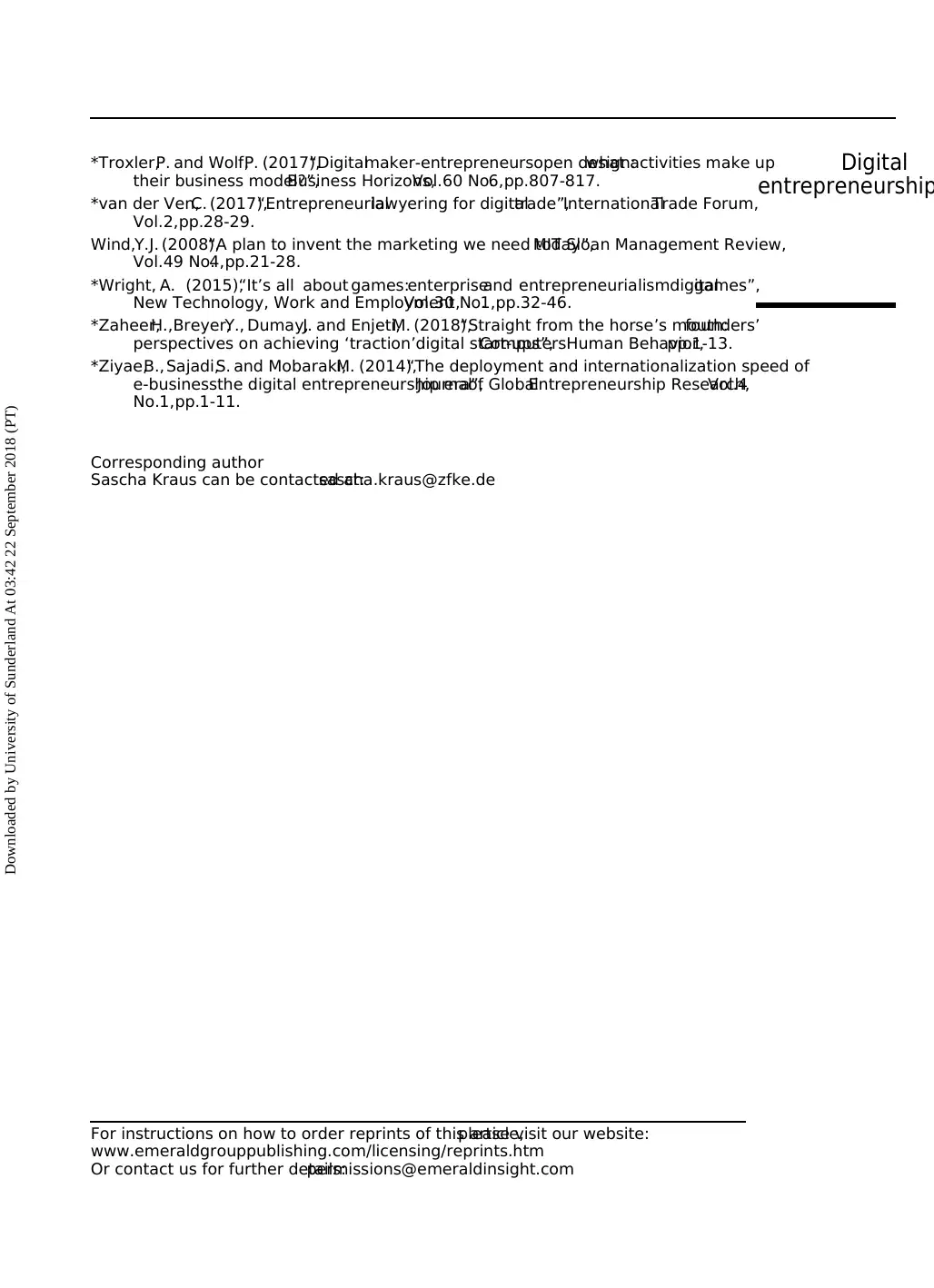
*Troxler,P. and Wolf,P. (2017),“Digitalmaker-entrepreneursopen design:what activities make up
their business model?”,Business Horizons,Vol.60 No.6,pp.807-817.
*van der Ven,C. (2017),“Entrepreneuriallawyering for digitaltrade”,InternationalTrade Forum,
Vol.2,pp.28-29.
Wind,Y.J. (2008),“A plan to invent the marketing we need today”,MIT Sloan Management Review,
Vol.49 No.4,pp.21-28.
*Wright, A. (2015),“It’s all about games:enterpriseand entrepreneurialismdigitalgames”,
New Technology, Work and Employment,Vol.30 No.1,pp.32-46.
*Zaheer,H.,Breyer,Y., Dumay,J. and Enjeti,M. (2018),“Straight from the horse’s mouth:founders’
perspectives on achieving ‘traction’digital start-ups”,ComputersHuman Behavior,pp.1-13.
*Ziyae,B., Sajadi,S. and Mobaraki,M. (2014),“The deployment and internationalization speed of
e-businessthe digital entrepreneurship era”,Journalof GlobalEntrepreneurship Research,Vol.4
No.1,pp.1-11.
Corresponding author
Sascha Kraus can be contacted at:sascha.kraus@zfke.de
For instructions on how to order reprints of this article,please visit our website:
www.emeraldgrouppublishing.com/licensing/reprints.htm
Or contact us for further details:permissions@emeraldinsight.com
Digital
entrepreneurship
Downloaded by University of Sunderland At 03:42 22 September 2018 (PT)
their business model?”,Business Horizons,Vol.60 No.6,pp.807-817.
*van der Ven,C. (2017),“Entrepreneuriallawyering for digitaltrade”,InternationalTrade Forum,
Vol.2,pp.28-29.
Wind,Y.J. (2008),“A plan to invent the marketing we need today”,MIT Sloan Management Review,
Vol.49 No.4,pp.21-28.
*Wright, A. (2015),“It’s all about games:enterpriseand entrepreneurialismdigitalgames”,
New Technology, Work and Employment,Vol.30 No.1,pp.32-46.
*Zaheer,H.,Breyer,Y., Dumay,J. and Enjeti,M. (2018),“Straight from the horse’s mouth:founders’
perspectives on achieving ‘traction’digital start-ups”,ComputersHuman Behavior,pp.1-13.
*Ziyae,B., Sajadi,S. and Mobaraki,M. (2014),“The deployment and internationalization speed of
e-businessthe digital entrepreneurship era”,Journalof GlobalEntrepreneurship Research,Vol.4
No.1,pp.1-11.
Corresponding author
Sascha Kraus can be contacted at:sascha.kraus@zfke.de
For instructions on how to order reprints of this article,please visit our website:
www.emeraldgrouppublishing.com/licensing/reprints.htm
Or contact us for further details:permissions@emeraldinsight.com
Digital
entrepreneurship
Downloaded by University of Sunderland At 03:42 22 September 2018 (PT)
1 out of 24
Your All-in-One AI-Powered Toolkit for Academic Success.
+13062052269
info@desklib.com
Available 24*7 on WhatsApp / Email
![[object Object]](/_next/static/media/star-bottom.7253800d.svg)
Unlock your academic potential
© 2024 | Zucol Services PVT LTD | All rights reserved.